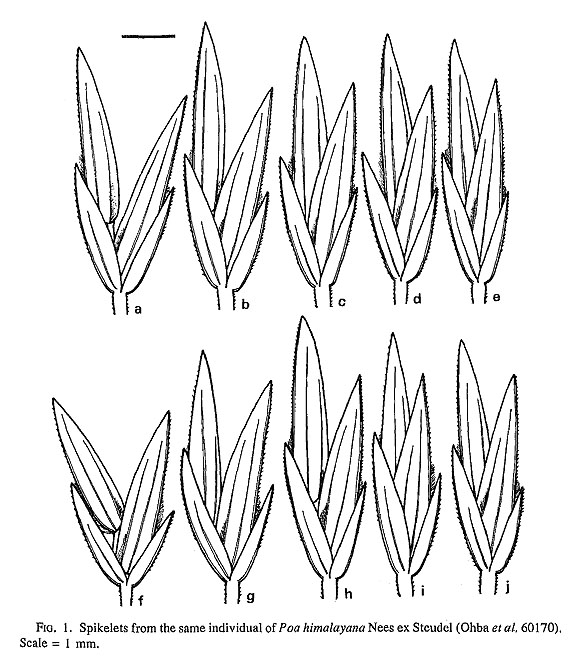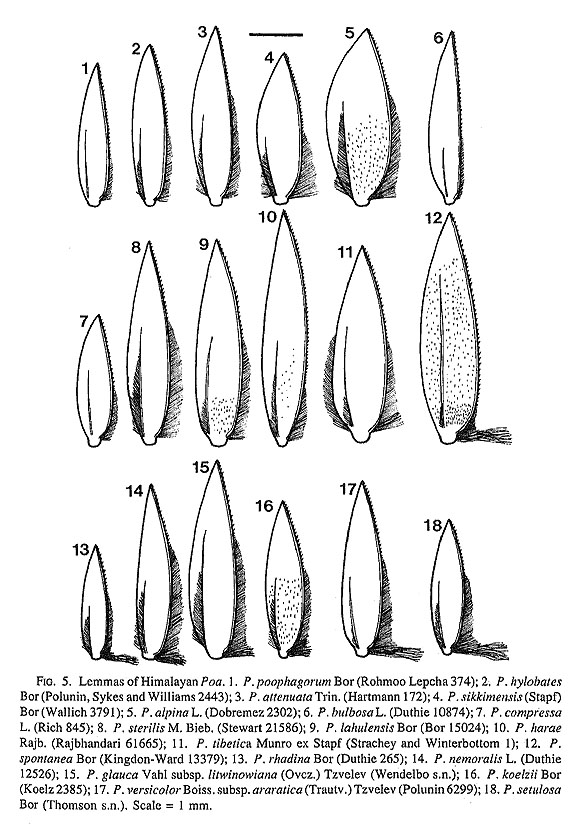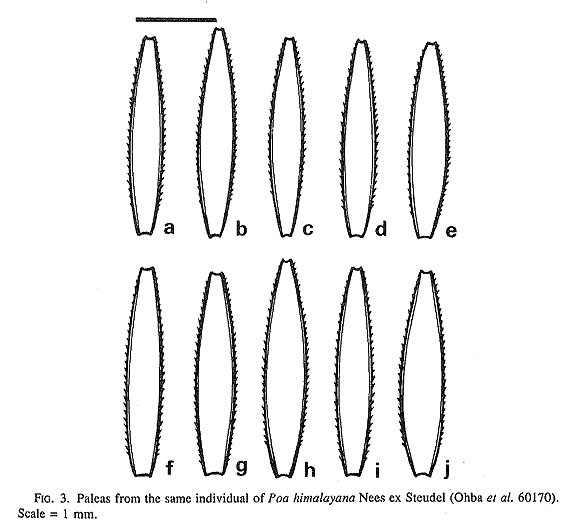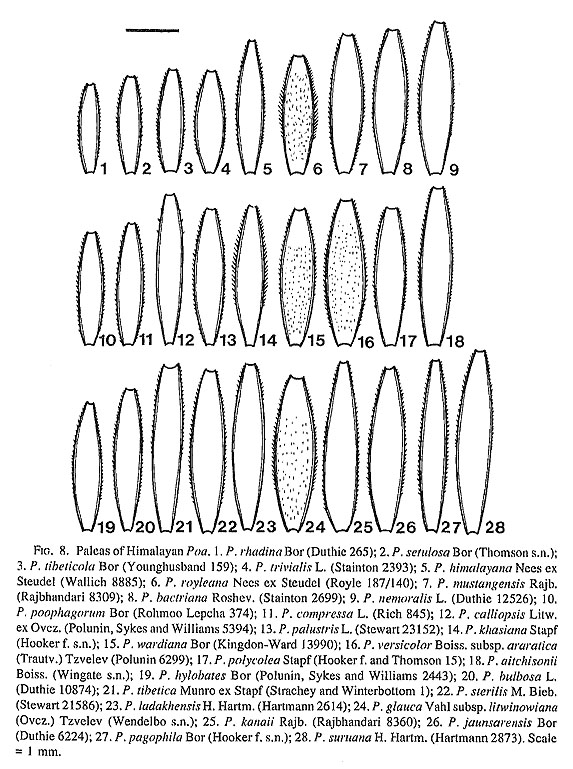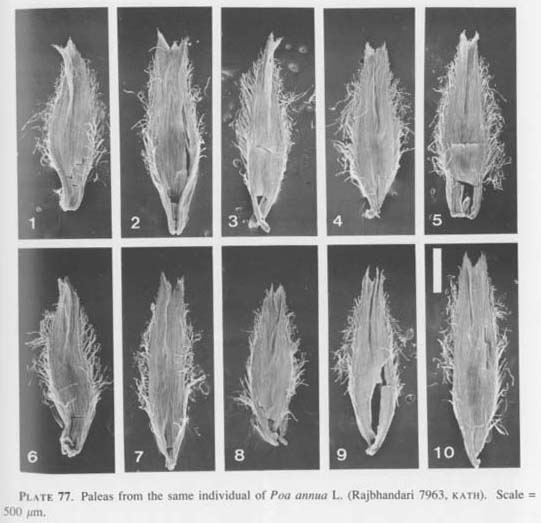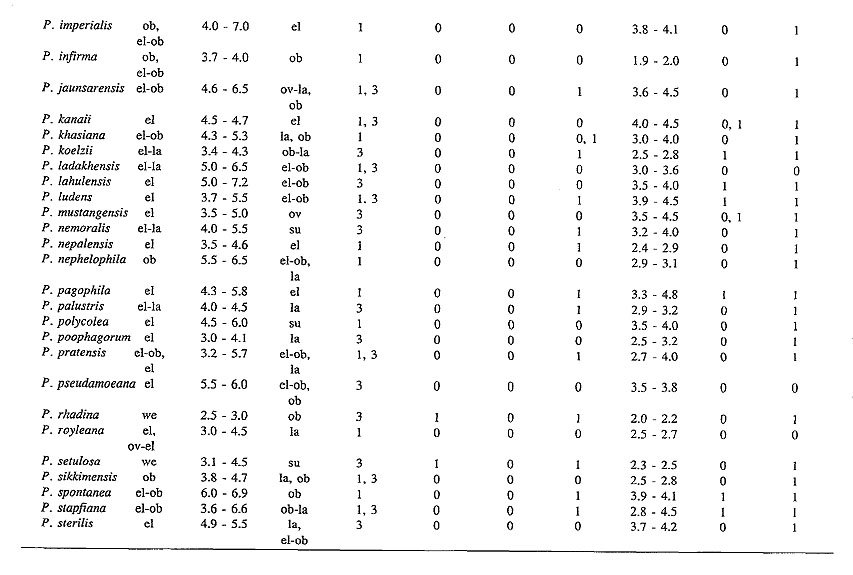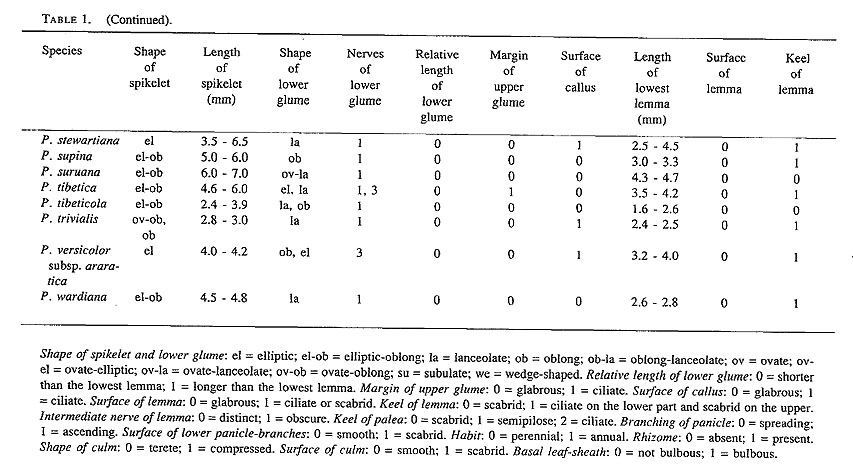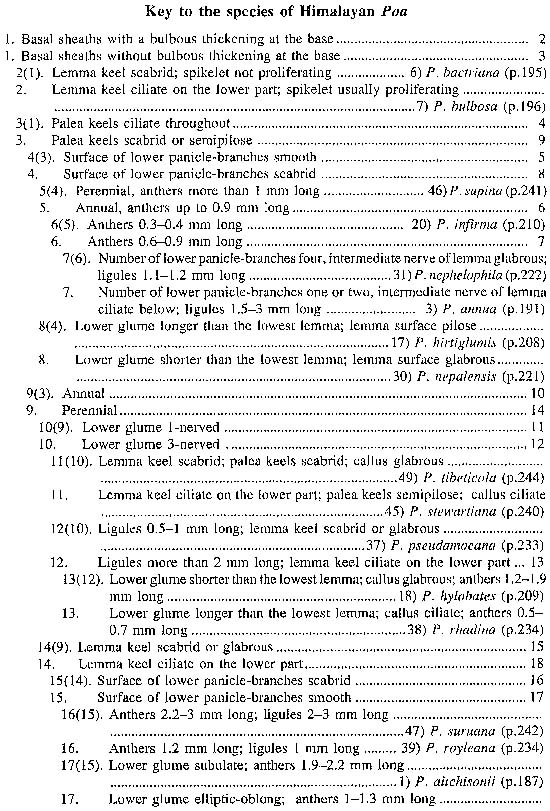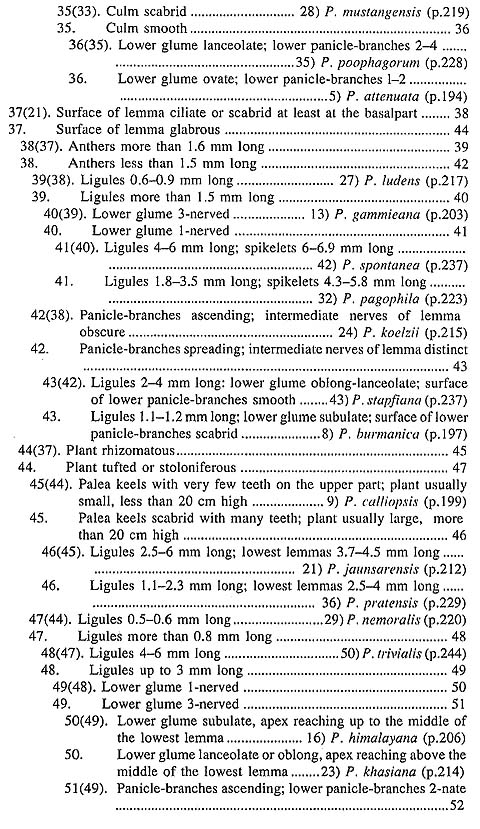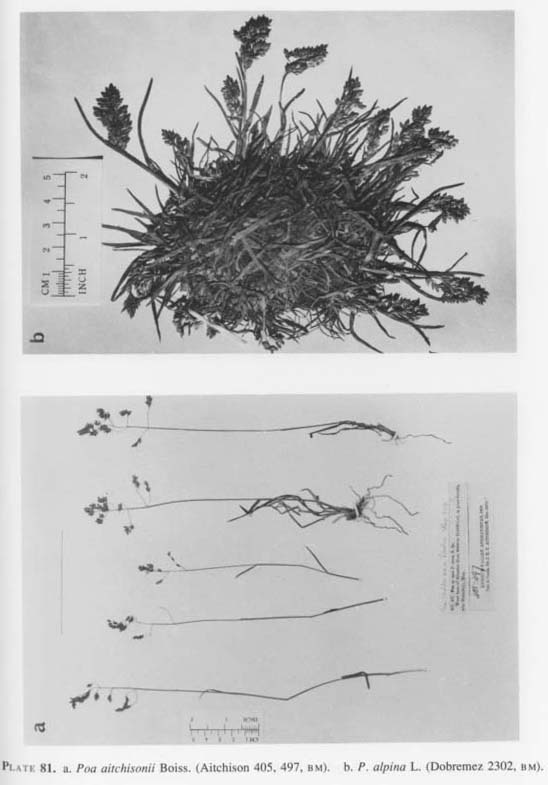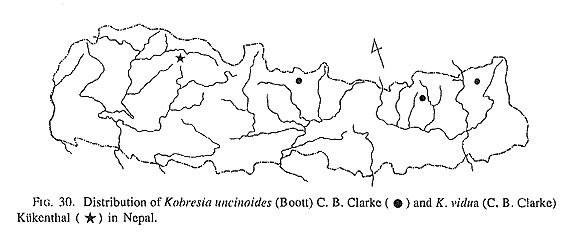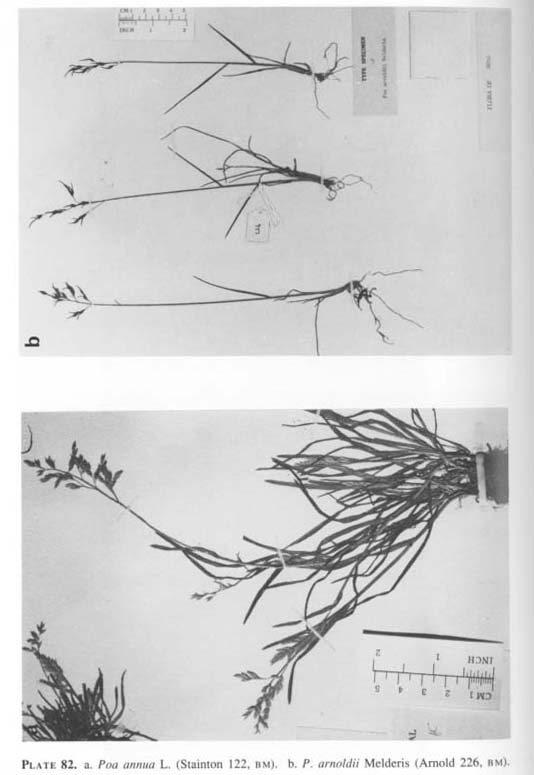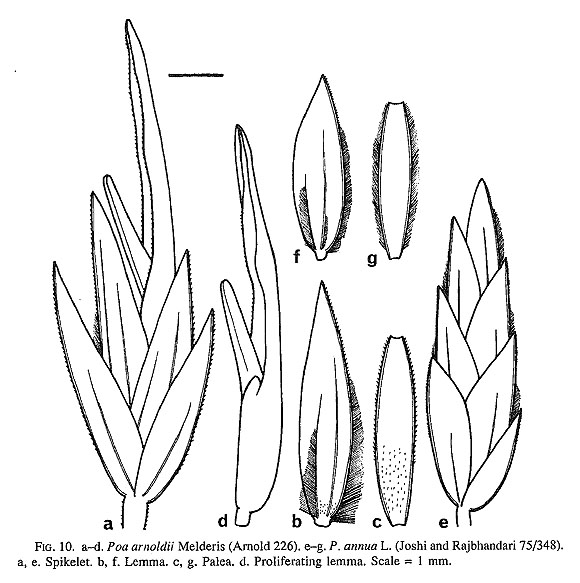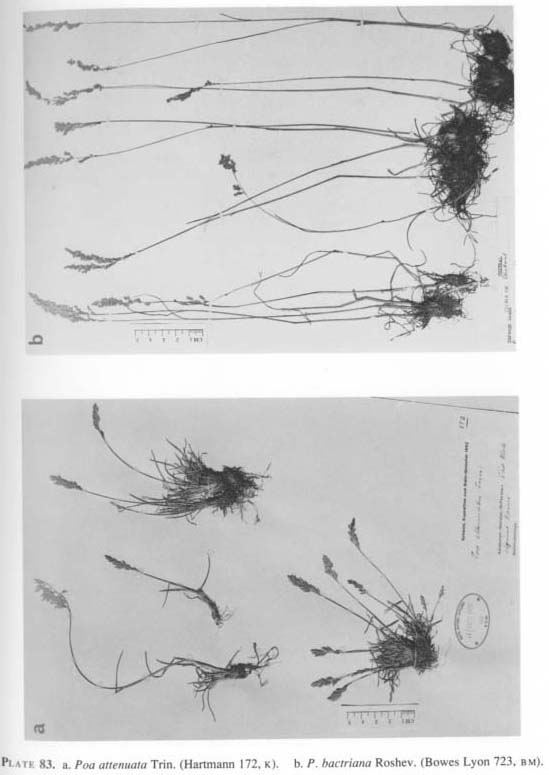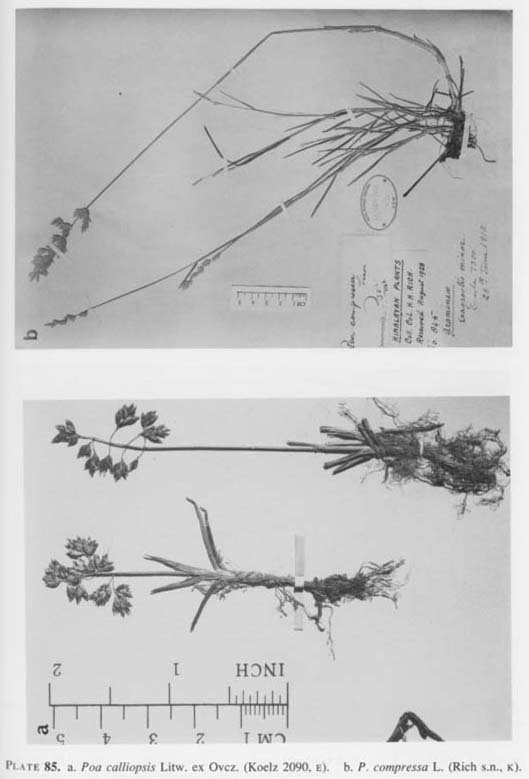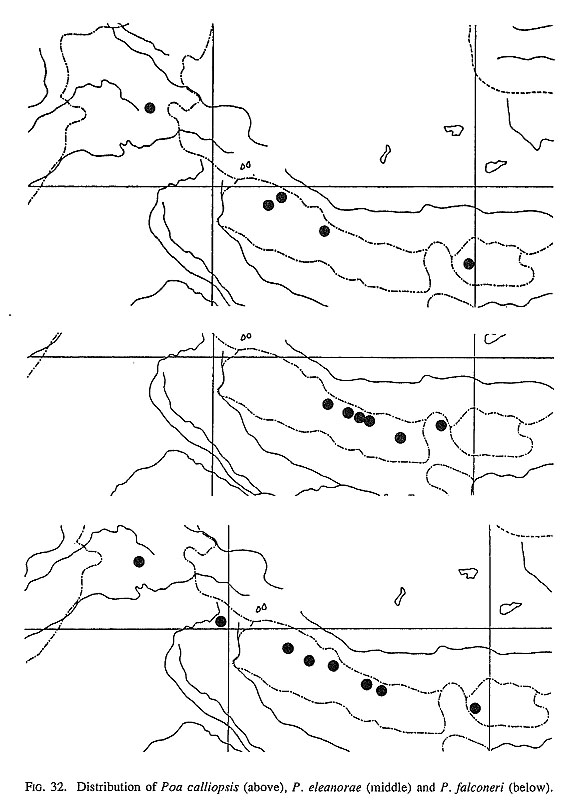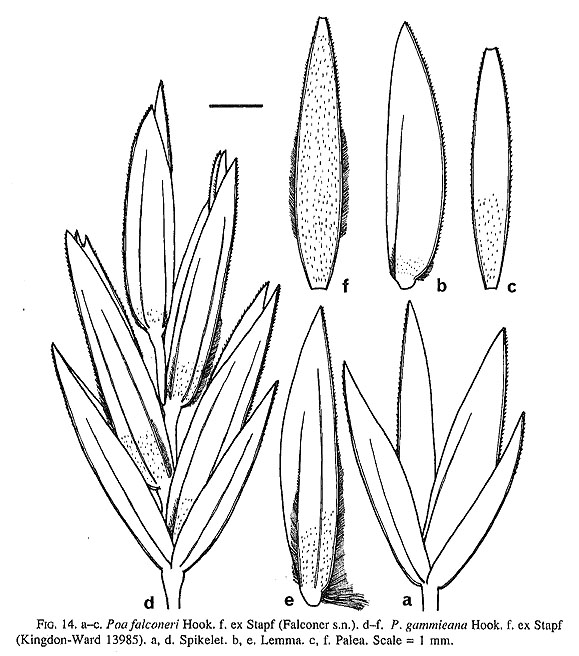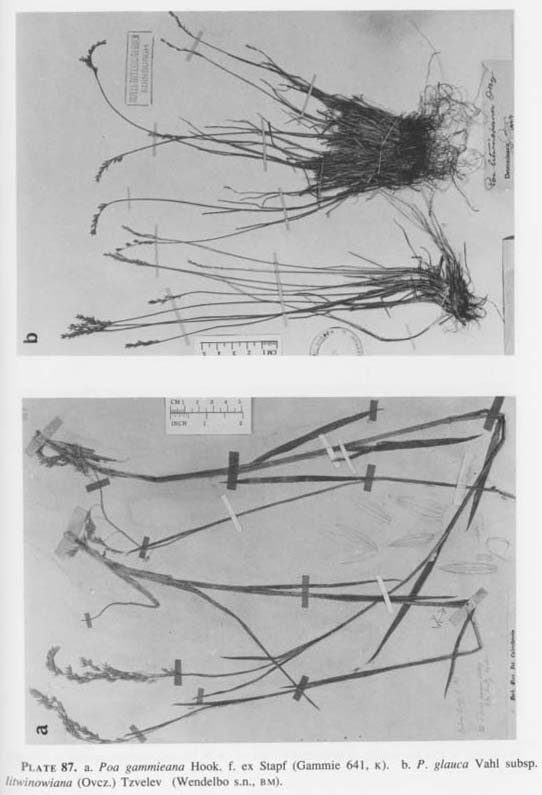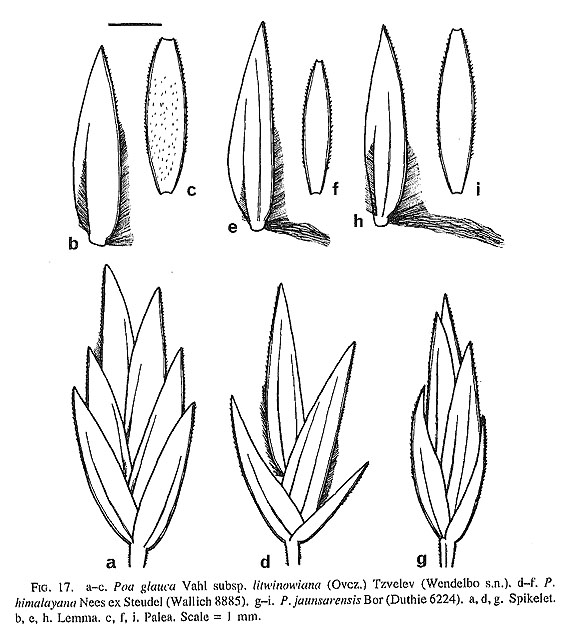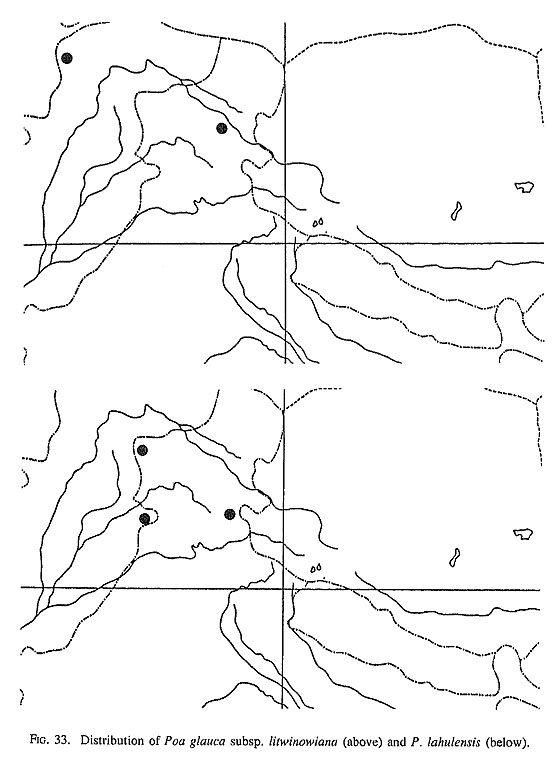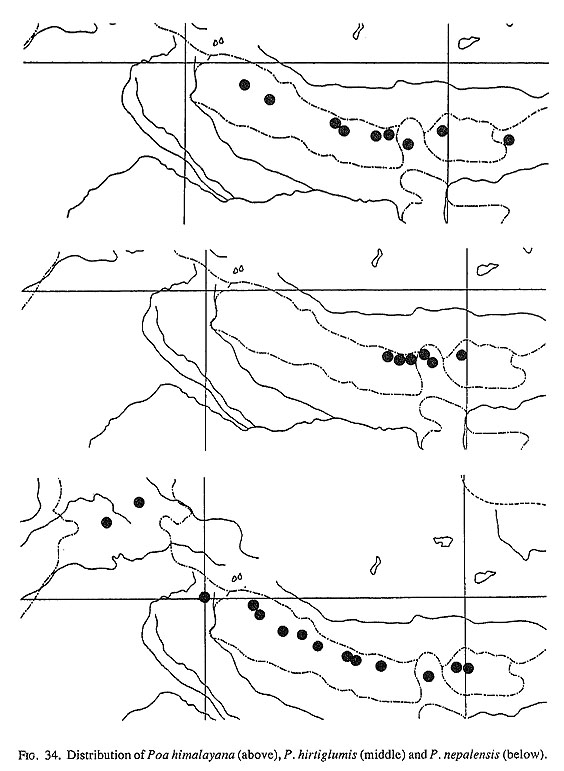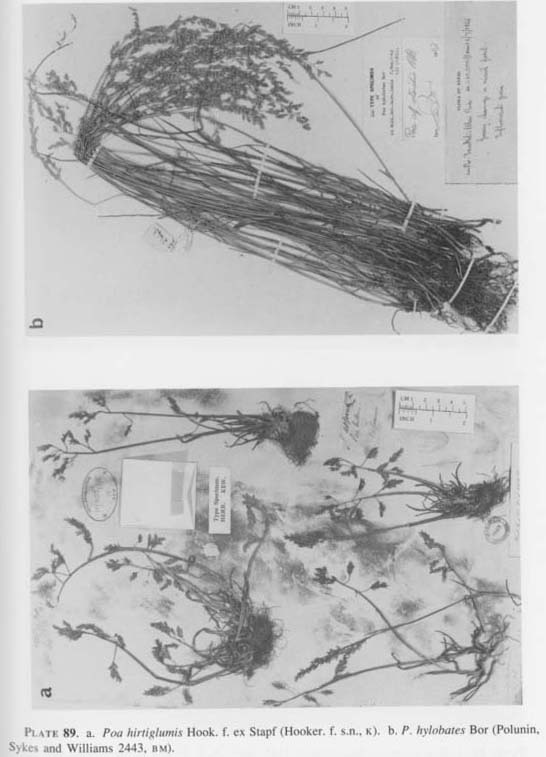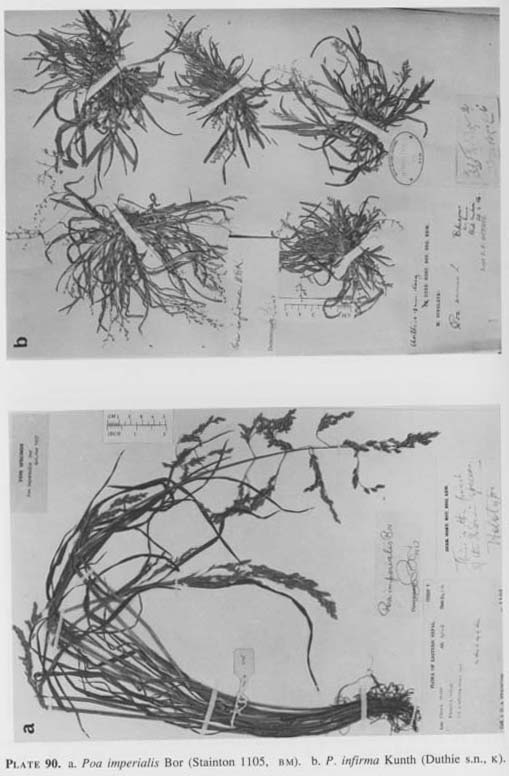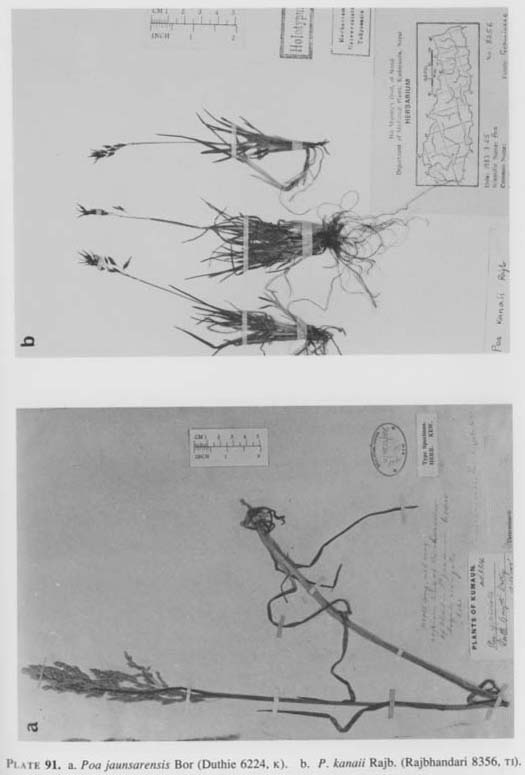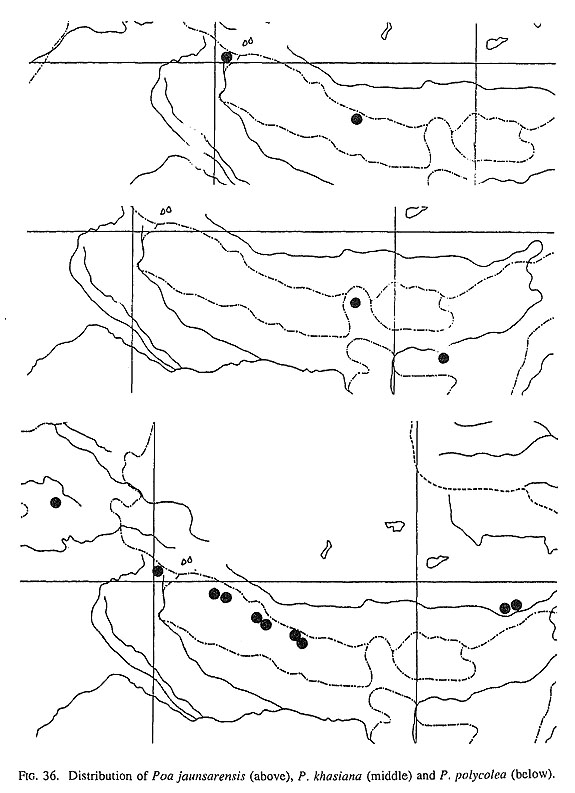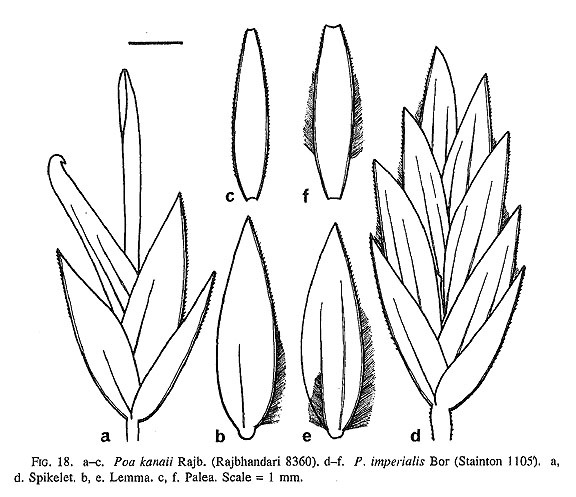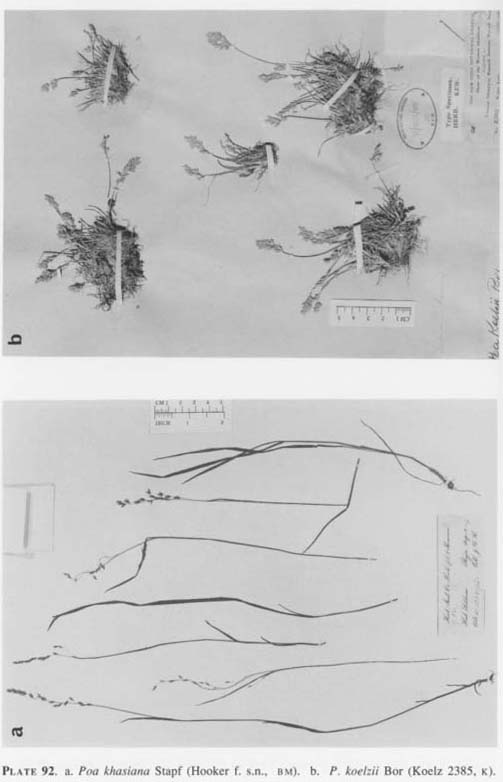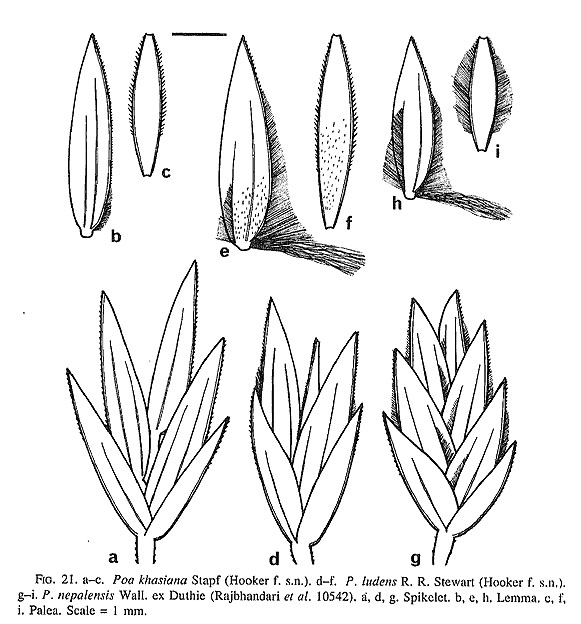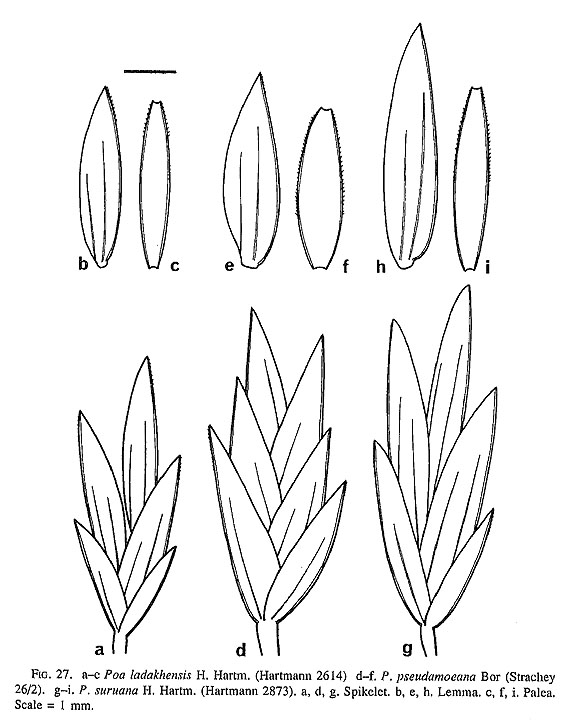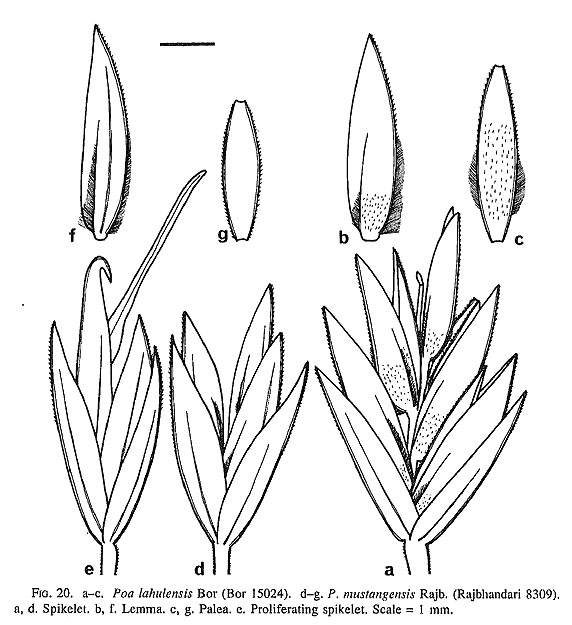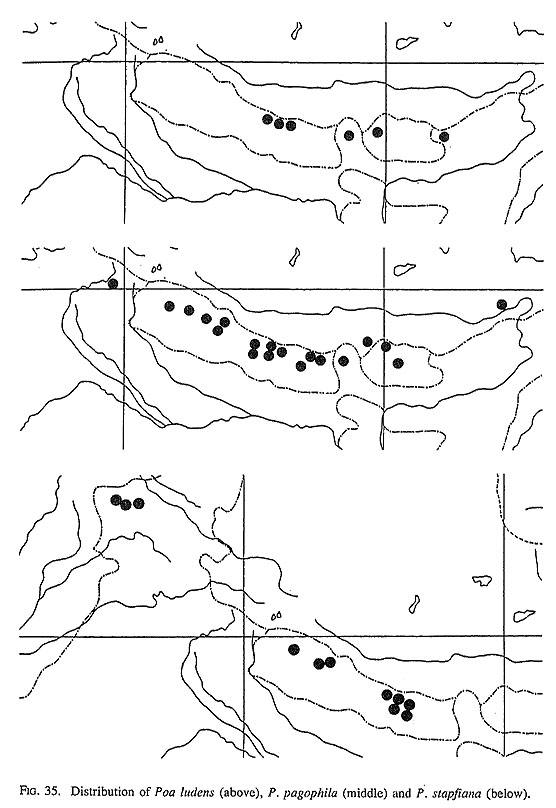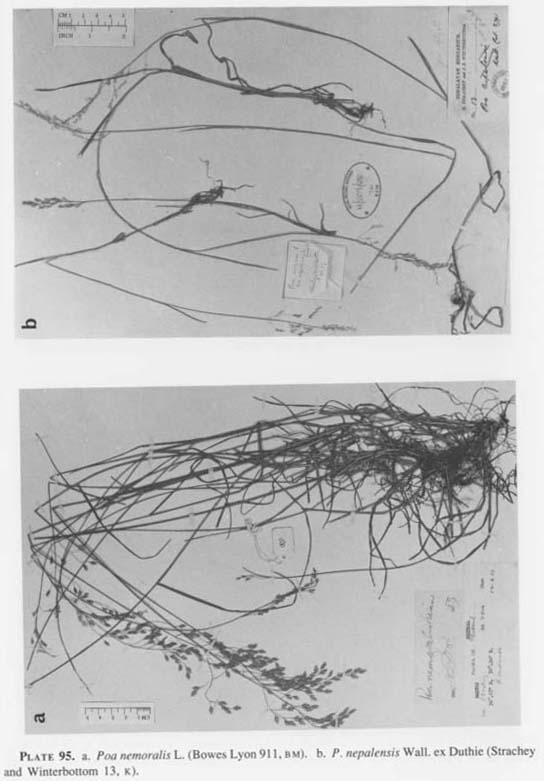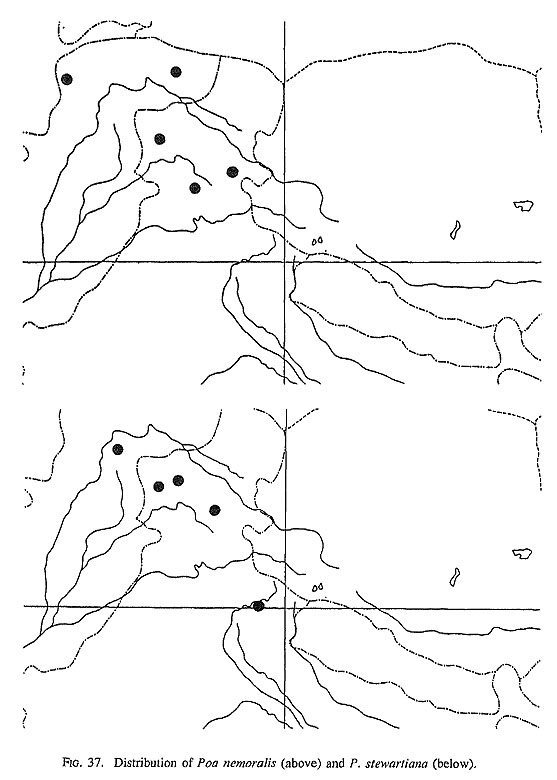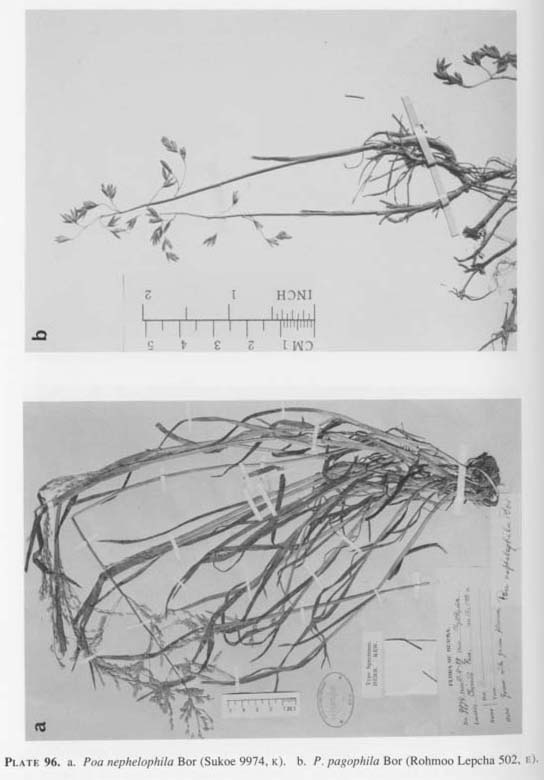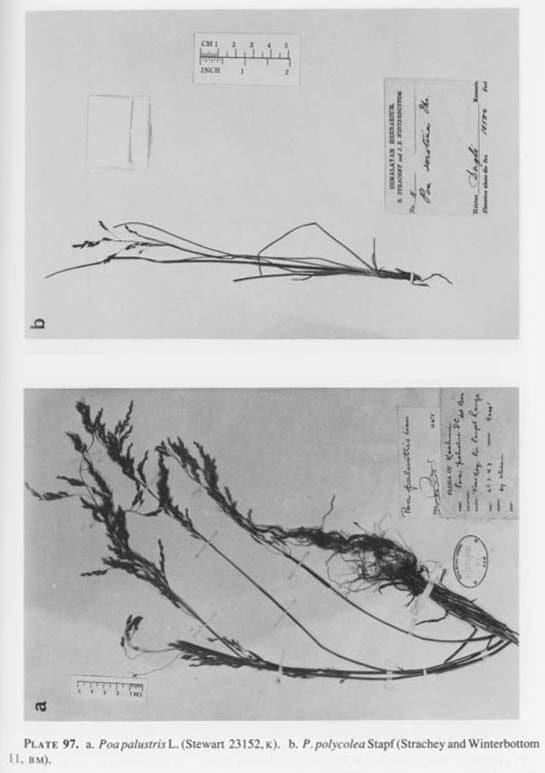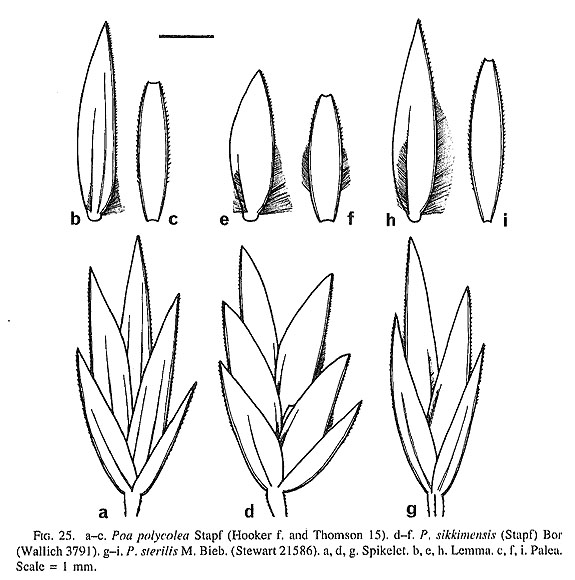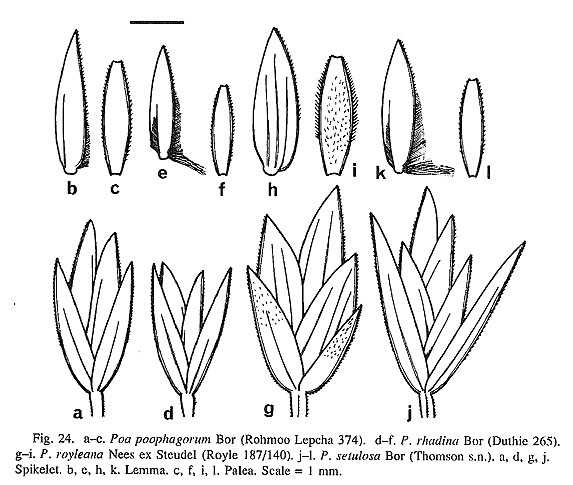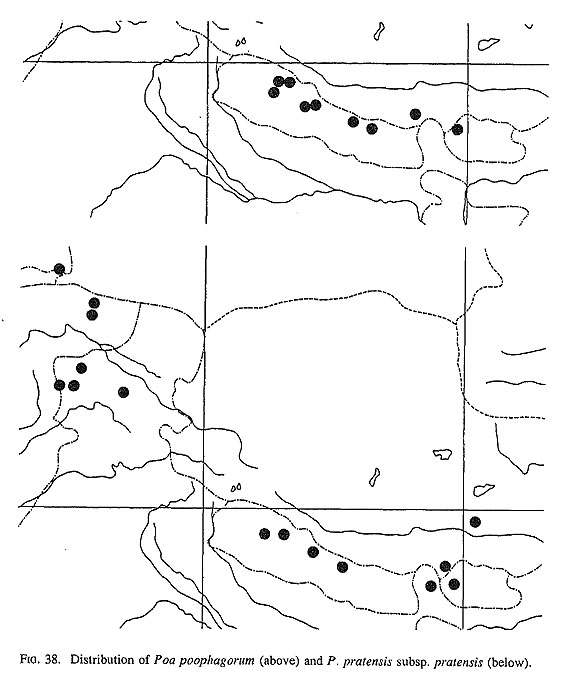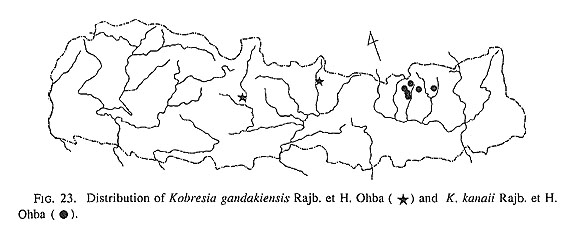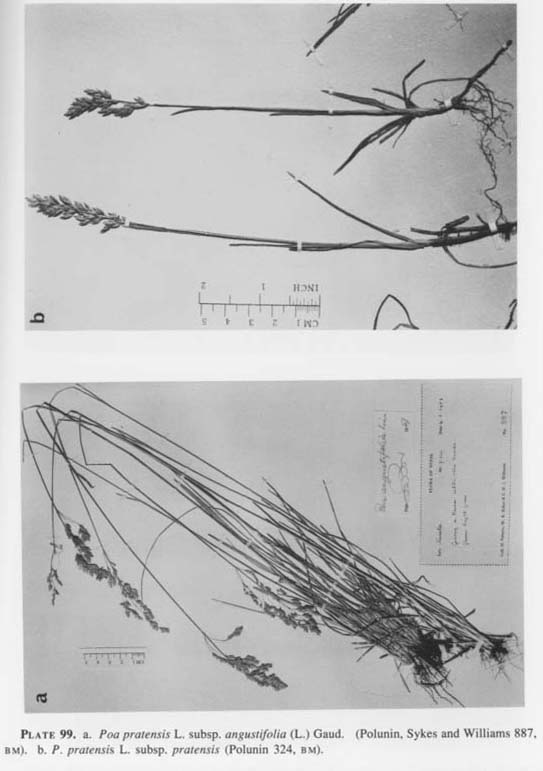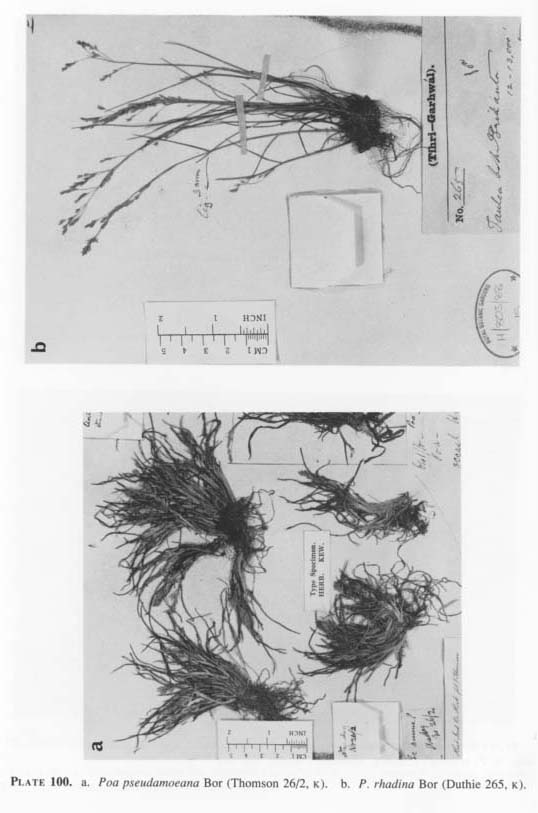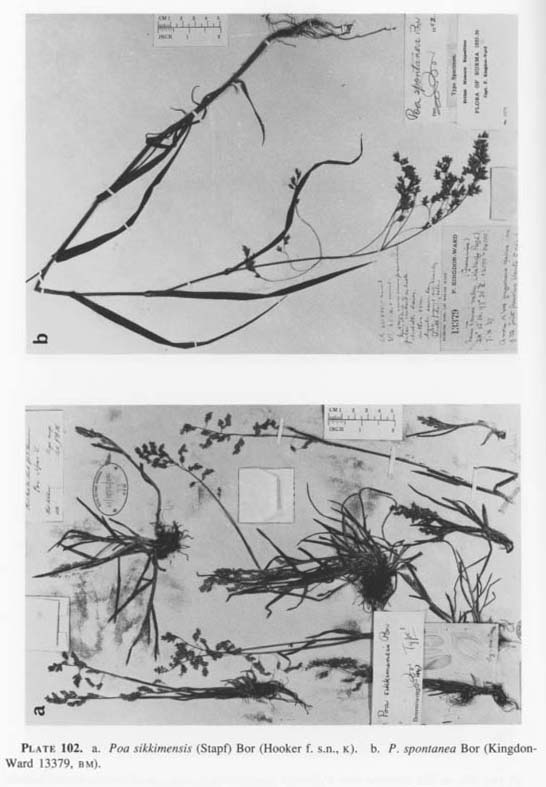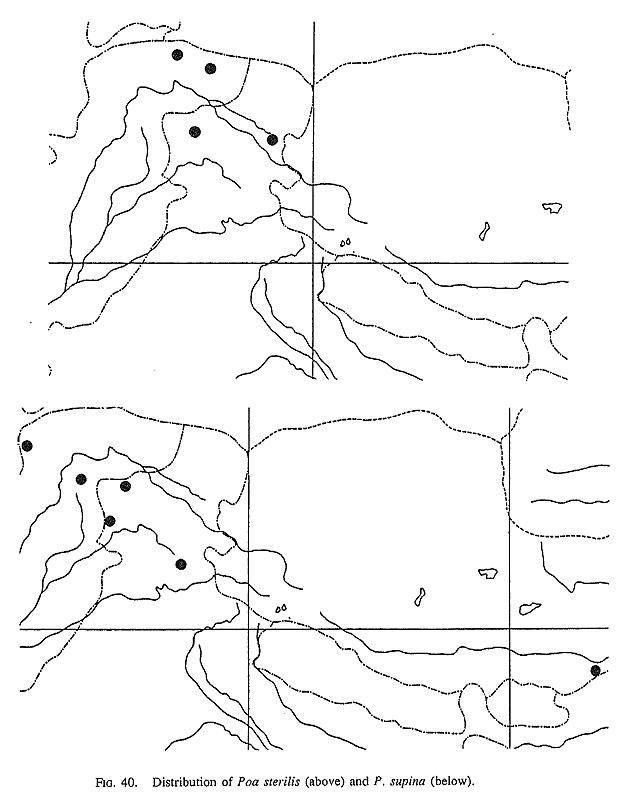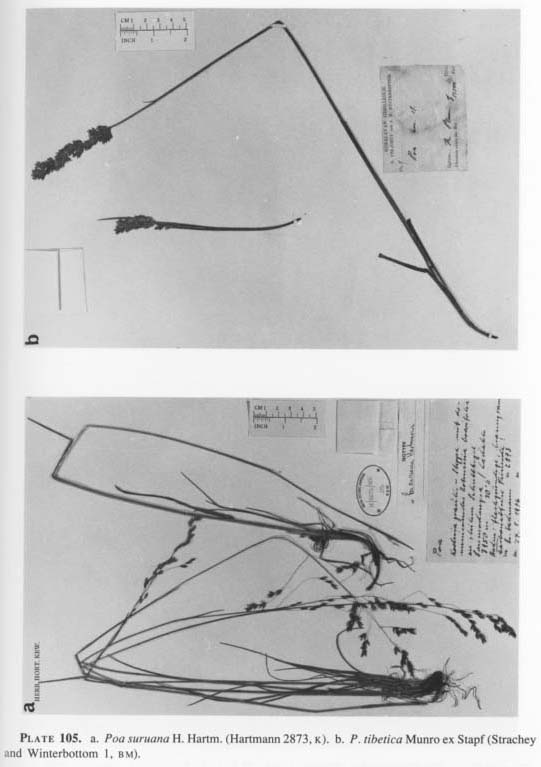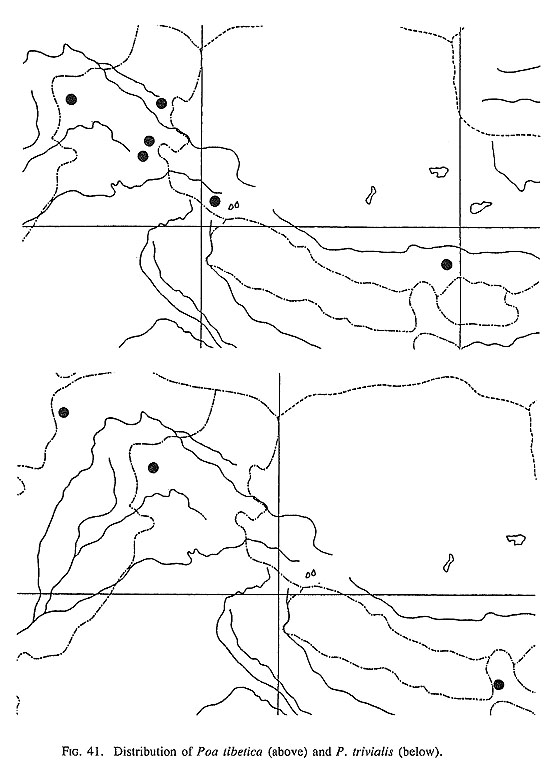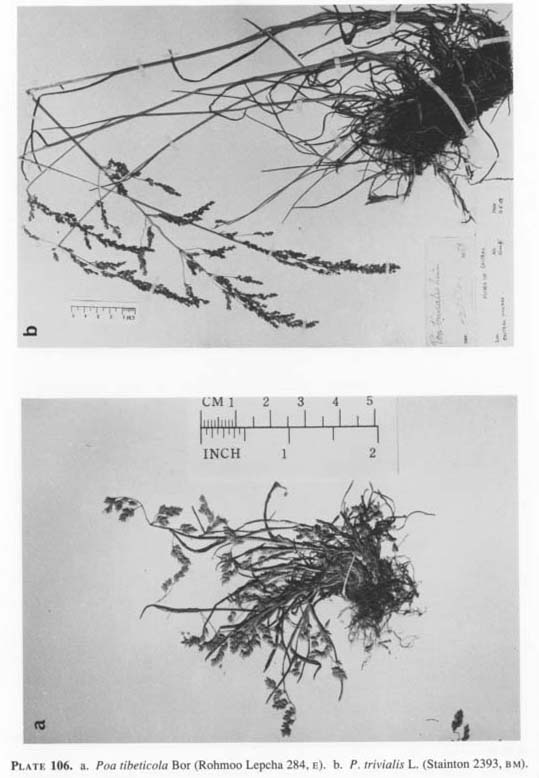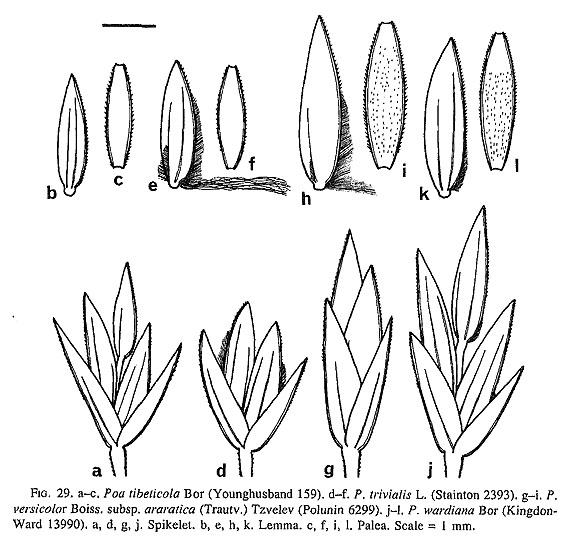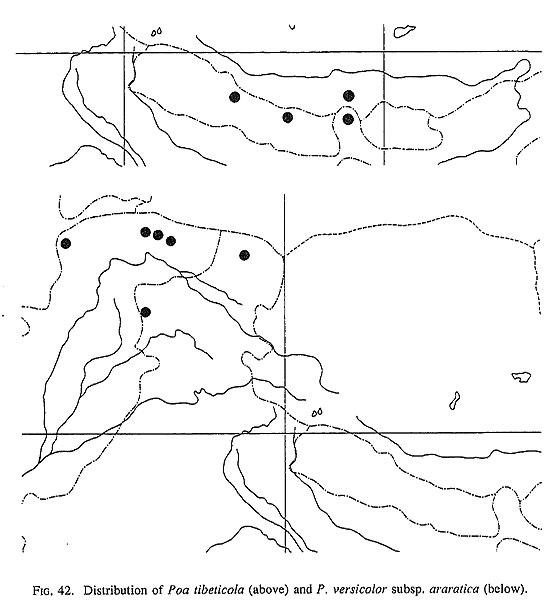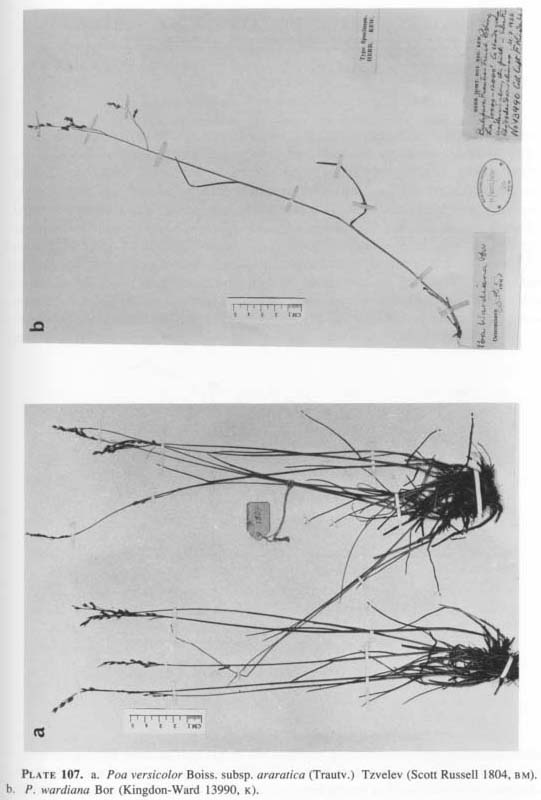A REVISION OF THE GENUS POA L. (GRAMINEAE) IN THE HIMALAYA
|
Poa L. is the largest genus among the grasses of Himalaya and is commonly distributed in the alpine region. Despite its commonness in the Himalaya not much taxonomic works have been done on it. Stapf in 1896 studied it for Hooker's 'Flora of British India, after a long gap Bor studied it in 1948 describing 11 species, and revising Indian Poa including Himalayan species in 1952. However, the Himalayan Poa have not been successfully circumscribed nor distinguished from each other, and thus they have been much confused even in the recent publications. This is due to the insufficiency of the knowledge on the variation of morphological characters of each species as well as the lack of enough materials. The present author has been collecting the specimens of Poa since 1975 from various parts of Nepal. Based on these specimens and the specimens borrowed from various herbaria a taxonomic study of Himalayan Poa is undertaken. The purpose of the study is to revise the Himalayan species of Poa on the basis of reliable morphological characters in order to improve their present taxonomic knowledge. This study was based on the herbarium specimens including types of the Himalayan species. Field trips were carried out in Nepal for a number of times from 1975 to 1985 and specimens of Poa were collected during these trips. Besides my own collections the specimens belonging to the following herbaria were examined for the present study: To make clear the range of phenotypic plasticity, ten mature spikelets from a single individual of P. himalayana were observed. The variation of the shapes and sizes of the inflorescences, spikelets, glumes, lemmas, paleas and anthers, number and surface of panicle-branches and callus character were observed. The observation of the floral parts, such as glumes, lemmas, paleas and anthers, was done from the lowest floret of the spikelet, because it is the largest in the spikelet. Besides the shape and size, hairiness of various parts of the plants were also observed. To study the spikelets and their parts they were boiled in water for few minutes and dissected under a binocular microscope attached with camera lucida. The lemmas and paleas of P. annua and P. bactriana and the culms and panicle-branches of some species were studied under a scanning electron microscope. Genus Poa L., Sp. Pl. ed. 1, 67 (1753). Annual or perennial, densely or loosely tufted, stoloniferous or rhizomatous. Culms usually geniculate, or erect from base, terete or compressed, smooth or scabrid on the whole part or below the inflorescence, with two to five nodes. Leaf-blades linear or setaceous, apex hooded acute or acuminate, flat or folded, firm or flaccid, margins and surfaces glabrous or scabrid, longer or shorter than sheaths. Ligules membranous, apex acute, obtuse or round, 0.5 mm to 6 mm long, outer surface smooth or scabrid. Leaf-sheaths round or compressed, glabrous or scabrid abaxially, basal sheaths bulbous or not. Panicle linear, elliptic, ovate or pyramidal in shape; axis smooth or scabrid, terete or striate; branches ascending, spreading or reflexed, lower branches 1 to 5, surface smooth or scabrid; pedicels smooth or scabrid. Spikelets 2-7-flowered, elliptic, ovate or wedge-shaped, 2.4 mm to 9.2 mm long, green or purplish. Glumes subequal or equal, elliptic, ovate or subulate, apex acute, acuminate or obtuse, surface glabrous or scabrid on the whole part or on the upper part, keeled, scabrid on keel, lower glume shorter or sometimes longer than the lowest lemma, 1 - or 3-nerved, upper glume 3-nerved, margin glabrous or rarely ciliate. Rachilla smooth, warty or hairy, uppermost with a rudimentary floret. Callus at base of floret glabrous or ciliate with long or short fine cottony hairs. Lemmas elliptic, ovate or oblong, apex acute or obtuse, 1.6 mm to 6 mm long, 5-nerved, rarely 7-nerved, keeled, outer surface between keel and lateral nerves glabrous, scabrid or ciliate, keel glabous or ciliate in lower half and scabrid above or entirely scabrid, rarely smooth, intermediate nerves between keel and marginal nerves distinctly visible or obscure, glabrous, scabrid or ciliate, marginal nerves distinct, glabrous, scabrid or ciliate, green or purplish, margin hyaline or not; when seen in SEM longitudinal cells with sinuate walls, numerous hooks, sometimes prickles and macrohairs, rarely silica cells present on the surface. Paleas elliptic-oblong or oblong, shorter than lemmas or rarely longer, 1.4 mm to 5.5 mm long, membranous, 2-keeled, outer surface (between the keels) glabrous, scabrid or ciliate, keel scabrid, ciliate throughout or semipilose with ciliate hairs on lower half and scabrid above, rarely only few scabrid hairs on the upper part, lower part smooth; longitudinal cells with sinuate walls, numerous hooks, sometimes prickles, macrohairs and stomata along keels present on the surface, hooks sometimes very few or absent in SEM. Lodicules 2, hyaline, glabrous, unequally 2-lobed or 2-toothed. Stamens 3; filaments slender, smooth; anthers linear, 0.3 mm to 3.0 mm long. Ovary glabrous; styles 2, short; stigmas plumose; ovule single, attached to the wall. Grain linear. Hilum round to oval. Spikelets sometimes proliferating with upper florets transformed into leafy propagules. Type species: P. pratensis L. Species about 500. Temperate to alpine regions throughout the world. The shape of spikelets in Himalayan Poa is specifically constant. Ten spikelets of a single individual of Poa himalayana were constantly oblong (Fig. 1). The callus is an enlarged knob-like structure occurring at the base of the floret. The surface of callus is found to be glabrous or covered with long ciliate hairs which are variously termed as web or wool. The glabrous or ciliate state is constant except in P. bulbosa, P. compressa, P. eleanorae, P. harae and P. khasiana. In these five species both states occur. The callus character has received much attention in other regions also, e.g. Edgar (1986) finds it as a quite reliable diagnostic character for New Zealand Poa. However, in case of the Himalayan Poa, the character has exception and can not be applied to all the species.
The nerve, surface and keel characters of lemmas are shown in Figs. 4, 5 and 6. The lemmas have five nerves, the central nerve being the keel nerve and two pairs of lateral nerves, one pair of which is marginal nerves and one pair is the intermediate nerves between the keel and marginal nerves (Fig. 2). Poa royleana has the lowest lemmas with 7 nerves. The marginal nerves of lemma are distinctly visible, while the intermediate ones are either distinctly visible or obscure. Except P. calliopsis, P. harae and P. nepalensis, whether the intermediate nerves are distinct or obscure are constant.
The keel is covered with only scabrid or ciliate hairs on the lower part and scabrid hairs on the upper. The ciliate hairs are usually up to the middle from the base of the keel. Sometimes the ciliate hairs are found only on the basal one-third or onefourth part, and the upper remaining part is covered with scabrid hairs. The surface between the keel and lateral nerves is glabrous or covered with ciliate or scabrid hairs. In the ten lemmas of P. himalayana, P. annua and P. bactriana taken from each individual, the surface is always glabrous (Plates 75 & 76, Fig. 2). The surface of P. alpina, P. arnoldii, P. burmanica, P.falconeri, P. gammieana, P. hirtiglumis, P. koelzii, P. lahulensis, P. ludens, P. pagophila, P. spontanea and P. stapfiana is always covered with ciliate or scabrid hairs. However, in P. eleanorae, P. harae, P. kanaii and P. mustangensis the lemmas are glabrous or hairy.
When the surface of the lemma is examined under a scanning electron microscope it reveals the presence of rectangular long cells with sinuate anticlinal walls, numerous hooks, sometimes prickles and macrohairs. Silica cells are present in P. bulbosu. The presence of numerous hooks gives the granular appearance to the surface (Rajbhandari, 1990). The palea is 2-nerved and keeled on the nerves with two flaps on each side of the keel. Three types of palea-keels are found, scabrid, ciliate and semi-pilose. The palea-keel characters are shown in Figs. 7 and 8. In the ten paleas taken from each individual, the keels of palea are constantly scabrid in P. himalayana (Fig. 3) and P. bactriana (Plate 78), and ciliate in P. annua (Plate 77). In P. gammieana and P. stapfiana, however, they show variations at individual level. The outer surface between the keels of palea is glabrous, scabrid or ciliate. Under a scanning electron microscope, like that of lemma, the outer surface of palea reveals the presence of longitudinal long cells with sinuate anticlinal walls, numerous hooks, sometimes prickles and macrohairs, but not papillae. Stomata are also commonly found along the keel. In P. annua and P. infirma, hooks are very few or absent (Rajbhandari, 1990).
Two types of branching pattern are found, effuse with spreading and sometimes reflexed branches, and contracted with ascending ones. The branching pattern, which was studied in well-flowering state during or after anthesis, is constant except P. bulbosa, P. kanaii and P. pratensis. The surface of panicle-branches and culms is either smooth or scabrid (Plates 79 & 80).
The variations of various morphological characters of the Himalayan species are given in Table 1. The states of the following characters are stable or narrow in range of variation.
Shape of spikelet Length of spikelet Shape of lower glume Nerves of lower glume: 3 or 1 Relative length of lower glume with the lowest lemma: shorter or longer than the lowest lemma Margin of upper glume: glabrous or ciliate Surface of callus: glabrous or ciliate Length of lemma Surface of lemma; glabrous, ciliate or scabrid Keel of lemma: scabrid or ciliate below Intermediate nerve of lemma: distinct or obscure Keel of palea: scabrid, semipilose or ciliate throughout Length of anther Branching of inflorescence: spreading or ascending Number of lower panicle-branches Surface of lower panicle-branches: smooth or scabrid Habit: perennial or annual Rhizome: absent or present Shape of culm: terete or compressed Surfacr of culm: smooth or scabrid Basal leaf-sheath: bulbous or not Length of ligule
1) Poa aitchisonii Boiss., Fl. Orient. 5: 602 (1884)-Bor in J. Bomb. Nat. Hist. Soc. 50: 835 (1952); Grass. Ind. 554 (1960)-Cope in Nasir & Ali, Fl. Pak. 143: 414 (1982). [Plate 81a; Figs. 9a-c, 30]
Perennial, tufted. Culms 14-27 cm tall, geniculate below, terete, smooth. Leafblades linear, acuminate, 2-8 cm long, 2-4 mm wide, flat, surfaces and margins scabrid. Sheaths glabrous. Ligules 0.8-1 mm long, outer surface minutely scabrid. Panicle lanceolate, oblong or ovate, 3.5-8 cm long, 2-5 cm wide, branches spreading, axis smooth, lower branches 2, spreading or reflexed, smooth, pedicels scabrid or smooth. Spikelets oblong, 4.5-7.6 mm long, 3-5-flowered. Lower glumes subulate, acute, 1.9-3 mm long, 0.8-1 mm wide, 1-nerved, surface glabrous or scabrid on upper part, margins hyaline, keel scabrid. Upper glumes ovate-lanceolate, acute, 2.2-3.5 mm long, 1.1-1,6 mm wide, 3-nerved, surface glabrous or scabrid on upper part, margins hyaline, keel scabrid. Rachillas 0.5-1 mm long, smooth. Callus glabrous. Lowest lemmas oblong, obtuse, 2.8-4 mm long, 1.5-1.8 mm wide, surface glabrous, margins hyaline, keel scabrid or ciliate on lower part, intermediate nerves distinct, glabrous, marginal nerves scabrid or ciliate on the lower part. Paleas elliptic, 2.2-3.2 mm long, 0.6-0.7 mm wide, outer surface glabrous, keels scabrid. Anthers 1.9-2.2 mm long. Fruits 1.1 mm long. Distr.: Iran, Afghanistan, Pakistan, NW India. Specimens examined: W HIMALAYA. Kurram valley, 9000-10000 ft. (Aitchison no. 405, 497, May 1879, BM); NW India (Wingate s.n., K). Poa aitchisonii occurs in the westernmost part of the Himalaya. The lemmas of this species usually do not have ciliate hairs, but sometimes lemmas with ciliate hairs are also found. This species resembles Poa polycolea Stapf, but clearly differs in being tufted (versus stoloniferous in P. polycolea), leaf-blades 2-4 mm wide (versus 1-1.5 mm wide in P. polycolea), and 2 lower panicle-branches (versus 2-5 in P. polycolea). 2) Poa alpina L., Sp. Pl. ed. 1, 67 (1753)-Stapf in Hook. f., Fl. Brit. Ind. 7: 338 (1896)-Borin J. Bomb. Nat. Hist. Soc. 51: 91 (1952); Grass. Ind. 555 (1960)-Melderis in Hara et al., Enum. Fl. Pl. Nepal 1: 142 (1978)-Cope in Nasir & Ali. Fl. Pak. 143: 404 (1982). [Plate 81b; Figs. 9d-f, 30] Perennial, tufted. Culms 3-30 cm tall, terete, smooth, erect or geniculate below, nodes 2. Leaf-blades oblong-lanceolate, mostly crowded at base of stem, 1.5-10 cm long, 1.5-5 mm wide, flat or folded, margins minutely scabrid, surfaces glabrous. Sheaths 1-9 cm long, glabrous. Ligules 1.5-3 mm long, outer surface glabrous. Panicle ovate or triangular, 2-7 cm long, 1-3.5 cm wide, branches spreading, axis terete, smooth, lower branches 2, smooth, pedicels smooth. Spikelets ovate, 4-7 mm long, 3-6-flowered. Lower glumes ovate, acute, 2.9-4 mm long, 2 mm wide, 3-nerved, surface glabrous, margins hyaline, keel scabrid on upper part. Upper glumes elliptic, acute, 3-4.2 mm long, 2.1-2.5 mm wide, 3-nerved, surface glabrous, keel scabrid on upper part, margins hyaline. Rachillas 0.4-0.5 mm long, smooth. Callus glabrous. Lowest lemmas ovate or ovate-oblong, obtuse, 3.2-4 mm long, 1.5-2.3 mm wide, surface hairy on lower half, margins hyaline, keel ciliate on lower half, scabrid on the upper half, intermediate nerves obscure, marginal nerves ciliate. Paleas elliptic-oblong, 3-3.8 mm long, 0.7-1 mm wide, outer surface glabrous, keels semipilose. Lodicules 0.5 mm long. Anthers 1.2-1.5 mm long. Fruits 1.6 mm long. Distr.: Europe, Asia, N America, Himalaya. Specimens examined: W HIMALAYA. Hazara, Kaghan valley, Naran, 7800 ft. (Burtt and Ali no. 840, June 24, 1958, E); Chitral, Rosh Gol, NE of Tirich Mir, 11000 ft. (Stainton no. 2795, July 5, 1958, E); Chitral, Shah Jinali Pass, N of Mastuj, 14500 ft. (Stainton no. 3044, Aug. 1, 1958, BM, E); Chitral, Oihor Gol, 11000 ft. (Bowes Lyon nos. 819, 1054, June 8, 1958, E); Chitral, Zapotili, 3600 m (Wendelbo s.n., July 9, 1950, BM); Karakoram, Gharesa glacier, N-facing slope, 12 miles east of Nagar, 12750 ft. (Polunin no. 6264, Aug. 14, 1960, E); Karakoram, 3600 m (Nakao s.n., July 14, 1955, TI); Karakoram, Biafo glacier, R. bank, 13500 ft. (Scott Russell no. 1801, Sept. 5, 1939, BM); Gilgit, Ishkoman Chhanter, 11000 ft. (Bowes Lyon no. 8199, June 23, 1976, K); Punjab, 14500 ft. (Cooper no. 5421, Aug. 23, 1916, E); Western Kashmir, Kishenganga valley and the road to Nanga Parbat via the Gangable lakes, Burzil Pass, Gilgit Road, 13000-14000 ft. (Stewart and Stewart no. 22079, Aug. 1, 1946,K); Kashmir, Burzil Pass, 11000-12000 ft. (Duthie no. 14024, E); Kashmir, Burjila, 13000 ft. (Clarke no. 29927 A, Aug. 1, 1876, BM); Kashmir, Sind valley (Duthie no. 25778 a, June 20, 1901, K); Kashmir, 12000 ft. (Drummond no. 14310, July 13, 1902, E); Chamba State, Pangi (Lace no. 422, 1899, E); Lahul, Rotang Pass-Koksar (Schlagintweit s.n., June 9, 1856, BM). NEPAL. Chaurpani, 3800 m (Dobremez no. 2302, May 17, 1973, BM). TIBET. Tibet, 14000-18000 ft. (Thomson s.n., E); Tibet, 14000-12000 ft. (Thomson s.n., BM); Tibet, 13000 ft. (Munro s.n., 1844, E); Gnari Khorsum, northern foot of the Uta Dhura Pass across the Kiungar Pass to its northern foot, 16200-17600 ft. (Schlagintweit s.n., July 9-12, 1855, BM). Poa alpina is a widely distributed species especially at high altitudes of the Northern Hemisphere. In the Himalaya it is commonly found in the alpine region in the western Himalaya; there is no record from the eastern Himalaya. In Nepal there is only one collection from the northwestern part. This species is distinct from other species of Himalayan Poa in having ovate spikelets, a glabrous callus, lemmas with hairy surfaces, and paleas with semipilose keels. The culm height varies from 3 to 30 cm. The leaves are mostly crowded at the base. The spikelets sometimes show proliferation in plants in Europe, but no individual with vegetative propagules in the inflorescence has been seen from the Himalaya. The basal part of the plant is thickened due to the accumulation of old dead leaf-sheaths. 3) Poa annua L., Sp. Pl. ed. 1, 68 (1753)-Stapf in Hook. f., Pl. Brit. Ind. 7: 345 (1896)-Bor in J. Bomb. Nat. Hist. Soc. 50: 822 (1952); Grass. Ind. 555 (1960)-Ohwi in J. Coll. Arts Sci. Chiba Univ. 4: 317 (1965); in Hara, Fl. E. Himal. 2: 145 (1971); in Ohashi, Fl. E. Himal. 3: 121 (1975)-Melderis in Hara et al., Enum. Fl. Pl. Nepal 1: 142 (1978)-Cope in Nasir & Ali, Fl. Pak. 143: 397 (1982). [Plate 82a; Figs. 10e-g, 30]
Annual. Culms 1.5-28 cm tall, erect or geniculate, smooth. Leaf-blades linear, 1-3.5 cm long, 1.5-3 mm wide, flat, flaccid, margins scaberulous. Sheaths 1-3 mm long, glabrous. Ligules 1.5-3 mm long, outer surface glabrous. Panicle ovate or pyramidal, 1.5-5 cm long, 1-4 cm wide, branches spreading or deflexed, axis terete, smooth, lower branches 1 or 2, smooth, pedicels smooth. Spikelets ovate, oblong or elliptic-oblong, 3.4-7.2 mm long, 3-5-flowered. Lower glumes lanceolate, acute or acuminate, 1-2.2 mm long, 1 mm wide, 1-nerved, surface glabrous, margins hyaline, keel scabrid on upper part. Upper glumes elliptic, acute, 1-2.5 mm long, 1.5 mm wide, 3-nerved, surface glabrous, margins hyaline, keel scabrid on upper part. Rachillas smooth. Callus glabrous. Lowest lemmas oblong, obtuse, 2.2-3.3 mm long, 0.9-2 mm wide, surface glabrous, margins hyaline, keel ciliate for half to three-quarters of its length, the remainder scabrid, intermediate nerves distinct, ciliate on lower part, marginal nerves ciliate on lower part. Lowest floret hermaphroditic, the upper 1 or 2 female. Paleas elliptic-oblong, 2.2-2.8 mm long, 0.5-0.6 mm wide, outer surface glabrous, keels ciliate. Anthers 0.7-0.9 mm long. Distr.: Cosmopolitan. Specimens examined: W HIMALAYA. Abbottabad (Monji s.n., Nov. 1956, TI); Kishtvar, Bubang or Suru Pass via Pashmin down to Nobug (Schlagintweit s.n., Oct. 12-16, 1856, BM); Tsamba to Padri Pass (Schlagintweit no. 3572, July 9-16, 1856, US); Ladakh, Leh (Schlagintweit no. 989, July 15-Aug. 5, 1856, BM); Punjab, Katrain, Kulu, 5000 ft. (Koelz no. 1759, Mar. 19, 1931, BM); Punjab, Hissar (Nair no. 19811, Feb. 28, 1962, TI). NEPAL. W Nepal, Darchula District, Thin, 2300 m (Rajbhandari and Malla no. 5614, Aug. 27, 1980, KATH); Dopakhe, 2200 m (Rajbhandari and Malla no. 5876, Sept. 10, 1980, KATH); Jumla District, Ghurchi Lekh, 3050 m (Rajbhandari and Roy no. 3488, July 18, 1979, TI, KATH); Jumla to Garjian Kot, 2350 m (Rajbhandari and Roy no. 4389, Aug. 8, 1979, TI, KATH); Jumla, 7500 ft. (Polunin, Sykes and Williams no. 922, May 6, 1952, BM); Guthichaur to Munigaon, 2650 m (Rajbhandari and Roy no. 4435, Aug. 9, 1979, TI, KATH); Kalikot District, Dillikot, 1850 m (Rajbhandari and Roy no. 3012, July 7, 1979, TI, KATH); Mugu District, Rara, 2850 m (Rajbhandari and Roy no. 3717, July 21, 1979, TI, KATH); Bheri Zone, Chhanna to Bhabasen, 2200 m (Rajbhandari and Roy no. 2885, July 5, 1979, KATH); Dolpa District, Suligad, 2700 m (Rajbhandari and Malla no. 6758, Sept. 26, 1982, TI, KATH); Between Rohagaon and Lulo Khola, Suli Gad, 3048 m (Polunin, Sykes and Williams no. 3411, Sept. 15, 1952, BM); Mustang District, Larjung, 2550 m (Rajbhandari no. 7963, July 18, 1983, TI, KATH); Kaski District, Dhampus, 1700 m (Rajbhandari no. 7298, July 7, 1983, TI, KATH); Kaski District, Banthanti, 2600 m (Rajbhandari no. 7587, July 11, 1983, TI, KATH); Lete, S of Tukucha, Kali Gandaki, 3352 m (Stainton, Sykes and Williams no. 1051, June 9, 1954, BM); SW of the Dhaulagiri range, Dhorpatan to Tarakot (Fox s.n., Mar.-Jun. 1975, TI); Buri Gandaki, near Lidona, 2895 m (Gardner no. 1093, July 3, 1953, BM); Shiar Khola, W of Chumje, 2895 m (Gardner no. 939, June 27, 1953, BM); Chitlang,S of Kathmandu, 1800m (Joshi, Rajbhandari and Ghimire no. 75/249, Jan. 11,1975, TI, KATH); Sanga Bhanjyang, Kathmandu valley, 1570 m (Joshi and Rajbhandari no. 75/348, Mar. 9, 1975, TI, KATH); Rasuwa District, Dhunche to Chandanbari, 1900 m (Rajbhandari, Sharma and Kayastha no. 10414, May 9, 1985, TI, KATH); Chandanbari, 3200 m (Rajbhandari, Sharma and Kayastha no. 10481, May 10, 1985, TI, KATH); Vallee du Langtang, 3500 m (Maire no. 494, Sept. 21, 1972, BM); Above Langtang village, 3657 m (Polunin no. 499, June 22, 1949, BM); Khangjung, 2133-2438 m (Polunin no. 149, June 5, 1949, BM); Dolakha District, Chhumigaljo, Rolwaling, 3500 m (Rajbhandari no. 9806, Sept. 2, 1983, TI, KATH); Chhumi-galjo, 3350 m (Rajbhandari and Roy no. 1729, July 22, 1977, TI, KATH); Surke, 1900 m (Rajbhandari and Roy no. 1109, July 9, 1977, TI, KATH); Jiri to Shivalaya, 1800 m (Ohba et al. no. 8570075, July 4, 1985, TI, KATH); Ramechhap District, Thodung, 3000 m (Rajbhandari and Roy no. 2162, Aug. 9, 1977, TI, KATH); Dubikharka to Baula Pokhari, 3800 m (Ohba et al. no. 60208, July 9, 1985, TI, KATH); Choarma to Kyama, 2700 m (Ohba et al. no. 61190, Aug. 3, 1985, TI, KATH); Phikal Danda, 1981 m (Shakya and Rajbhandari no. 3378, Dec. 25, 1975, K); Solukhumbu District, Sete to Taktor, 3100 m (Ohba et al. no. 61449, Aug. 19, 1985, TI, KATH); Mopung to Thosa Kharka, 3650 m (Ohba et al. no. 61521, Aug. 21, 1985, TI, KATH); Pike Dongshar to Namikhil, 2900 m (Ohba et al. no. 62194, Sept. 9, 1985, TI, KATH); Beni Kharka to Sarkari Pati, 3500 m (Ohba et al. no. 61938, Sept. 2, 1985, TI, KATH); E Nepal, Chitre to Tute, 2600 m (Kanai et al. no. 720230, June 6, 1972, TI); Dhankuta, 1200 m (Hara et al. no. 6302382, Oct. 20, 1963, TI); Bhuspate Danra to Mai Majuwa (Hara et al. no. 6302384, Dec. 3, 1963, TI); Helok to Baroya Khimti (Kanai, Murata and Togashi no. 6302383, Nov. 15, 1963, TI); Arun valley, Kasuwa Khola, N of Num, 3048 m (Stainton no. 504, June 2, 1956, BM); Num, N of Chainpur, 2286 m (Stainton no. 122, Apr. 25, 1956, BM). SIKKIM. Chiabanjan, 3000 m (Hara et al. no. 7863, May 11, 1960, TI); Chiabanjan to Phalut, 3100-3500 m (Hara et al. no. 7871, June 2, 1960, TI); Nayatang-Phalut (Hara et al. s.n., June 2, 1960, TI); Gangtok, 1650 m (Hara et al. s.n., Apr. 26, 1960,TI); Migothang, 3900 m (Hara et al. no. 7862, May 31, 1960, TI). BHUTAN. Thimpu district, Babesa, Thimpu Chu, 2340 m (Grierson and Long no. 4461, Apr. 17, 1982, E). ASSAM. Meghalaya, Shillong College Road, 1524 m (Mitra no. 29, Oct. 12, 1973, BM). Poa annua occurs widely from 1300 m to 3800 m in altitude in the Himalaya, and in grazed areas flowering plants can be collected throughout the year. The species is close to P. infirma Kunth in H.B.K., European species, which rarely occurs in the westernmost part of the Himalaya. Both of them are annuals, having smooth panicle branches, a glabrous callus and ciliate palea keels, but P. annua can easily be distinguished from P. infirma by the size of the anthers, lemmas and paleas, which are 0.6-0.9 mm, 2.2-3.3 mm and 2.2-2.8 mm long respectively in P. annua, and 0.3-0.4 mm, 1.9-2 mm and 1.5 mm long respectively in P. infirma. 4) Poa arnoldii Melderis in Hara et al., Enum. Fl. Pl. Nepal 1: 142 (1978). [Plate 82b; Pigs. 10a-d, 43]
Perennial, tufted. Culms 18-21 cm tall, terete, smooth. Leaf-blades linear, acumi-nate, 5-6 cm long, 1-1.8 mm wide, flat, upper surface scabrid, lower glabrous. Sheaths glabrous. Ligules 2.2-3 mm long, outer surface scabrid. Panicle oblong or ovate, 3.5-6.5 cm long, 1-2.5 cm wide, erect, branches spreading, axis terete, scabrid, lower branches 2, scabrid, pedicels scabrid. Spikelets elliptic-oblong, 4-7 mm long, 2-3-flowered, upper florets transformed into propagules. Lower glumes oblong-lanceolate, acuminate, 3.5-4 mm long, 1.6 mm wide, 3-nerved, surface glabrous, keel scabrid. Upper glumes lanceolate, acuminate, 4-4.6 mm long, 1.8 mm wide, 3-nerved, surface glabrous, keel scabrid. Rachillas 1 mm long, smooth. Callus glabrous. Lowest lemmas elliptic-oblong, 4-4.7 mm long, 1.9-2 mm wide, surface short pilose on basal part or glabrescent, keel ciliate on lower part, intermediate nerves distinct, glabrous, marginal nerves ciliate. Paleas elliptic-oblong, 3.5-3.6 mm long, 0.7 mm wide, outer surface scabrid on lower part, keels scabrid. Anthers 1.5-1.7 mm long, abortive. Distr.: W Nepal. Specimen examined: NEPAL. NW of Saipal, 18000 ft. (Arnold no. 226, Aug. 25, 1954, BM-holotype). Poa arnoldii is a rare species endemic to west Nepal. It is a perennial tufted plants with anthers 1.5-1.7 mm long, ligules 2.2-3 mm long, callus glabrous and lemmas with hairy surfaces and distinct intermediate nerves. The spikelets of this species are usually converted to bulbils. 5) Poa attenuata Trin. in Mem. Acad. Sci. Petersb. Sav. Etrang. 2: 327 (1835)-Cope in Nasir & Ali, Fl. Pak. 143: 417 (1982). [Plate 83a; Figs. 11 a-c, 31]
Perennial, tufted. Culms 1.5-30 cm tall, erect, smooth, 2-noded. Leaf-blades folded or setaceous-involute, 1.5-5 cm long, 1-1.5 mm wide, margins scabrid. Sheaths 1.5-8 cm long, glabrous. Ligules 1.5-3 mm long, outer surface scabrid. Panicle oblong or lanceolate, 1.5-6 cm long, 0.5-1 cm wide, branches ascending, axis terete, smooth, lower branches 1 or 2, scabrid, pedicels scabrid. Spikelets elliptic, 4-5.5 mm long, 2-4-flowered. Lower glumes ovate, acute, 2.3-3.3 mm long, 1.1 mm wide, 3-nerved, surface glabrous, keel scabrid on upper part. Upper glumes ovate-elliptic, acute, 2.5-3.5 mm long, 1.3 mm wide, 3-nerved, surface glabrous, keel scabrid on upper part. Rachillas smooth. Callus glabrous. Lowest lemmas elliptic-oblong, acute or subacute, 2.3-3.3 mm long, 1.5-1.6 mm wide, surface glabrous, keel ciliate on from base to about the middle, scabrid above, intermediate nerves obscure, marginal nerves ciliate. Paleas elliptic-oblong, 2.9 mm long, 0.7 mm wide, outer surface scabrid on lower half, keels scabrid. Anthers 1-1.2 mm long. Distr.: Central Asia, Siberia, Mongolia, W Himalaya (Pakistan). Specimens examined: W HIMALAYA. Baltistan, Burji La, above Skardu, 15000 ft. (Stewart no. 20112, July 31, 1940, us); Baltistan, Karakoram, Cho Block, 4180 m (Hartmann no. 172, June 28,1962, K); Baltistan, Karakoram Range, Kashmir, upper end of Hushe valley, Ghondakoro Glacier basin at the foot of the Masherbrum, 11000 ft. (Webster and Nasir no. 6263, July 23, 1955, K); Lahul, 12500 ft. (Bor no. 14749, June 9, 1941, E). 6) Poa bactriana Roshev. in Bot. Mater. Gerb. Glavn. Bot. Sada 4: 93 (1923)-Bor in Grass. Ind. 556 (1960)-Cope in Nasir & Ali, Fl. Pak. 143: 403 (1982). [Plate 83b; Figs. 11 d-f] Perennial, tufted. Culms 20-48 cm tall, erect, terete, smooth, 2-3-noded. Leaf-blades narrowly linear, acuminate, 2.5-8 cm long, 0.5-1 mm wide, flat or folded, margin and surfaces scabrid. Sheaths 4-8 cm long, glabrous, bulbous at base. Ligules 1.5-3 mm long, apex rounded, outer surface scabrid. Panicle pyramidal, 2.5-10 cm long, 1-2 cm wide, branches ascending, axis terete, smooth, lower branches 1-3, smooth, pedicels scabrid. Spikelets ovate-oblong, 4-5 mm long, 3-4-flowered. Lower glumes lanceolate, acuminate or acute, 2-2.5 mm long, 0.8-0.9 mm wide, 1-nerved, surface glabrous, keel scabrid on upper part. Upper glumes elliptic, acute, 2.2-2.8 mm long, 1.4-1.5 mm wide, 3-nerved, surface smooth, margins hyaline, keel scabrid on upper half. Rachillas 0.5 mm long, warty or smooth. Callus glabrous. Lowest lemmas oblong, obtuse, 2.2-3.1 mm long, 1.4-1.6 mm wide, surface glabrous, keel scabrid, intermediate nerves obscure, marginal nerves glabrous. Paleas elliptic-oblong, 2-2.8 mm long, 0.6 mm wide, outer surface glabrous, keels scabrid. Anthers 1.5-1.7 mm long. Distr.: U.S.S.R., W Himalaya (Pakistan). Specimens examined: W HIMALAYA. Chitral, Bashgalian, 9500 ft. (Stainton no. 2699, June 17, 1958, E); Chitral, Shoghot, 9500 ft. (Stainton no. 2656, June 13, 1958, E); Chitral, Mastuj Track, Barenis, 6000 ft. (Stainton no. 2433, May 14, 1958, E); Chitral, Birmogh Lasht, 7000 ft. (Bowes Lyon no. 723, May 28, 1958, BM, E). Poa bactriana has been collected from the westernmost drier parts of the Himalaya. It can easily be recognized by its bulbous based sheaths, glabrous calluses and lemmas devoid of ciliate hairs. 7) Poa bulbosa L., Sp. Pl. ed. 1, 70 (1753)-Stapf in Hook. f., Fl. Brit. Ind. 7: 338 (1896)-Bor in J. Bomb. Nat. Hist. Soc. 51: 100 (1952); Grass. Ind. 556 (1960)-Cope in Nasir & Ali, Fl. Pak. 143: 400 (1982). [Plate 84a; Figs. 12a-d, 31]
Perennial, tufted. Culms 18-42 cm tall, erect, smooth, nodes 2. Leaf-blades linear, 2-7 cm long, 0.5-1.5 mm wide, flat or folded, margins scabrid, surfaces glabrous or minutely scabrid. Sheaths 4-10 cm long, glabrous, bulbous at base. Ligules oblong or semicircular, 1.2-3 mm long, outer surface glabrous. Panicle oblong-ovoid, 2-9 cm long, 1.5-2.5 cm wide, branches ascending or spreading, axis terete, smooth, lower branches 2-4, scabrid, pedicels scabrid. Spikelets mostly proliferous. Normal spikelets oblong or ovate-oblong, 4-6 mm long, 3-6-flowered. Lower glumes oblong-lanceolate, acute, 2.5-3.1 mm long, 1-1.1 mm wide, 1 or 3-nerved, surface glabrous, keel scabrid on upper part. Upper glumes oblong-lanceolate, acute, 3.5 mm long, 1.5 mm wide, 3-nerved, surface glabrous, keel scabrid on upper part. Rachillas 0.5 mm long, smooth. Callus with ciliate hairs or glabrous in proliferating spikelets. Lowest lemmas oblong-lanceolate, acute, 3-3.9 mm long, 1.8 mm wide, surface glabrous, margins hyaline, keel ciliate on lower part, scabrid on upper part or sometimes entirely scabrid in proliferating spikelets, intermediate nerves obscure, marginal nerves ciliate below or glabrous in proliferating spikelets. Paleas elliptic-oblong, 2.4-3.2 mm long, 0.8-1 mm wide, outer surface glabrous, keels scabrid. Lodicules 0.8 mm long. Anthers 1-1.3 mm long. Distr.: Widespread in the northern Hemisphere. Specimens examined: W HIMALAYA. Chitral, Shishi Gol, Madaglasht, E of Drosh, 7000 ft. (Stainton no. 2375, May 6, 1958, E); Kashmir, Jhelum valley, 5000-6000 ft. (Duthie no. 10874, May 13, 1892, E); Kashmir, Zanskar, Bok, 11500 ft. (Koelz no. 2952 a, Sept. 13, 1931, BM). Poa bulbosa occurs in the Himalaya in the far northwestern part in Chitral and Kashmir. Poa bulbosa can be recognized from other species of Himalayan Poa by its bulbous based sheaths; the only other species in the Himalaya having similar bulbous based sheaths is P. bactriana Roshev., from which P. bulbosa differs in the ciliate keel of the lemma and the ciliate callus. The spikelets commonly show proliferation, and in those spikelets the ciliate hairs on the lemma and callus may be absent. The leaves on the basal part of the culm are folded; those on the upper part of the culm are usually flat, or sometimes folded. Proliferating specimens of P. bulbosa are referred to as var. vivpara Koel., Descr. Gram. 189 (1902). 8) Poa burmanica Bor in Kew Bull. 1948: 141 (1948); in J. Bomb. Nat. Hist. Soc. 51: 82 (1952); Grass. Ind. 556 (1960). [Plate 84b; Figs. 13a-c, 43]
Perennial, tufted. Culms 10-22 cm tall, erect, terete, smooth, 2-3-noded. Leaf-blades linear, acuminate, 2.5-3 cm long, 1-1.5 mm wide, adaxial surface scabrid, abaxial surface glabrous or slightly scabrid, margins scabrid. Sheaths 7-9 cm long, glabrous. Ligules 1.1-1.2 mm long, outer surface scabrid. Panicle oblong or pyramidal, 6-10 cm long, 1-4 cm wide, branches flexuous, spreading, axis terete, striate, smooth, lower branches 2, scabrid, pedicels scabrid. Spikelets elliptic or elliptic-oblong, 3.6-5.3 mm long, 2-3-flowered. Lower glumes subulate, acute or acuminate, 2.2-3 mm long, 0.5-0.8 mm wide, 1-nerved, surface glabrous, keel scabrid on upper part, margins hyaline. Upper glumes elliptic-oblong, acuminate, 2.7-3.7 mm long, 1-1.2 mm wide, 3-nerved, surface glabrous, keel scabrid on upper part, lateral nerves glabrous or scabrid on upper part. Rachillas 0.6-0.8 mm long, smooth. Callus ciliate. Lowest lemmas oblong or elliptic, obtuse, 3.1-4.5 mm long, 1.6-2 mm wide, surface scabrid, keel ciliate on lower two-thirds, scabrid on the upper, intermediate nerves distinct, slightly ciliate, marginal nerves shortly ciliate. Paleas oblong, 1.6-3 mm long, 0.4-0.6 mm wide, outer surface glabrous, keels semipilose. Anthers 0.6-0.9 mm long. Distr.: Burma. Specimen examined: BURMA. Myitkyina district, Hpimaw Pass, 11000 ft. (Sukoe no. 10074, June 8, 1929, K-holotype). Poa burmanica is an endemic species restricted to the Myitkyina district in Burma. The gross appearance of this species resembles that of P. himalayana Nees ex Steudel, a widely distributed species in the Himalaya, but differs from it in having lemmas with scabrid surfaces and a semipilose palea keel. 9) Poa calliopsis Litw. ex Ovcz. in Izv. Tadzhik. Bazy Bot. 1: 11, 18 (1933)-Bor in J. Bomb. Nat. Hist. Soc. 51: 90 (1952); Grass. Ind. 556 (1960)-Melderis in Hara et al., Enum. Fl. Pl. Nepal 1: 143 (1978)-Cope in Nasir & Ali, Fl. Pak. 143: 411 (1982). [Plate 85a; Figs. 13d-f, 32]
Perennial, rhizomatous. Culms 2-16 cm tall, terete, smooth. Leaf-blades folded or flat, apex abruptly curved, the upper 0.5-2.5 cm long, 1.5-2 mm wide, the lower up to 4.5 cm long, 2 mm wide, surfaces smooth, margins scabrid. Sheaths 1-8 cm long, glabrous. Ligules 1.5-2 mm long, outer surface glabrous. Panicle pyramidal or oblong, 1.5-4 cm long, 1-3 cm wide, branches spreading, axis terete, smooth, lower branches 1-2, smooth or scaberulous, spreading or deflexed, pedicels smooth or scabrid. Spikelets broadly elliptic or ovate, 3.5-4.4 mm long, 2-3-flowered. Lower glumes elliptic or ovate, acute, 2.2-3.4 mm long, 1.3-1.5 mm wide, 1 or 3-nerved, surface glabrous, margins hyaline, keel glabrous or scabrid on upper part. Upper glumes elliptic or orbicular, obtuse, 2.5-3.3 mm long, 1.6-2 mm wide, 3-nerved, surface glabrous, apical part hyaline, keel glabrous or scabrid on upper part. Rachillas smooth. Callus with long ciliate hairs. Lowest lemmas oblong or ovate, apex obtuse or rounded, 2.7-4 mm long, 2-2.5 mm wide, surface glabrous, margins hyaline, keel ciliate on lower part, glabrous or scabrid on the upper part, intermediate nerves distinct or obscure, marginal nerves ciliate on lower part. Paleas lanceolate-oblong, 2.8-3.7 mm long, 0.5-0.6 mm wide, keels smooth below, with few teeth on the upper part. Lodicules 0.8 mm long. Anthers 1.5-2.5 mm long. Distr.: U.S.S.R., Himalaya, Tibet. Specimens examined: W HIMALAYA. Punjab, Lahul, Serchu, 14000 ft. (Koelz no. 2090, June 21, 1931, E), NEPAL, Chharkabhot, Mukdem khola, 18500 ft. (Polunin, Sykes and Williams no. 1175, June 20, 1952, BM); Namja La, 16000 ft. (Polunin, Sykes and Williams no. 5394, Aug. 22, 1952, BM, E); Mustang District, Thorungse, 5100 m (Rajbhandari no. 8365, July 25, 1983, TI, KATH). BHUTAN. Seanchu Passa to Chabecha, 3600 m (Kanai et al. no. 7514, May 21, 1967, TI). TIBET. Tron, Loro Chu, 14000 ft. (Kingdon-Ward no. 11807, June 26, 1935, BM). Poa calliopsis is a small rhizomatous species of high altitudes (from 3600 m to more than 5400 m) with culms up to 15 cm tall. This species is sometimes confused with smaller plants of P. pratensis L. subsp. alpigena (Blytt.) Hitt., due to a re-semblance in habit and the ciliate callus, but can be easily distinguished from it by the palea keels which have 2-3 teeth on the upper part, the middle and lower parts being smooth. The ovate or broadly elliptic spikelets also differ from those of P. pratensis subsp. alpigena, which are elliptic or lanceolate. 10) Poa compressa L., Sp. Pl. ed. 1, 69 (1753)-Bor in J. Bomb. Nat. Hist. Soc. 51: 74 (1952); Grass. Ind. 556 (1960). [Plate 85b; Fig. 12e-g] Perennial, rhizomatous. Culms 18-36 cm tall, compressed, smooth. Leaf-blades linear, apex abruptly tapering, 2-9 cm long, 1-2 mm wide, margins scabrid. Sheaths 2-4.5 cm long, compressed, with a sharp keel, glabrous. Ligules 0.6-1.2 mm long, outer surface scabrid. Panicle oblong, 3-6.5 cm long, 0.5-2 cm wide, branches ascending; axis scabrid; lower branches 2-4, scabrid; pedicels scabrid. Spikelets oblong, obtuse, 4-6 mm long, 3-7-flowered. Lower glumes elliptic-oblong, acute, 1.7-2.5 mm long, 0.9-1 mm wide, 3-nerved, surface glabrous, keel scabrid on upper part. Upper glumes oblong-elliptic or obovate, acute, 2-2.5 mm long, 1.1-1.5 mm wide, 3-nerved, surface glabrous, margins hyaline, keel scabrid on upper part. Rachillas 0.4 mm long, smooth. Callus glabrous or ciliate. Lowest lemmas oblong, obtuse, 2.2-2.7 mm long, 1.3-1.5 mm wide, surface glabrous, keel ciliate on lower part, scabrid on upper part, intermediate nerves obscure, marginal nerves ciliate on lower part or glabrous. Paleas elliptic-oblong, 2.3 mm long, 0.5 mm wide, outer surface glabrous, keels scabrid. Anthers 1.5-1.6 mm long. Distr.: Temperate parts of Europe, introduced in the Himalaya. Specimen examined: W HIMALAYA. Simla, 7300 ft. (Rich no. 845, June 28, 1918, K). Poa compressa is a common species in the temperate regions of Europe, but there is only one record from the Himalaya. This species can be distinguished from the other species of Himalayan Poa by the presence of a rhizome and the compressed culm and sheath. 11) Poa eleanorae Bor in Kew Bull. 1948: 142 (1948); in J. Bomb. Nat. Hist. Soc. 51: 80 (1952); Grass. Ind. 556 (1960)-Melderis in Hara et al., Enum. Fl. Pl. Nepal 1: 143 (1978). [Plate 86a; Figs. 13g-i, 32]
Perennial, tufted. Culms 30-40 cm tall, erect from a geniculate base, terete, smooth, 2-3-noded. Leaf-blades linear, acuminate, 7-18 cm long, 1-3 mm wide, convolute, surfaces scabrid on nerves, margins scabrid or smooth. Sheaths 9-12 cm long, glabrous. Ligules 0.5-2 mm long, outer surface scabrid. Panicle oblong, 8-24 cm long, 5-10 cm wide, branches spreading and reflexed, axis terete, smooth, lower branches 2, smooth, pedicels scabrid. Spikelets wedge-shaped, 5.5-6.7 mm long, 2-3-flowered. Lower glumes usually longer or equal to lowest lemma, oblong, acute, 5.6-6.5 mm long, 1.5-2 mm wide, 3-nerved, surface glabrous, keel scabrid on upper part. Upper glumes oblong, acute, 5.7-7 mm long, 1.8-2.5 mm wide, 3-nerved, surface glabrous, keel scabrid. Rachillas 1.5-1.7 mm long, minutely hairy or smooth. Callus glabrous or rarely with ciliate hairs. Lowest lemmas elliptic-oblong or ovate, obtuse, 4.2-6 mm long, 2.1-2.5 mm wide, surface slightly scabrid at base or glabrous, margins hyaline, keel ciliate on lower third, the remainder scabrid, intermediate nerves obscure, marginal nerves slightly ciliate on basal part. Paleas oblong, 4-5 mm long, 0.7 mm wide, outer surface scabrid, keels scabrid. Lodicules 0.8-1 mm long. Anthers 0.8-1 mm long. Distr.: Himalaya (Nepal to Bhutan). Specimens examined: NEPAL. Annapurna Himal, Seti Khola, 12500 ft. (Stainton, Sykes and Williams no. 6577, Aug. 2,1954, BM, E, K); Dolakha District, Patlo Pokhari, 4100 m (Rajbhandari no. 10240, Sept. 13, 1983, TI, KATH); Bhitte Kharka to Patlo Pokhari, 3700 m (Rajbhandari no. 10132, Sept. 12, 1983, TI, KATH); Ramechhap District, Thare Og to Neju, 4450 m (Ohba et al. no. 60912, July 30, 1985, TI, KATH); Around Jata Pokhari, 4350 m (Ohba et al. no. 60411, July 17, 1985, TI, KATH); Solukhumbu District, Beni Kharka to Tschokarma, 4200 m (Rajbhan-dari no. 61881, Aug. 31, 1985, KATH); Jaljale Pokhari, 4000 m (Dobremez no. 1656, Aug. 22, 1972, BM). SIKKIM. NE Sikkim (Cummins s.n., June 13, 1894, K-holotype). Poa eleanorae is an endemic species in the Himalaya found in Nepal, Sikkim and Bhutan. This is a common species in the alpine region of Nepal occurring in moist habitats and characterized by the 5.6-6.5 mm long lower glumes, which are longer than the lowest lemmas. The panicle branches are flexuous and drooping. The length of ligules is variable ranging from 0.5-2 mm long. Bor, however, while describing this species, mentioned that the ligule is 2-2.5 mm long. 12) Poa falconeri Hook. f. ex Stapf in Hook. f., Fl. Brit. Ind. 7: 342 (1896)-Bor in J. Bomb. Nat. Hist. Soc. 51: 76 (1952); Grass. Ind. 556 (1960)-Melderis in Hara et al., Enum. Fl. Pl. Nepal 1: 143 (1978)-Cope in Nasir & Ali, Fl. Pak. 143: 408 (1982). [Plate 86b; Figs. 14a-c, 32]
P. nitide-spiculata auct. non Bor: Melderis in Hara et al., Enum. Fl. Pl. Nep. 1: 143 (1978). Perennial, loosely tufted or short stoloniferous. Culms 10-80 cm tall, terete, smooth with 3-4 nodes. Leaf-blades linear, acuminate, 4-20 cm long, 1-4 mm wide, surfaces and margins scabrid. Sheaths 8-12 cm long, glabrous. Ligules 1.5-3.5 mm long, apex rounded or acute, outer surface glabrous or minutely scabrid. Panicle oblong, 6-20 cm long, 1-5 cm wide, branches spreading, reflexed, axis smooth, nodding, lower branches 1-2, smooth, pedicels smooth. Spikelets elliptic-oblong, 5-7.5 mm long, 2-3-flowered. Lower glumes oblong, acute, 2.8-4.3 mm long, 0.7-2 mm wide, 1-nerved, surface glabrous, margins hyaline or not, keel scabrid. Upper glumes elliptic- or ovate-oblong, acute, 3.4-5 mm long, 1.2-2 mm wide, 3-nerved, surface glabrous, margins hyaline, keel scabrid on upper part, lateral nerves scabrid or glabrous. Rachillas 0.7-1.8 mm long, smooth, warty or minutely hairy. Callus glabrous. Lowest lemmas oblong- or elliptic-oblong, acute or obtuse, 4-6 mm long, 2 mm wide, surface with minute hairs on lower part, margins hyaline, keel short ciliate on lower half, scabrid on upper half, intermediate nerves obscure, marginal nerves ciliate at base. Paleas elliptic-oblong, 3.6-5.5 mm long, 0.6-0.8 mm wide, outer surface scabrid on lower part, keels scabrid. Lodicules 0.9-1.3 mm long. Anthers 2.7-2.8 mm long. Fruit 1.2 mm long. Distr.: Himalaya (Pakistan to Bhutan). Specimens examined: W HIMALAYA. Chamba State, 12000 ft. (Lace no. 1998, Aug. 20,1899, E); Tihri Garhwal (Duthie no. 288, K); W Himalaya (Falconer s.n., K-holotype). NEPAL. Ghurchula Lekh, near Jumla, 12500ft. (Polunin, Sykes and Williams no. 4671.July 14,1951, BM, E, K); Maharigaon, 13500 ft. (Polunin, Sykes and Williams no. 213, July 18, 1952, BM, E, K); Dogadi Khola, 12500 ft. (Stainton, Sykes and Williams no. 3783, Aug. 7, 1954, BM, E); Above Sauwala Khola, 12500 ft. (Stainton, Sykes and Williams no.. 3585, July 22, 1954, BM, E); Chilime Kharka, 13000 ft. (Polunin no. 1190, July 1949, BM). BHUTAN. Jambethang, Lingshi Hill, 13350 ft. (Dunbar no. 43, Oct. 3, 1979, K). Poa falconeri is an endemic species of the Himalaya. The specimen collected in central Nepal (Polunin no. 1190) was cited by Melderis as P. nitide-spiculata Bor in 'An Enumeration of Flowering Plants of Nepal vol. 1.' I have not seen the type specimen of P. nitide-spiculata, which was described from Sikkim Himalaya, but the above specimen does not match the description of this species given by Bor. The specimen shows characteristics of P. falconeri and differes from the descriptions of P. nitide-spiculata as follows: 13) Poa gammieana Hook. f. ex Stapf in Hook. f. Fl. Brit. Ind. 7: 345 (1896)-Bor in J. Bomb. Nat. Hist. Soc. 51: 79 (1952); Grass. Ind. 557 (1960). [Plate 87a; Figs. 14d-f, 43]
Perennial, tufted. Culms 53-60 cm tall, erect, terete, smooth. Leaf-blades linear, acuminate, 4.5-12 cm long, 2-5 mm wide, surfaces glabrous, margins scabrid. Sheaths 6-10 cm long, keeled, keel retrorsely scabrid. Ligules ovate, obtuse, 3.5-4 mm long, outer surface retrorsely scabrid. Panicle linear, 10-12 cm long, 1-4 cm wide, branches spreading, axis terete, smooth, lower branches 2, smooth, pedicels smooth. Spikelets oblong-lanceolate, 5.5-9.2 mm long, 3-4-flowered. Lower glumes lanceolate or oblong, acute, 3.5-4 mm long, 1-1.2 mm wide, acute, 3-nerved, surface glabrous, keel scabrid on upper part. Upper glumes oblong-lanceolate, acute, 4-4.7 mm long, 1-1.8 mm wide, 3-nerved, surface glabrous, keel scabrid on upper part. Rachillas 1.1-2.3 mm long, smooth, warty or shortly hairy. Callus with short ciliate hairs. Lowest lemmas oblong, obtuse, 4.5-5.2 mm long, 1.8-2.5 mm wide, surface scabrid on lower part, margins hyaline, keel ciliate on lower two-thirds, the remainder scabrid, intermediate nerves distinct, glabrous, marginal nerves ciliate on lower part or to more than half. Paleas elliptic-oblong, 4.7-5.3 mm long, 0.7-0.8 mm wide, outer surface scabrid, keels semipilose, rarely scabrid, paleas of the upper florets longer than their lemmas. Lodicules 1 mm long. Anthers 1.1-2 mm long. Distr.: E Himalaya (Sikkim, Assam). Specimens examined: SIKKIM. Tankra mountain, 12000 ft. (Gammie no. 641, Aug. 28,1892, K-holotype). ASSAM. Poshing La, 13000 ft. (Kingdon-Ward no. 13985, July 21, 1938, BM). Poa gammieana. is endemic and rare in the Himalaya, The length of the large spikelets varies from 5.5 to 9.2 mm. The tufted habit, 3.5-4 mm long ligules, 3-nerved lower glumes, lemmas with scabrid surfaces, the ciliate callus and semipilose palea keels are the characteristics distinguishing this species from other Himalayan Poa. The paleas of the upper florets in the spikelets are longer than the lemma. Bor described Poa polyneuron (Kew Bull. 1952: 223 (1952)) from two specimens collected from Sikkim, Natu La, 4000 m on 23.6.1945 by Bor and Kiratram (no. 20685, holotype at Kew) and Chubitang, 4000 m, Bor and Kiratram no. 20575. Bor noted that this species superficially resembles P. gammieana Stapf, another species described from Sikkim. I examined the isotype of this species. The specimen is fertile with well-developed stamens and pistils. Poa polyneuron is an unusual species having 9-nerved lemmas. Only the upper florets of a few spikelets have 7 or 5-nerved lemmas. The characteristics of this spceies are: perennial, leaf-blades linear, tapering abruptly to a hooded apex, ligule 2 mm long, panicle branches spreading, lower branches 2, smooth or minutely scabrid, spikelet 7.6 mm long, elliptic, lower glume 4.8 mm long, 2.8 mm wide, 3-nerved, upper glume 5.3 mm long, 2.6 mm wide, mostly 5-nerved, sometimes 3-nerved, callus glabrous, lemma 4.8 mm long, 2.8 mm wide, usually 9-nerved, sometimes 7-nerved, rarely 5-nerved, intermediate nerves distinct, surface and nerves ciliate, palea 4.5 mm long, 0.9 mm wide between keels, surface between keels hairy, keels semipilose, anther 2.4 mm long. This species is excluded from this treatment chiefly due to the large number of nerves of the lemmas. When more material becomes available and the stability of this character can be determined it may prove to belong to a distinct genus. 14) Poa glauca Vahl subsp. litwinowiana (Ovcz.) Tzvelev in Nov. Sist. Vyssh. Rast. 1974: 32 (1974)-Cope in Nasir & Ali, Fl. Pak. 143: 418 (1982). [Plate 87b; Figs. 17a-c, 33]
P. litwinowiana Ovcz. in Izv. Tadzhik. Bazy Bot. 1: 22 (1933)-Bor in Grass. Ind. 558 (1960). Perennial, tufted. Culms 8-24 cm tall, glaucous, slightly scabrid below the panicle. Leaf-blades linear, 2.5-4 cm long, 0.5-1.5 mm wide, glaucous, involute or flat, surfaces scabrid, margins scabrid or smooth. Sheaths 4-7 cm long, glabrous or minutely scaberulous. Ligules 1.8-2 mm long, apex round or acute, outer surface scabrid. Panicle oblong, 1.5-4 cm long, 0.4-1 cm wide, branches ascending, axis terete, scabrid. lower branches 2, scabrid, pedicels scabrid. Spikelets ovate-elliptic, 3-5.2 mm long, 2-3-flowered. Lower glumes elliptic or ovate-elliptic, acute, 2.5-3 mm long, 1-1.9 mm wide, 3-nerved, surface glabrous, margins hyaline, keel scabrid on upper part. Upper glumes elliptic, acute, 3-3.5 mm long, 1.5-1.8 mm wide, 3-nerved, surface glabrous, margins hyaline, keel scabrid on upper part. Rachillas 0.4 mm long, smooth or minutely hairy. Callus with short ciliate hairs. Lowest lemmas oblong or elliptic-oblong, obtuse, 3.5-4 mm long, 1.8 mm wide, surface glabrous, margins hyaline, keel ciliate on lower half, scabrid above, intermediate nerves obscure, marginal nerves ciliate on lower part or to more than half their length. Paleas elliptic, 2.5-3 mm long, 0.7-0.9 mm wide, outer surface scabrid, keels scabrid. Lodicules 0.8 mm long. Anthers 1.5-1.8 mm long. Distr.: U.S.S.R. (Central Asia), W Himalaya (Pakistan), Tibet. Specimens examined: W HIMALAYA. Chitral, Barum Gol, Camp 2 by south Barum glacier, ca. 4500 m (Wendelbo s.n., July 27, 1950, BM); Kashmir, Ladak, Tog, 12000 ft. (Koelz no. 2622, Aug. 17, 1931, E).E HIMALAYA. Jhari, 14000 ft. (Rohmoo Lepcha no. 238, Sept. 12, 1912, E). 15) Poa harae Rajb. in Acta Phytotax. Geobot. 39: 55 (1988). [Plate 88a; Figs. 15, 43]
Perennial, tufted, with short stolons. Culms 10-22 cm tall, erect, terete, smooth or minutely scabrous below the panicle. Leaf-blades linear, acuminate, 6-9 cm long, 1.5-1.8 mm wide, flat, margins and nerves glabrous or minutely scabrid. Sheaths glabrous. Ligules oblong, acute, 2.6-3 mm long, outer surface glabrous or minutely antrorsely scaberulous. Panicle oblong, 5-10 cm long, 0.8-2 cm wide, branches spreading, axis terete, erect, scabrid, lower branches 2-5, scabrid, pedicels scabrid. Spikelets mostly proliferous. Normal spikelets elliptic, 4-6 mm long, 2-3-flowered. Lower glumes lanceolate, acute, 2.6-4 mm long, 0.6-1.2 mm wide, 3 or rarely 1-nerved, surface glabrous, keel scabrid on upper part. Upper glumes elliptic, acute, 3.2-4.6 mm long, 1.2-2 mm wide, 3-nerved, surface glabrous, keel scabrid on upper part. Rachillas 0.8-1 mm long, smooth. Callus glabrous, rarely with few ciliate hairs. Lowest lemmas elliptic-lanceolate, acute, 3.8-5 mm long, 1.6-1.9 mm wide, surface glabrous or rarely minutely scabrid, margins hyaline, keel ciliate on lower part, sometimes to the middle, scabrid above, intermediate nerves distinct, rarely obscure, glabrous or slightly scabrid, marginal nerves ciliate on lower part. Paleas elliptic-oblong, 3.5-3.8 mm long, 0.6-0.7 mm wide, outer surface glabrous, keels scabrid. Lodicules 0.7 mm long. Anthers 1.1-1.5 mm long. Distr.: E Nepal. Specimens examined: NEPAL. Solukhumbu District, Benikharka (Dambuk) to Yurigolcha, 4600 m (Rajbhandari no. 61665, Aug. 23, 1985, TI-holotype, KATH-isotype); Below Dudhkund to Beni Kharka, 4450 m (Rajbhandari no. 61882, Aug. 30, 1985, TI, KATH); Below Dudhkund to upper Dudhkund glacier, 4460 m (Rajbhandari nos. 61796, 61797, Aug. 29, 1985, TI, KATH); Beni Kharka (Dambuk) to Yurigolcha, 4600 m (Rajbhandari no. 61676, Aug. 23, 1985, TI, KATH). Poa harae is endemic to Nepal and occurs in moist habitats in the alpine region. The spikelets show proliferation and can be confused with other species having proliferating spikelets, such as P. bulbosa L. and P. kanaii Rajb. From P. bulbosa it differs in lacking the bulbous base and from P. kanaii it differs in its tufted habit, short stolons and 2-5, scabrid lower panicle branches. Poa bulbosa has a bulbous base and P. kanaii has short rhizomes and one or paired, smooth panicle branches. The uppermost lemmas in proliferating spikelets are transformed into propagules. The paleas, lodicules, stamens and pistils in the lower florets of proliferating spikelets are reduced, and hairiness is reduced. The lowest lemmas in such spikelets are sometimes 7-nerved. 16) Poa himalayana Nees ex Steudel, Syn. Pl. Glum. 1: 256 (1854)-Stapf in Hook. f., Fl. Brit. Ind. 7: 344 (1896)-Bor in J. Bomb. Nat. Hist. Soc. 50: 828 (1952); in Grass. Ind. 557 (1960)-Ohwi in Kihara, Fauna & Fl. Nepal Himal. 85 (1955); in J. Coll. Arts Sci. Chiba Univ. 4: 317 (1965); in Hara, Fl. E. Himal. 2: 145 (1971)-Melderis in Hara et al., Enum. Fl. Pl. Nepal 1: 143 (1978). [Plate 88b; Figs. 17d-f, 34]
P. khasiana auct. non Stapf: Hsu in Hara, Fl. E. Himal. 373 (1966)-Ohwi in Ohashi, Fl. E. Himal. 3: 121 (1975)-Melderis in Hara et al., Enum. Fl. Pl. Nep. 1: 143 (1978). P. nemoralis auct. non L.: Melderis in Hara et al., Enum. Fl. Pl. Nep. 1: 143 (1978). P. stapfiana auct. non Bor: Melderis in Hara et al., Enum. Fl. Pl. Nep. 1: 144 (1978), p.p. P. stewartiana auct. non Bor: Hsu in Hara, Fl. E. Himal. 373 (1966). Perennial, tufted, sometimes stoloniferous. Culms 25-35 cm tall, erect, terete, smooth with 3-5 nodes. Leaf-blades linear, acuminate, 8-15 cm long, 1-1.2 mm wide, flat, surfaces and margins scabrid, hairy on the rounded base at the joints of the blade and the sheath. Sheaths 6-10 cm long, glabrous. Ligules ovate, obtuse, 0.8-1.6 mm long, outer surface antrorsely scabrid. Panicle 13-16 cm long, 3-8 cm wide, branches spreading, axis smooth, lower branches 2, scabrid, pedicels scabrid. Spikelets oblong, 3.8-6 mm long, 2-3-flowered. Lower glumes subulate, acuminate, 1.5-2.5 mm long, 0.5-0.7 mm wide, 1-nerved, surface glabrous, margins hyaline, keel scabrid on upper part. Upper glumes lanceolate or ovate, acute, 2.1-3.5 mm long, 0.7-1.1 mm wide, 3-nerved, surface scabrid, margins hyaline, keel scabrid on upper part, nerves glabrous or scabrid. Rachillas 0.7-1.5 mm long. Callus with long ciliate hairs. Lowest lemmas ellipticlanceolate, acute, 3.4-4.5 mm long, 1.2-1.7 mm wide, surface glabrous, margins hyaline or not, keel ciliate on lower half, scabrid above, intermediate nerves distinct, glabrous, marginal nerves ciliate on lower part. Paleas elliptic, 2.5-3 mm long, 0.4-0.5 mm wide, outer surface glabrous with scabrid keels. Lodicules 0.6-0.9 mm long. Anthers 0.7-1 mm long. Fruits 1.2 mm long. Distr.: Himalaya (Kashmir to Assam), Tibet, Yunnan. Specimens examined: NEPAL. Mugu District, Ghurchi to Chuchamara, 3400 m (Rajbhandari and Roy no. 3590, July 19, 1979, TI, KATH); Dudh Kosi, Lumding Khola, 10500 ft. (Stainton no. 4609, June 8, 1964 BM); Near Kuinekhani, 8700 ft. (Stainton, Sykes and Williams no. 2854, May 25, 1954, BM, E); Kyanging, Langtang Khola, 3600 m (Kanai and Shakya no. 71, July 14, 1970, TI); Dolakha District, Demdem to Dulgoje, 3400 m (Rajbhandari and Roy no. 1681, July 21, 1977, TI, KATH); Rolwaling, 11000 ft. (Stainton no. 4679, June 25, 1964, BM); Ramechhap District, Serdingma to Dubikharka, 3500 m (Ohba et al. no. 60170, July 7, 1985, TI, KATH); Neju to Pasinge Kharka, 3750 m (Ohba et al. no. 61026, Aug. 1, 1985, TI, KATH); Koshing Kharka to Thare Og, 3750 m (Ohba et al. nos. 60562, 60559, 8570721, July 22, 1985, TI, KATH); Dubikharka to Baula Pokhari, 3800 m (Ohba et al. no. 60221, July 9, 1985, TI, KATH); Junbesi, 9500 ft, (McCosh no. 25, Apr. 17, 1964, BM); Gidhe, 11500 ft. (Shrestha and Joshi no. 219, July 22, 1971, BM); Hile Peak, 11200 ft. (Shrestha and Joshi no. 199, July 21, 1971, BM); Suke to Hile Chok, 2900 m (Kanai et al. no. 720311, June 11, ]972, TI); Arun valley, Piling khola, NE of Chyamtang, 11000 ft. (Stainton no. 401, May 23, 1956, BM, E, K); Tamur valley, Yangma Khola, NE of Walungchung Gola, 12000 ft. (Stainton no. 1092, July 23, 1956, BM, E); Ghunsa, E of Walungchung Gola, 13000 ft. (Stainton no. 1128, July 27, 1956, TNS); Topke Gola to Shewaden, 3600-2600 m (Kanai et al. s.n., June 28, 1972, TI); Nepal (Wallich no. 8885, K-holotype). E HIMALAYA, Darjeeling, Garibans to Tonglu, 2600-3000 m (Hara et al. no, 7859, June 7, 1960, TI); Phalut, 3500 m (Hara et al. no. 7864, June 5, 1960, TI, KYO), SIKKIM. Near Nathang (Bor and Kiratram no. 19835, June 9, 1945, K); Phusum, 12000 ft. (Bor and Kiratram no, 20582, June 24, 1945, K); Chiyabanjan to Phalut, 3100-3500 m (Hara et al. no. 7872, June 2, 1960, TI); Phalut, 3500 m (Hara et al. 7864, June 5, 1960, TI); Migothang to Nayathang, 3900-3300 m (Hara et al, no. 7870, June 1, 1960, TI, BM). BHUTAN. Lami Gompa, Byakar, Bumtang Chu, 3140 m (Grierson and Long no. 1849, June 12. 1979, E); Wangdu Phodrang, Kotaka river bank, 9000 ft. (Bowes Lyon no. 3223, May 24, 1966, BM); Thimpu to Dochu La, 2250-3050 m (Kanai et al. s.n., May 30, 1967, TI). ASSAM. Orka La, Bhutan frontier, 10000 ft. (Kingdon-Ward no. 13753, June 7, 1938, BM). Poa himalayana is a common species in the Himalaya occurring in shady subalpine places and in temperate forests. This species has been much confused with P. khasiana Stapf, P. nemoralis L., P. stapfiana Bor and P. stewartiana Bor, but can sasily be distinguished from all of them. It differs from P. khasiana in having subulate lower glumes, the apices of which reach to the middle or slightly below the middle of the middle of the lowest lemma, and 1-2 lower panicle branches. In P. khasiana the lower glume is lanceolate or oblong, the apex reaches to above the middle of the lowest lemma, and the lower panicle branches are 3-5. Poa himalayana can be distinguished from P. nemoralis and P. stapfiana by the 1-nerved lower glume, and from P. stewartiana by the perennial habit and the size of the lower glume. P. stewartiana is an annual plant with the apex of the lower glume reaching above the middle of the lowest lemma. The gross appearance of P. himalayana is similar to that of P. burmanica Bor and P. wardiana Bor, but it can readily be distinguished from the former by the glabrous lemma surface and scabrid palea keels and from the latter by the ciliate callus, subulate lower glume and smooth culm. 17) Poa hirtiglumis Hook. f. ex Stapf in Hook.f., Fl. Brit. Ind. 7: 343 (1896)-Bor in J. Bomb. Nat. Hist. Soc. 51: 93 (1952)-Melderis in Hara et al., Enum. Fl. Pl. Nep. 1: 143 (1978). [Plate 89a: Figs. 16a-c, 34]
Perennial, tufted. Culms 5-44 cm tall, erect or geniculate at the base, terete, smooth, nodes 1-2. Leaf-blades linear, acuminate, 2-7.5 cm long, 2-4 mm wide,margins and nerves beneath scabrid. Sheaths 4-7 cm long, glabrous. Ligules 2-4 mm long, outer surface glabrous. Panicle pyramidal, 3-9 cm long, 1.5-4 cm wide, branches spreading, deflexed, axis terete, smooth, lower branches 1 or 2, scabrid on upper part, pedicels scabrid. Spikelets wedge-shaped, 2.5-4 mm long, 2-3-flowered. Lower glumes lanceolate, acute or acuminate, 2.2-3.7 mm long, 1-1.4 mm wide, longer than the lowest lemmas, 3-nerved, surface glabrous, margins hyaline, keel scabrid on upper part. Upper glumes ovate or elliptic, acute or acuminate, 2.3-3.7 mm long, 1-1.5 mm wide, 3-nerved, surface glabrous, margins hyaline, keel scabrid on upper part. Rachillas 0.5-1 mm long, hairy. Callus glabrous. Lowest lemmas oblong or elliptic, obtuse, 2-2.7 mm long, 1.1-2 mm wide, surface covered with ciliate hairs, margins hyaline, keel ciliate on two-thirds or more its length, scabrid apically, intermediate nerves distinct, glabrous, marginal nerves ciliate. Paleas elliptic-oblong, 1.5-2.5 mm long, 0.4-0.8 mm wide, outer surface glabrous, keels ciliate. Lodicules 0.5 mm long. Anthers 0.6-1 mm long. Fruits 1.3-1.4 mm long. Distr.: Himalaya (Nepal to Assam). Specimens examined: NEPAL. Tamur valley, Ghunsa, E of Walungchung Gola, 13000 ft. (Stainton no. 1133, July 27, 1956, BM, E, K); Mewa Khola, Topke Gola, 13500 ft. (Stainton no. 965, July 13, 1956, BM, E, K); Khumbakarna Himal, Makalu, upper Barun valley, 4950 m (Wraber no. 243, Sept. 20, 1972, BM, E). E HIMALAYA. Chugya, 15000 ft. (Rohmoo Lepcha no. 300, E). SIKKIM. Lachung valley, 16000 ft. (Gammie no. 914, Aug. 1892, K); Sikkim, 12000-13000 ft. (Hooker f. s.n., K); Sikkim, 16000-17000 ft. (Hooker f. s.n., K); Donkiah Pass, 10000 ft. (Hooker f. s.n., Sept. 9, 1849, K-holotype); Naku La, 17290 ft. (Pradhan, Norbu and Naku no. 105, Aug. 23, 1972, E). BHUTAN. Upper Mo Chu District, Zambuthang, Lingshi, 4020 m (Sinclair and Long no. 5455 b, Oct. 1, 1984, E). Poa hirtiglumis is an endemic species of the Himalaya occurring in the alpine region from Nepal eastward. This species can be distinguished from the others by the lower glume being longer than the lowest lemma, the hairy lemma surface, the ciliate palea keels and the small anthers. 18) Poa hylobates Bor in Bull. Bot. Surv. Ind. 7: 132 (1965)-Melderis in Hara et al., Enum. Fl. Pl. Nepal 1: 143 (1978). [Plate 89b; Figs. 16d-f, 43] Annual. Culms slender, 38-42 cm tall, terete, smooth, 3-4 noded. Leaf-blades linear, acuminate, 5-10 cm long, 1-1.2 mm wide, flat or folded, surface scabrid. Sheaths 8-10 cm long, glabrous. Ligules 3-4 mm long, acute, outer surface minutely antrorsely scabrid. Panicle pyramidal, 7-12 cm long, 2-4.5 cm wide, branches spreading, axis terete, smooth, lower branches 2-4, scabrid, pedicels scabrid. Spikelets elliptic, 3,5-4.1 mm long, 2-3-flowered. Lower glumes lanceolate, acute or acuminate, 2.1-2.6 mm long, 0.5-0.8 mm wide, 3-nerved, surface glabrous, keel scabrid. Upper glumes elliptic, acute or acuminate, 2.8-3 mm long, 1.1-1.2 mm wide, 3-nerved, surface glabrous or scabrid, keel scabrid. Rachillas 0.4-0.9 mm long, smooth or warty. Callus glabrous. Lowest lemmas oblong, obtuse, 2.7-3 mm long, 0.9-1.2 mm wide, surface glabrous, keel ciliate on lower part, scabrid above, intermediate nerves obscure, marginal nerves ciliate on lower part. Paleas elliptic-oblong, 2.4-2.7 mm long, 0.5-0.6 mm wide, outer surface glabrous with scabrid keels. Lodicules 0.4 mm long. Anthers 1.2 -1.9 mm long. Distr.: W Nepal. Specimens examined: NEPAL. Near Tarakoti, Bheri river, c 10500 ft., July 13, 1952 (Polunin, Sykes and Williams no. 2443, July 13, 1952, K-holotype, BM and E-isotype); Below Mugu, Mugu Khola, 10500 ft. (Polunin, Sykes and Williams no. 5303, Aug. 18, 1952, BM, K). Poa hylobates is a rare endemic species of Nepal distinguished by its annual habit, scabrid lower panicle branches, 3-nerved lower glumes, scabrid palea keels and 1.2-1.9 mm long anthers. 19) Poa imperialis Bor in Kew Bull. 1957:414 (1958); Grass. Ind. 557 (1960)-Melderis in Hara et al., Enum. Fl. Pl. Nepal 1: 143 (1978). [Plate 90a; Figs, 18d-f, 43]
Perennial, stoloniferous. Culms 38-64 cm tall, terete, smooth. Leaf-blades linear, acuminate, 14-19 cm long, 4-6 mm wide, flat, surface glabrous, margin scabrous. Sheaths 12-15 cm long, glabrous. Ligules oblong, obtuse, 4-6 mm long, outer surface glabrous. Panicle 10-20 cm long, 2-15 cm wide, branches spreading, axis terete, smooth, lower branches 2, smooth, pedicels scabrid. Spikelets oblong or elliptic-oblong, 4-7 mm long, 4-7-flowered. Lower glumes elliptic, acute, 3-3.2 mm long, 1-1.5 mm wide, 1-nerved, surface glabrous, keel scabrid on upper part. Upper glumes oblong, acute, 3.5-4.1 mm long, 1.6-2 mm wide, 3-nerved, surface glabrous, keel scabrid on upper part. Rachillas smooth. Callus glabrous. Lowest lemmas ellipticoblong, acute, 3.8-4.1 mm long, 2-2.3 mm wide, surface glabrous, margins hyaline, keel ciliate two-thirds or more its length, scabrid above, intermediate nerves distinct, glabrous, marginal nerves ciliate on lower part. Paleas elliptic-oblong, 3.2 mm long, 0.7-0.8 mm wide, outer surface glabrous, keels semipilose. Lodicules 0.6 mm long. Anthers 0.6-0.9 mm long. Distr.: E Nepal. Specimens examined: NEPAL. Tamur valley, Yangma Khola, NE of Walungchung Gola, 14500 ft. (Stainton no. 1105, July 24, 1956, BM-holotype, K and E-isotypes). Poa imperialis is a rare endemic species of east Nepal. It resembles P. sikkimensis (Stapf) Bor in habit, lower glume and callus, palea-keels and length of anthers, but differs from it in the length of the spikelets and lemmas. The plants of P. imperialis are 38-64 cm tall, but those of P. sikkimensis are 16-30 cm tall. In P. imperialis the length of the lemmas ranges from 3.8 to 4.1 mm and in P. sikkimensis from 2.5 to 2.8 mm. 20) Poa infirma Kunth in H.B.K., Nov. Gen. et Sp. 1: 158 (1816)-Bor in J. Bomb. Nat. Hist. Soc. 50: 818 (1952); Grass. Ind. 557 (1960)-Cope in Nasir & Ali, Fl. Pak. 143: 395 (1982). [Plate 90b; Fig. 16g-i] Annual. Culms 3-7 cm tall, smooth. Leaf-blades linear, 3-4 cm long, 2-3 mm wide, flat, margins and midrib smooth or scabrid. Sheaths 1.5-3.5 cm long, glabrous. Ligules 1.2-2 mm long, apex rounded or obtuse, outer surface glabrous. Panicle oblong or pyramidal, 1-3 cm long, 0.5-2 cm wide, branches spreading,lower branches 2, smooth, axis smooth, pedicels smooth. Spikelets oblong or ellipticoblong, 3.7-4 mm long, 3-5-flowered. Lower glumes oblong, acute, 1.1-1.2 mm long, 0.6-0.7 mm wide, 1-nerved, surface glabrous, margins hyaline, keel glabrous or scabrid on upper part. Upper glumes elliptic, obtuse, 1.3-1.5 mm long, 0.9-1 mm wide, 3-nerved, surface glabrous, margins hyaline, keel glabrous or scabrid on upper part. Rachillas smooth. Callus glabrous. Lowest lemmas ovate-oblong, obtuse or round, 1.9-2 mm long, 1.4-1.5 mm wide, surface glabrous, margins hyaline, keel ciliate on two-thirds or more its length, scabrid above, intermediate nerves distinct, short ciliate, marginal nerves ciliate. Paleas elliptic-oblong, 1.5 mm long, 0.4 mm wide, outer surface glabrous with ciliate keels. Lodicules 0.2 mm long. Anthers 0.3-0.4 mm long. Distr.: S America, S Europe, Central Asia, introduced in Himalaya. Specimen examined: W HIMALAYA. Bilaspur (Duthie s.n., Mar. 20, 1886, K). Poa infirma is a widely distributed species in Europe and America. It is rare in the Himalaya where it has been collected in the westernmost parts. This species is close to P. annua L. These annual species have glabrous calluses and ciliate palea keels, but differ in the lengths of their anthers, lemmas and paleas. 21) Poa jaunsarensis Bor in Kew Bull. 1948: 143 (1948); in J. Bomb. Nat. Hist. Soc. 51: 72 (1952); Grass. Ind. 557 (1960). [Plate 91a; Figs. 17g-i, 36]
Perennial, rhizomatous. Culms 33-44 cm tall, terete, smooth, erect, nodes 2-3. Leaf-blades linear, acuminate, 8-20 cm long, 3-4 mm wide, flat, surfaces and margins scabrid. Sheaths 8-20 cm long, glabrous. Ligules oblong, obtuse, 2.5-6 mm long, outer surface scabrid. Panicle oblong, 10-16 cm long, 2.5-4 cm wide, branches spreading, axis terete, smooth, lower branches 3-4, scabrid, pedicels scabrid. Spikelets elliptic-oblong,4.6-6.5 mm long, 2-5-flowered. Lower glumes ovate-lanceolate or oblong, acute or acuminate, 2.3-3.5 mm long, 0.7-1.2 mm wide, 1-nerved or rarely 3-nerved, surface glabrous, margins hyaline, keel scabrid. Upper glumes elliptic-oblong, acute, 2.9-3.8 mm long, 1-1.5 mm wide, 3-nerved, surface glabrous, margins hyaline, keel scabrid. Rachillas 0.5-1.1 mm long, smooth or slightly scabrous. Callus with long ciliate hairs. Lowest lemmas elliptic-oblong, obtuse, 3.6-4.5 mm long, 1.6-2 mm wide, surface glabrous, keel ciliate on lower half, scabrid above, intermediate nerves distinct, glabrous, marginal nerves ciliate. Paleas elliptic-oblong, 3.1-3.3 mm long, 0.6-0.7 mm wide, outer surface glabrous or slightly scabrid, keels scabrid. Lodicules 0.5 mm long. Anthers 1.5-2.2 mm long. Distr.: Himalaya (Pakistan to Nepal). Specimens examined: W HIMALAYA. Kutti Yangti valley, Kumaun, Byans, 4000-4500 m (Duthie no. 6224. July 30, 1886, K-holotype). NEPAL. Langtang valley (Malla no. 9035, July 14, 1967, BM). Poa jaunsarensis, an endemic species of the Himalaya, is distributed from Pakistan to Nepal. In its rhizomatous habit and ciliate callus it resembles P. pratensis from which it can be distinguished by the lengths of the ligules and lemmas. 22) Poa kanaii Rajb. in Acta Phytotax. Geobot. 39: 58 (1988). [Plate 91b; Figs. 18a-c, 43]
Perennial, loosely tufted, with short creeping rhizome. Culms 10-15 cm tall, erect, terete, smooth. Leaf-blades linear, 3-4 cm long, 2 mm wide, flat, surfaces glabrous, or rarely minutely scaberulous on lower surface, margins scabrous. Sheaths glabrous, rarely minutely scaberulous. Ligules ovate-oblong, 2-3 mm long, outer surface glabrous or rarely minutely antrorsely scaberulous. Panicle ovate or oblong, 1.5-4 cm long, 0.6-1.5 cm wide, branches ascending or spreading, axis terete, smooth, lower branches 1 or 2, smooth, pedicels smooth or slightly scaberulous. Spikelets mostly proliferating. Normal spikelets elliptic, 4.5-4.7 mm long, 2-3-flowered. Lower glumes elliptic, acute, 2-3.9 mm long, 1-1.5 mm wide, 1 or 3-nerved, surface glabrous, keel scabrid. Upper glumes elliptic, acute, 3-4.3 mm long, 1.5-2 mm wide, 3-nerved, surface glabrous, keel scabrid. Rachillas smooth. Callus glabrous. Lowest lemmas ovate-elliptic, acute, 4-4.5 mm long, 2-2.4 mm wide, surface glabrous or minutely scabrid on lower part, keel ciliate on lower third, scabrid above, intermediate nerves obscure, marginal nerves glabrous. Paleas elliptic-oblong, 3-3.7 mm long, 0.6-0.7 mm wide, outer surface glabrous with scabrid keels. Anthers 1.2-1.8 mm long. Distr.: C Nepal. Specimens examined: NEPAL. Mustang District, Thorungse, 4600 m (Rajbhandari no. 8356, July 25, 1983, TI-holotype, KATH-isotype); Thorungse, 5200 m (Rajbhandari no. 8360, July 25, 1983, KATH). Poa kanaii is endemic to the alpine region of central Nepal. It resembles P. pagophila Bor in ligule and floral characters, but differs in having the anthers 1.2-1.8 mm long. In P. pagophila the anthers are 2-3 mm long. The lower paniclebranches of P. kanaii are ascending or spreading, but the lower panicle-branches of P. pagophila are spreading or reflexed. The uppermost lemmas of the proliferating spikelets are transformed into propagules. The paleas, lodicules, stamens and pistils in the lower florets of proliferating spikelets are reduced. Hairiness is reduced in the lower lemmas of proliferating spikelets. 23) Poa khasiana Stapf in Hook. f., Fl. Brit. Ind. 7: 343 (1896)-Bor in J. Bomb. Nat. Hist. Soc. 50: 830 (1952); Grass. Ind. 557 (1960). [Plate 92a; Figs. 21a-c, 36]
Perennial, loosely tufted. Culms 20-56 cm tall, terete, smooth, geniculate. Leaf blades linear, acuminate, 3-20 cm long, 1.2-3 mm wide, flat, upper surface minutely scabrid, lower glabrous, margins smooth. Sheaths glabrous. Ligules 0.8-2 mm long, outer surface scabrid. Panicle pyramidal, 5-13 cm long, 1-8 cm wide, branches spreading, axis terete, smooth below, scabrid above, lower branches 3-5, reflexed, scabrid, pedicels scabrid. Spikelets elliptic-oblong, 4.3-5.3 mm long, 2-3-flowered. Lower glumes lanceolate or oblong, acute, 2.2-2.7 mm long, 0.8-0.9 mm wide, 1-nerved, surface glabrous, margins hyaline, keel scabrid on upper part. Upper glumes elliptic or ovate-oblong, acute, 2.7-3.4 mm long, 1.1-1.5 mm wide, 3-nerved, surface glabrous, keel scabrid on upper part, lateral nerves glabrous or scabrid. Rachillas 0.7-1 mm long, warty. Callus with ciliate hairs or sometimes glabrous. Lowest lemmas oblong, obtuse, 3-4 mm long, 1.5 mm wide, surface glabrous, keel ciliate on basal part, the remainder scabrid, intermediate nerves distinct, glabrous, marginal nerves glabrous or ciliate basally. Paleas elliptic-oblong, 2.5-2.7 mm long, 0.6-0.7 mm wide, outer surface glabrous, keels scabrid. Lodicules 0.5-0.6 mm long. Anthers 0.7-1 mm long. Distr.: Himalaya (Sikkim to Assam), Tibet, Yunnan. Specimens examined: SIKKIM. Sikkim, 11000-13000 ft. (Hooker f. s.n., BM-isotype); W HIMALAYA. Upper Shillong, 5800 ft. (Clarke no. 43611, May 5, 1886, E). Poa khasiana occurs in forests and in moist shady places of the eastern Himalaya from Sikkim to Assam and is also in Tibet. It resembles P. himalayana Nees ex Steudel in habit, lemma and palea characters, but clearly differs in the number of lower panicle branches and shape of the lower glume. Specimen no. 720311, collected by Kanai et al. in Nepal, and cited by Melderis as P. khasiana in 'An Enumeration of the Flowering Plants of Nepal Vol. 1' is identical with the plants of P. himalayana, because the apex of the subulate lower glume in this specimen reaches only to the midpoint of the lowest lemma and there are only two lower panicle branches. 24) Poa koelzii Bor in Kew Bull. 1948: 139 (1948); in J. Bomb. Nat. Hist. Soc. 51: 94 (1952); Grass. Ind. 557 (1960)-Cope in Nasir & Ali, Fl. Pak. 143: 406 (1982). [Plate 92b; Fig. 19a-c]
Perennial, densely tufted. Culms 1.5-8 cm tall, terete, smooth, glaucous or not, nodes 1-2. Leaf-blades linear, acute, 0.4-1.8 cm long, 0.5-1 mm wide, folded, glaucous, surfaces glabrous, margins scabrid. Sheaths 0.8-1 cm long, glabrous. Ligules 1.2-2 mm long, outer surface glabrous. Panicle oblong, 0.5-2.5 cm long, 0.4-1.5 cm wide, branches ascending, axis scabrid or smooth, lower branches 1 or 2, scabrid, pedicels scabrid. Spikelets ellipticlanceolate, 3.4-4.3 mm long, 2-5-flowered, glaucous. Lower glumes oblong-lanceolate, acute, 2-2.2 mm long, 1-1.2 mm wide, 3-nerved, surface glabrous, margins hyaline, keel scabrid on upper part. Upper glumes elliptic-oblong, acute, 2.2-2.4 mm long, 1.2-1.3 mm wide, 3-nerved, surface glabrous, keel scabrid on upper part. Rachillas 0.3-0.8 mm long, smooth. Callus ciliate with short hairs. Lowest lemmas elliptic-oblong, obtuse, 2.5-2.8 mm long, 1.4-1.5 mm wide, surface hairy on lower half, keel ciliate on lower half, scabrid on upper, intermediate nerves obscure, marginal nerves ciliate two-thirds or more in their length. Paleas elliptic-oblong, 2.1-2.4 mm long, 0.6-0.7 mm wide, outer surface scabrid on lower half, keels semipilose. Anthers 1.2-1.5 mm long. Distr.: W Himalaya (Ladakh). Specimen examined: W HIMALAYA. Kashmir, Ladakh, Tsakxhun Tso, 15000 ft. (Koelz no. 2385, July 20, 1931. K-holotype, BM-isotype). Poa koelzii, an endemic species of the western Himalaya, occurs only in Ladakh. It is characterized by its perennial habit, hairy surface of the lemma and semipilose palea keels. The small plants, the largest only 10 cm tall, resemble P. lahulensis in habit and floral characters, but differs in the lengths of the panicles and lemmas, and in the height of culm. 25) Poa ladakhensis H. Hartm. in Candollea 39: 510 (1984). [Plate 93 a; Figs. 27a-c, 43]
Perennial, tufted. Culms 3-9 cm tall, erect, terete, smooth, 1-2-noded. Leaf-blades subsetaceous, 0.5-4 cm long, 0.3-1 mm wide, margins scabrid. Sheaths 2.5-4 cm long, glabrous. Ligules oblong, apex round, 0.8-1 mm long, outer surface glabrous. Panicle pyramidal, 2-4 cm long, 0.5-2 cm wide, branches spreading, axis smooth, lower branches 2-3, smooth, pedicels smooth. Spikelets elliptic-lanceolate, 5-6.5 mm long, 2-5-flowered. Lower glumes elliptic-oblong, acute, 1.9-2.2 mm long, 1.2 mm wide, 1 or rarely 3-nerved, surface glabrous, margins hyaline, keel glabrous. Upper glumes ovate-elliptic, acute, 2.2-2.3 mm long, 1.4 mm wide, 3-nerved, surface glabrous, margins hyaline, keel glabrous. Callus glabrous. Lowest lemmas elliptic-oblong, acute, 3-3.6 mm long, 1.6-2 mm wide, surface glabrous, margins hyaline, keel scabrid on apical part, the remainer glabrous, intermediate nerves distinct, glabrous, marginal nerves glabrous. Paleas elliptic-oblong, 3.2-3.6 mm long, 0.5-0.6 mm wide, outer surface glabrous, keel scabrid on apical part, the remainder glabrous. Lodicules 0.6 mm long. Anthers 1-1.3 mm long. Fruits 1.5-1.6 mm long. Distr.: W Himalaya (Ladakh). Specimen examined: W HIMALAYA. Ladakh, 4600 m (Hartmann no. 2614, July 21, 1979, K-isotype). Poa ladakhensis is characterized by the absence of ciliate hairs on the keels, nerves and surfaces of the lemmas. 26) Poa lahulensis Bor in Kew Bull. 1948: 138 (1948); in J. Bomb. Nat. Hist. Soc. 51: 65 (1952); Grass. Ind. 558 (1960)-Cope in Nasir & Ali, Fl. Pak. 143: 405 (1982). [Plate 93b; Figs. 20a-c. 33]
Perennial, tufted. Culms 7-18 cm tall, terete, smooth or minutely scabrid below the panicle, nodes 2-3. Leaf-blades linear, acuminate, 2-6 cm long, 0.5-1.5 mm wide, flat, surfaces and margins scabrid. Sheaths 4-6 cm long, glabrous. Ligules 1.2-3 mm long, outer surface scabrid. Panicle oblong, 2-4 cm long, 0.8-1 cm wide, erect, branches ascending, axis terete, smooth or minutely scabrid, lower branches 1 or 2, scabrid, pedicels scabrid. Spikelets elliptic, acute, 5-7.2 mm long, 2-7-flowered. Lower glumes elliptic-oblong, acute, 3.5-3.6 mm long, 1.2-1.5 mm wide, 3-nerved, surface glabrous, margins hyaline, keel scabrid on upper part. Upper glumes oblong-elliptic, acute, 3.7-3.8 mm long, 1.5-1.6 mm wide, 3-nerved, surface glabrous, margins hyaline, keel scabrid on upper part. Rachillas 0.5 mm long, slightly hairy or warty. Callus glabrous. Lowest lemmas oblong, obtuse, 3.5-4 mm long, 1.7-2 mm wide, surface with ciliate hairs on lower part, margins hyaline, keel ciliate on lower half, scabrid above, intermediate nerves obscure, marginal nerves ciliate on basal part. Paleas elliptic-oblong, 3.3-3.4 mm long, 0.7-0.8 mm wide, outer surface hairy, keels semipilose. Lodicules 1 mm long. Anthers 1.5-1.9 mm long. Fruits 1.1 mm long. Distr.: W Himalaya, Tibet. Specimens examined: W HIMALAYA. Chitral, Laspur (Harchin), 12000 ft. (Bowes Lyon no. 98, July 23, 1958, BM); Chitral, Golen (Krui Uts), 13500 ft. (Bowes Lyon no. 122, July 27, 1958, BM); Lingti, Lahul, 12000 ft. (Bor no. 15024, June 29, 1941, K-holotype); Ladakh, near Sabu, Tirdik, upper Bedashisa, 4800 m (Billit and Leonard no. 6865, July 10, 1976, E, k). Poa lahulensis, distributed in the northwestern part of the Himalaya, is characterized by its perennial habit, glabrous callus, hairy lemma surfaces and semipilose palea keels. Poa lahulensis resembles P. alpina in habit, callus, lemma surface and palea-keels, but they can easily be distinguished by the shape of the spikelets. In P. lahulensis the shape of the spikelet is elliptic while in P. alpina it is ovate. 27) Poa ludens R. R. Stewart in Brittonia 5: 420 (1945)-Bor in J. Bomb. Nat. Hist. Soc. 51: 83 (1952); Grass. Ind. 558 (1960)-Melderis in Hara et al., Enum. Fl. Pl. Nepal 1: 143 (1978). [Plate 94a; Figs. 21d-f, 35]
P. pseudopratensis Hook. f., Fl. Brit. Ind. 7: 340 (Dec. 1896); non Scribn. & Rydb. ex Rydb. in U.S. Dept. Agric. Contrib. Nat. Herb. 3: 531 (June 1896). Perennial, tufted. Culms 10-60 cm tall, terete, smooth, nodes 2-3. Leaf-blades linear, acute, 1-3 cm long, 1-2 mm wide, rolled or folded, stiff, abaxial surface glabrous, adaxial surface scabrid, margins scabrid. Sheaths 5-7 cm long, glabrous. Ligules 0.6-0.9 mm long, ciliate on the joint of sheath and blade, outer surface minutely scabrid. Panicle oblong or pyramidal, 4.5-10 cm long, 1.5-6 cm wide, branches spreading, axis terete, smooth, lower branches 2, smooth, pedicels scabrid. Spikelets elliptic, 3.7-5.5 mm long, 3-4-flowered. Lower glumes elliptic-oblong, acute, 2.1-3.5 mm long, 0.9-1.2 mm wide, 1 or 3-nerved, surface glabrous, margins hyaline, keel scabrid. Upper glumes elliptic-oblong, acute, 3-4 mm long, 1.3-2 mm wide, 3-nerved, surface glabrous, margins hyaline, keel scabrid. Rachillas 0.6-1.1 mm long, smooth, minutely hairy or warty. Callus ciliate. Lowest lemmas ovate- or elliptic-oblong, acute, 3.9-4.5 mm long, 1.6-2 mm wide, surface ciliate on lower part, lower two thirds or more of keel ciliate, scabrid above, intermediate nerves distinct, glabrous, marginal nerves ciliate on lower part. Paleas elliptic-oblong, 3.4-3.8 mm long, 0.6-0.7 mm wide, outer surface glabrous, keels scabrid. Anthers 1.8-2.5 mm long. Distr.: E Himalaya (Nepal to Assam), Tibet. Specimens examined: NEPAL. Chilime Kharka, 13500 ft. (Polunin no. 1418, July 1949, BM, E); Vallee du Langtang, 3500 m (Maire no. 487, Sept. 21, 1972, BM); Rolwaling, 12000 ft. (Stainton no. 4688, June 27, 1964, BM). SIKKIM. Lachen, 12000 ft. (Hooker f. s.n., July 16, 1849, K-holotype). BHUTAN. Upper Mo Chu District, Soe, Lingshi, Yale La (Keith no. 202, Aug. 1983, E); Jangothang, 13350 ft. (Dunbar no. 20 a, Sept. 28, 1979, K). ASSAM. Orka La, 13000 ft. (Kingdon-Ward no. 13784, June 12, 1938, E). The specimen collected by Hara et al. (no. 7866) in Gamothang-Migothang, Sikkim, 3900-3500 m (May 30. 1960) and cited as Poa ludens by Hsu in Hara, Fl. E. Himal. 373 (1966) is similar to specimens of Colpodium wallichii (Hook. f.) Bor. 28) Poa mustangensis Rajb. in Acta Phytotax. Geobot. 39: 61 (1988). [Plate 94b; Figs. 20d-g, 43] Perennial, densely tufted. Culms 7-16 cm tall, erect, terete, antrorsely scabrid. Leaf-blades of upper culm-leaves linear, acuminate, 3.5-4 cm long, 0.5-1.2 mm wide, flat or folded, nerves and margins scabrid. Sheaths glabrous. Ligules ovate, acute, 2.5-3.5 mm long, outer surface retrorsely scabrous. Panicle linear, 2-4 cm long, 0.4-1 cm wide, branches ascending, axis scabrid, lower branches 2, scabrid, pedicels scabrid. Spikelets mostly proliferous. Normal spikelets elliptic, 3.5-5 mm long, 2-4-flowered. Lower glumes ovate, acute, 3-3.8 mm long, 1-1.3 mm wide, 3-nerved, surface glabrous, keel minutely scabrid on upper part. Upper glumes ovate, acute, 3.5-4.5 mm long, 1.6-1.9 mm wide, 3-nerved, surface glabrous, keel minutely scabrid on upper half. Rachillas 0.5-0.6 mm long, hairy. Callus glabrous. Lowest lemmas ovate, acute, 3.5-4.5 mm long, 1.6-1.9 mm wide, surface glabrous or sometimes minutely scabrid, margins hyaline, keel ciliate on lower one half to two-thirds, scabrid above, intermediate nerves distinct, glabrous or minutely scabrid, marginal nerves ciliate. Paleas elliptic-oblong, 2.5-2.7 mm long, 0.7 mm wide, outer surface glabrous with scabrid keels. Lodicules 0.6-0.8 mm long. Anthers 1.5-1.6 mm long. Distr.: C Nepal. Specimens examined: NEPAL, Mustang District, Thorungse, 4900 m (Rajbhandari no. 8352, July 25, 1983, TI-holotype, KATH-isotype); Thorungse, 4800 m (Rajbhandari no. 8309, July 25, 1983, TI, KATH). Poa mustangensis resembles P. poophagorum Bor in habit, glabrous callus and anther length, but clearly differs in the 3.5-4.5 mm long lowest lemma with distinct intermediate nerves and scabrid culms. In P. poophagorum the lowest lemma is 2.5-3.2 mm long with obscure intermediate nerves and the culm is smooth. The outer surface of the ligule of P. mustangensis is usually retrorsely scabrid, whereas it is glabrous or sparsely antrorsely scabrid in P. poophagorum. The uppermost lemmas in proliferating spikelets are transformed into propagules. The paleas, lodicules, stamens and pistils in the lower florets of the proliferating spikelets are reduced. Hairiness is reduced in the lower lemmas of the proliferating spikelets. 29) Poa nemoralis L., Sp. Pl. ed. 1, 69 (1753)-Stapf in Hook. f., Fl. Brit. Ind. 7: 341 (1896)-Bor in J. Bomb. Nat. Hist. Soc. 50: 832 (1952); Grass. Ind. 558 (1960)-Cope in Nasir & Ali, Fl. Pak. 143: 413 (1982). [Plate 95a; Figs. 19d-f, 37]
Perennial, loosely tufted, sometimes with short stolons. Culms 40-60 cm tall, erect, terete, smooth, nodes 3-4. Leaf-blades linear, acuminate, contracted to the sheath, 4-20 cm long, 1-2 mm wide, surfaces and margins scabrid. Sheaths 5-10 cm long, glabrous. Ligules 0.5-0.6 mm long, outer surface scaberulous. Panicle 8-15 cm long, branches spreading, axis smooth, lower branches 2-4, scabrid, pedicels scabrid. Spikelets elliptic-lanceolate, 4-5.5 mm long, 2-4-flowered. Lower glumes subulate, acuminate, 2.5-3.6 mm long, 0.8-1.2 mm wide, 3-nerved, surface glabrous, keel scabrid on upper part. Upper glumes elliptic-lanceolate, acute, 3-4.5 mm long, 1.3-1.5 mm wide, 3-nerved, keel scabrid on upper part. Rachillas 0.7 mm long, hairy. Callus ciliate. Lowest lemmas oblong, acute or sub-obtuse, 3.2-4 mm long, 1.3-1.7 mm wide, surface glabrous, margins hyaline, keel ciliate to one half or more from base, the remainder scabrid, intermediate nerves obscure, marginal nerves ciliate. Paleas elliptic-oblong, 2.8-2.9 mm long, 0.6-0.7 mm wide, outer surface glabrous, keels scabrid. Anthers 1.1-1.7 mm long. Distr.: Widespread in temperate regions. Specimens examined: W HIMALAYA. Baltistan, Karakoram, 3730 m (Hartmann no. 188, July 15, 1962, K); Chitral, Bundai, 4000 ft. (Harriss no. 16817, May 11, 1895, us); Chitral, Barum, SE of Tirich Mir, 8000 ft. (Stainton no. 2771, June 27, 1958, E); Chitral, Mastuj, 7500 ft. (Bowes Lyon no. 911, June 14,1958, BM, E); Chitral, Mirga, 7700 ft. (Chitral Relief Expedition nos. 17625, 16817, Sept. 3, 1895, BM); Kashmir, Pahlgam, 7500 ft. (Stewart no. 21485, July 27, 1945, K); Kashmir, Banihal Pass, Pir Punjal range, 8000 ft. (Stewart no. 14071, July 1934, us); Kashmir, Uri-Poonch Road (Stewart no. 13940, July 1934, us); Kashmir, below Badwan, Kishinganga valley, 8000 ft. (Stewart no. 19539, July 20, 1940, us); Kashmir, Sambal Nalla, Srinagar, 5300 ft. (Gammie s.n., July 11, 1891, us); Kashmir, Sonamarg. 10000 ft. (Stewart no. 7184, July 25, 1922, us); Kashmir, Lolab valley, 7500 ft. (Habib Khan no. 8, Aug. 2, 1941, us); Kashmir, Poosiana, 7000 ft. (Clarke no. 28439 A, July 5,1876, BM); Kashmir, Kamri valley, 10000-11000 ft. (Duthie no. 12526, E); Chamba State, Bindraban, Sach Pass, 11000 ft. (Stewart and Stewart no. 2722, July 4, 1917, us); Kulu and Lahul, Khoksai to Sissu, 10500 ft. (Nath no. 253, July 29, 1935, us). Poa nemoralis is a common species of the northern Hemisphere. In the Himalaya this species occurs in the temperate zone of the westernmost part and is common in Kashmir. The specimen collected by Stainton, Sykes and Williams (no. 2854) from Nepal has been cited by Melderis as P. nemoralis L. in 'An Enumeration of the Flowering Plants of Nepal Vol. 1'. But it is similar to specimens of P. himalayana Nees ex Steudel, in the one-nerved lower glumes, 0.9-1 mm long anthers, distinct intermediate nerves of the lemmas and in having 2 lower panicle-branches. Poa nemoralis can be distinguished from P. himalayana by the 3-nerved lower glumes, the 1.1-1.7 mm long anthers, the obscure intermediate nerves of the lemma and the two to four lower panicle-branches. Poa nemoralis has been confused with P. polycolea Stapf because of the small ligule and shape of the lower glume, but they are quite distinct species and differ in the number of nerves of the lower glume (3 in P. nemoralis versus 1 in P. polycolea), surface of lower panicle branches (scabrid in P. nemoralis versus smooth in P. polycolea}, length of anthers (1.1-1.7 mm in P. nemoralis versus 2-2.4 mm in P. polycolea) and callus (ciliate in P. nemoralis versus glabrous in P. polycolea). 30) Poa nepalensis Wall. ex Duthie, Grasses of N. W. Ind. 40 (1883)-Bor in J. Bomb. Nat. Hist. Soc. 50: 819 (1952); Grass. Ind. 558 (1960)-Melderis in Hara et al., Enum. Fl. Pl. Nepal 1: 143 (1978)-Cope in Nasir & Ali, Fl. Pak. 143: 398 (1982). [Plate 95b; Figs. 21g-i, 34] P. annua L. var. nepalensis Griseb. in Nachr. Ges. Wiss. 1868: 75 (1868)-Stapf in Hook. f., Fl. Brit. Ind. 7: 346 (1896). Perennial, tufted. Culms 15-50 cm tall, erect, terete, smooth, nodes 2-3. Leaf-blades linear, acuminate, 5-15 cm long, 1-3 mm wide, flat, surfaces and margins scabrid. Sheaths 4.5-8 cm long, glabrous. Ligules 1.1-1.5 mm long, outer surface scabrid. Panicle oblong or pyramidal, 4-14 cm long, 1-5 cm wide, branches spreading, axis smooth, lower branches 1-2, scabrid, pedicels scabrid. Spikelets elliptic, acute, 3.5-4.6 mm long, 2-5-flowered, glaucous. Lower glumes elliptic, acute, 1.5-2.1 mm long, 0.6-0.9 mm wide, 1-nerved, surface glabrous, margins hyaline, keel scabrid on upper part. Upper glumes elliptic or ovate-elliptic, acute, 1.9-2.5 mm long, 1.2-1.5 mm wide, 3-nerved, glaucous, surface glabrous, margins hyaline, keel scabrid on upper part. Rachillas 0.4-0.6 mm long, smooth. Callus with long ciliate hairs. Lowest lemmas oblong-elliptic, obtuse, 2.4-2.9 mm long, 1.6-1.8 mm wide, surface glabrous, margins hyaline, basal half or more of keel ciliate, the remainder scabrid, intermediate nerves distinct or obscure, marginal nerves ciliate. Paleas oblong-elliptic, 1.9-2.1 mm long, 0.5-0.6 mm wide, outer surface glabrous, keels ciliate. Lodicules 0.4-0.5 mm long. Anthers 0.6-0.8 mm long. Fruits 1.8 mm long. Distr.: Himalaya (Pakistan to Assam). Specimens examined: W HIMALAYA. Azad Kashmir, Poonch, 7000 ft. (Rashid, Nasir and Stewart no. 25611, Apr. 21, 1953, K); Chumba, 6200 ft. (Watt no. 736, May 31, 1878, E); Chamba State, 7000 ft. (Lace no. 1962, June 12, 1899, E); Kumaon, Binsar, 7600 ft. (Strachey and Winterbottom no. 13, K-holotype, BM-isotype). NEPAL. Dhuli, 3000 m (Dobremez no. 2220, May 14, 1973, BM); Mugu District, Rara, 2850 m (Rajbhandari and Roy no. 3750, July 22, 1979, TI, KATH); Near Dhorpatan, 9500 ft, (Stainton, Sykes and Williams no. 2686, May 3, 1954, BM, TNS); Okhaldhungagaon, S of Dhorpatan, 9000 ft. (Stainton, Sykes and Williams no. 403, May 2, 1954, BM, E); Kaski District, Ghandruk to Deorali, 2250 m (Rajbhandari no. 7464, July 10, 1983, KATH); Pothana to Tolka, 1900 m (Rajbhandari no. 7315, July 8, 1983, TI, KATH); Kali Gandaki, Kalopani to Tukuche, 2500 m (Ohba et al. no. 8310513, July 18, 1983, TI, KATH); Near Lumsum, 8000 ft. (Stainton, Sykes and Williams no. 2593, Apr. 25, 1954, BM, E); Siklis, S of Pokhara, 8000 ft. (Stainton, Sykes and Williams no. 4935, Apr. 21,1954, BM, E); Rasuwa District, Chandanbari to Gosainkunda, 3600 m (Rajbhandari, Sharma and Kayastha no. 10501, May 11, 1985, TI, KATH); Chandanbari to Syabru, 2900 m (Rajbhandari, Sharma and Kayastha no. 10543, May 14, 1985, TI, KATH); Syabru to Dhunche, 2350 m (Rajbhandari, Sharma and Kayastha no. 10659, May 20, 1985, TI, KATH); Dolakha District, Jiri to Shivalaya, 2100 m (Ohba et al. no. 60029, July 4, 1985, TI, KATH); Above Langtang gorge, 3260 m (Miehe and Miehe no. 14589, Oct. 21, 1986, K); Gatlang, 8500 ft. (Richards no. 38, July 26, 1969, BM); Khangjung, 7500 ft. (Polunin no. 129, June 5, 1949, BM, E); SW of Namche Bazar, 12000 ft. (Custonor no. 76, May 25, 1954, K). SIKKIM. Sikkim (Hooker f. s.n., K). BHUTAN. Thimpu to Tinlegang, 1900 m (Kanai et al. no. 856, May 3, 1967, TI); Lao, Trashiyangsi Chu, 8500 ft. (Ludlow, Sherriff and Hicks no. 20606, May 9, 1949, BM); Longte Chu near Charikhachor Chorten, Chendebi, W of Tongsa, 2450 m (Grierson and Long no. 1229, May 22, 1979, E, K); Above Sakten (Miller no. 162, Apr. 23, 1986, K). ASSAM. Phutang, Balipara frontier, 7000 ft. (Kingdon-Ward no. 11449, May 7, 1935, BM). Poa nepalensis is endemic to the Himalaya and occurs along its whole range. This species is characterized by the ciliate palea keels, the small anthers (0.6-0.8 mm long) and the calluses with long ciliate hairs. Stapf (1896) in 'Flora of British India' considered this species to be a variety of P. annua L. But although these species resemble each other in the length of the anthers and palea keels, they are quite distinct and can be easily distinguished by habit, the surface of the lower panicle-branches and the callus. 31) Poa nephelophila Bor in Kew Bull. 1948: 140 (1948); in J. Bomb. Nat. Hist. Soc. 50: 819 (1952); Grass. Ind. 558 (1960). [Plate 96a; Figs. 22a-c, 43]
Annual. Culms 25-38 cm tall, terete, smooth, erect or geniculate below, nodes 2-3. Leaf-blades linear, acuminate, 10-16 cm long, 3-5 mm wide, flat, upper surface and margins glabrous or minutely scabrid, margins hairy at the rounded base. Sheaths 6-16 cm long, glabrous. Ligules 1.1-1.2 mm long, apex round, lacerate, outer surface glabrous. Panicle pyramidal, 10-12 cm long, 5-6 cm wide, branches spreading, axis terete, smooth, lower branches 4, smooth, pedicels smooth. Spikelets oblong, 5.5-6.5 mm long, 4-6-flowered. Lower glumes elliptic-oblong or lanceolate, acute or acuminate, 1.8-2.2 mm long, 0.7-0.8 mm wide, 1-nerved, surface glabrous, margins hyaline, keel scabrid on the apical part. Upper glumes elliptic, acute or acuminate, 2.3-2.5 mm long, 1.2-1.3 mm wide, 3-nerved, surface glabrous, margins hyaline, keel scabrid apically. Rachillas 0.5-0,7 mm long, smooth. Callus glabrous. Lowest lemmas oblong, obtuse, 2.9-3.1 mm long, 1.5-1.8 mm wide, surface glabrous, margins hyaline, keel ciliate one half or more from base, the remainder scabrid, intermediate nerves distinct, glabrous, marginal nerves ciliate. Paleas elliptic-oblong, 2.4-2.5 mm long, 0.5 mm wide, outer surface glabrous, keels ciliate. Anthers 0.6-0.9 mm long. Distr.: Burma. Specimen examined: BURMA. Myitkhina, Chimli Pass, 10000 ft. (Sukoe no. 9974, May 11, 1929, K-holotype). Poa nephelophila is a rare endemic to Burma resembling P. annua L. in habit, length of anthers and spikelet characters, but differing in the number of lower panicle-branches (four in P. nephelophila versus one or two in P. annua), the length of the ligules (1.1-1.2 mm in P. nephelophila versus 1.5-3 mm in P. annua) and in the intermediate nerves of the lemma (glabrous in P. nephelophila versus ciliate in P. annua). 32) Poa pagophila Bor in Kew Bull. 1949: 239 (1949); in J. Bomb. Nat. Hist. Soc. 51: 75 (1952); Grass. Ind. 558 (1960)-Ohwi in J. Coll. Arts Sci. Chiba Univ. 4: 317 (1965); in Ohashi, Fl. E. Himal. 3: 121 (1975)-Melderis in Hara et al., Enum. Fl. Pl. Nepal 1: 143 (1978)-Cope in Nasir & Ali, Fl. Pak. 143: 407 (1982). [Plate 96b; Figs. 23g-i, 35]
P.flexuosa auct. non Smith; Stapf in Hook. f., Fl. Brit. Ind. 7: 342 (1896). P. aitchisonii auct. non Boiss.: Hsu in Hara, Fl. E. Himal. 372 (1966). P. lahulensis auct. non Bor: Hsu in Hara, Fl. E. Himal. 373 (1966). Perennial, loosely tufted. Culms 5-28 cm tall, terete, smooth, erect, nodes 2-3. Leaf-blades linear, 3-8 cm long, 1.5-2.5 mm wide, flat, surfaces and margins scabrid. Sheaths 5-8 cm long, glabrous. Ligules oblong, obtuse, 1.8-3.5 mm long, outer surface glabrous or slightly antrorsely scabrid. Panicle pyramidal, 4-10 cm long, 2-5 cm wide, branches spreading, axis terete, smooth, lower branches 2, spreading or reflexed, smooth, pedicels smooth or minutely scabrid. Spikelets elliptic, 4.3-5.8 mm long, 2-4-flowered. Lower glumes elliptic, acute or obtuse, 2.5-3.5 mm long, 0.8-1.4 mm wide, 1-nerved, surface glabrous, margins hyaline, keel scabrid on upper part. Upper glumes elliptic, acute or obtuse, 3-3.5 mm long, 1.2-1.8 mm wide, 3-nerved, surface glabrous, margins hyaline, keel scabrid on upper part. Rachillas 0.7 mm long, smooth, warty or minutely hairy. Callus ciliate. Lowest lemmas elliptic-oblong, acute or obtuse, 3.3-4.8 mm long, 1.7-2.1 mm wide, surface scabrid or pubescent on lower part, margins hyaline, keel ciliate on lower part, scabrid above, intermediate nerves distinct or obscure, marginal nerves ciliate on lower part. Paleas elliptic-oblong or narrowly lanceolate, 3.3-4 mm long, 0.5-0.9 mm wide, outer surface glabrous, keels scabrid. Lodicules 0.7 mm long. Anthers 2-3 mm long. Fruits 1 mm long. Distr.: Himalaya (Pakistan to Assam), Tibet. Specimens examined: W HIMALAYA. Tihri Garhwal, 15000-16000 ft. (Duthie no. 263, Aug. 9, 1883, BM).NEPAL.W Nepal, 10000-11000 ft. (Duthie no. 6221, July 18, 1886, BM); Khaptad, 3000 m (Bista and Joshi no. 265, Aug. 4, 1972, K); NE of Chalike Pahar, 14750 ft. (Stainton, Sykes and Williams no. 3119, June 14, 1954, BM, E); Mustang District, Thorungse Phedi, 4050 m (Rajbhandari no. 8295, July 24, 1983, KATH); Thorungse, 4800 m (Rajbhandari no. 8310, July 25, 1983, KATH); Muktinath to Throng Phedi, 4000 m (Ohba et al. no. 8310685, July 23, 1983, TI, KATH); Dhaulagiri Himal, below Marpha peak, between Yak pass and Dliam-pus pass, 14500 ft. (Jones no. V-63, Sept. 5-Oct. 15, 1980, BM); Thinigaon, Muktinath Himal, 14000 ft. (Stainton, Sykes and Williams no. 1280, June 22, 1954, BM, E); Taglung, S of Tukucha, Kali Gandaki, 14000 ft. (Stainton, Sykes and Williams no. 1843, July 16, 1954, BM, E); Namdo, N of Mustang, 17000 ft. (Stainton, Sykes and Williams no. 2287, Aug. 8, 1954, BM, E); Thaple Pass, 4800 m (Nakao s.n., July 1, 1953, TNS); Dudhkund, 15500 ft. (Polunin nos. 806,807, 818, 837a, July 5,1949, BM); Dupku Danda, Helambu, 4560 m (Miehe and Miehe no. 531, July 20, 1986, K); Above Tangsep, Langtang valley, 4760 m (Miehe and Miehe no. 10716, Sept. 4, 1986, K); Langtang valley facing N across river, 15500 ft. (Polunin no. 620, June 1949, BM); NE of Gosainkund governmental house, 4000-4500 m (De Haas no. 2290, Aug. 16, 1974, BM); Yangri Danda, trail towards Ganja La, 4100 m (De Haas no. 2742, Sept. 14, 1974, BM); Langtang Jang Glacier, 15000 ft. (Richards no. 70, Aug. 9, 1969, BM); Langtang, 12000 ft. (Polunin no. 568, June 23, 1949, BM, E); Chilime Khola (Polunin s.n., 1949, BM, E); Raro, 4100 m (Yon no. 394, Aug. 18, 1974, BM); Rolwaling, 14500 ft. (Stainton no. 4723, June 30, 1964, BM); Ramechhap District, Jata Pokhari to Panch Pokhari, 4530 m (Rajbhandari no. 60400, July 16, 1985, KATH); Jata Pokhari to Panch Pokhari, 4350 m (Ohba and Rajbhandari nos. 60364, 60382, July 16, 1985, TI, KATH); Thare Og to Bigphera Lho Glacier, 4900 m (Ohba, Kikuchi and Rajbhandari no. 60752, July 25, 1985, TI, KATH); Jata Pokhari to NW of Panch Pokhari, 4600-4800 m (Suzuki, Kurosaki and Wu no. 8570492, July 16, 1985, TI, KATH); Jata Pokhari to E of Panch Pokhari, 4600 m (Kikuchi et al. no. 8570485, July 15, 1985, TI, KATH); Chhu-Ningma to Jata Pokhari, 4100 m (Ohba et al. no. 60304, July 12, 1985, TI, KATH); Botase Kharka to Koshing Kharka, 4250 m (Ohba et al. no. 60507, July 21, 1985, TI, KATH); Bigphera Lho Glacier to Thare Og, 4150 m (Ohba et al. no. 8580532, July 28, 1985, TI, KATH); Lari, 4500 m (Yon no. 218, July 21, 1974, BM); Inukhu Khola, Naulekh Muni, 14500 ft. (McCosh no. 316, June 28, 1964, BM); Luche Khola, Dudh Kosi, Inukhu Khola, 14000 ft. (Bowes Lyon no. 2071, June 19, 1964, BM); Below Dudhkund to Beni Kharka, 4750 m (Rajbhandari no. 61852, Aug. 30, 1985, TI, KATH); Solukhumbu District, Beni Kharka to Yurigolcha, 4600 m (Rajbhandari no. 61672, Aug. 23, 1985, TI, KATH); Beni Kharka to Tschokarma, 4800 m (Rajbhandari nos. 61875, 61888, Aug. 31, 1985, TI, KATH); Beni Kharka to Tschokarma, 4800 m (Rajbhandari nos. 61875, 61888, Aug. 31, 1985, TI, KATH); Beni Kharka to Tschokarma, 4800 m (Suzuki and Kurosaki no. 8571993, Aug. 24, 1985, TI, KATH); Below Dudhkund to Dudhkund, 4700 m (Rajbhandari nos. 61794, 61798, Aug. 29, 1985, TI, KATH); Beni Kharka to below Dudhkund, 4300 m (Ohba, Rajbhandari and Wu no. 61747, Aug. 26, 1985, TI, KATH); Dudh Kunda, 4500 m (Ohba et al. no. 61760, Aug. 27, 1985, TI. KATH); Chairam, 13500 ft. (Williams no. 886, June, 23, 1969, BM); Janga La to Thudam, 3600 m (Kanai et al. no. 1663, June 21, 1972, TI); Lama Chungbu to Thudam, 4300 m (Kanai et al. no. 720726, June 24, 1972, TI); Kipuphu to Topke Gola, 4500 - 3600 m (Kanai et al. no. 726646, June 27, 1972, TI); Lswa Khola, 13000 ft. (Beer no. 25464, Sept. 15, 1975, BM); Tamur valley, Mewa Khola, Topke Gola, 13500 ft. (Stainton no. 964, July 13, 1956, BM, K). E HIMALAYA. Phari, 14000 ft. (Rohmoo Lepcha no. 254, Sept. 12, 1912, E); Chamgong, 15000 ft. (Rohmoo Lepcha no. 262, Sept. 12, 1912, E); Chumolari, 16000 ft. (Rohmoo Lepcha no. 502, Sept. 12, 1912, E). SIKKIM. Lashep, 10000 ft. (Cooper no. 118, July 1, 1913, E); Between Dobineda and Chola, 15000 ft. (Cooper no. 937, Sept. 24, 1913, E); Jongri to Olothang, 3900 m (Hara et al. no. 7860, May 23, 1960, TI, BM); Jongri to Olothang, 4100-3900 m (Hara et al. no. 7860, May 23, 1960, TI, BM); Jongri to Olothang, 3900-4100 m (Hara et al. no. 7810, May 23, 1960, TI); Chholhamoo, 17800 ft. (Pradhan, Norbu and Naku no. 71, Aug. 17, 1972, E); Sikkim, 12000-17000 ft. (Hooker f. s.n., E); Dzongri to Thangshing at crossing of Prechu river, c 3000 m (Starling et al. no. 105, June 24, 1983, E). BHUTAN. Laya, upper Pho Chu, 11500 ft. (Ludlow, Sherriff and Hicks no. 16462, June 8, 1949, BM, E); Shingbe, Me La, NE Bhutan, 12000 ft. (Ludlow, Sherriff and Hicks no. 20701, June 6, 1949, TNS); Lingshi, Timpu, 13000 ft. (Cooper no. 1719, July 23, 1914, E); Maru, 12500 ft. (Bowes Lyon no. 15046, June 15, 1969, BM). TIBET. SE Tibet, Kongbo Province, Tamnyen La, 11500 ft. (Ludlow, Sherriff and Taylor no. 4935, June 22, 1938, E). Poa pagophila is a common species in alpine regions of the Himalaya and is characterized by long ligules (1.8-3.5 mm), long anthers (2-3 mm), 1-nerved lower glumes and hairy lemmas. This species resembles P. kanaii in ligule length and floral characters, but differs in the length of the anthers and reflexed lower panicle branches. 33) Poa palustris L., Syst. Veg. ed. 10, 2: 874 (1759)-Bor in J. Bomb. Nat. Hist. Soc. 51: 66 (1952); Grass. Ind. 559 (1960)-Cope in Nasir & Ali, Fl. Pak. 143; 415 (1982). [Plate 97a; Fig. 22d-f]
Perennial, tufted. Culms 20-40 cm tall, terete, scabrid below the panicle or smooth, nodes 2-3. Leaf-blades linear, 5-6 cm long, 2-4 mm wide, flat, surfaces minutely scabrid, margins scabrid. Sheaths 8-9 cm long, glabrous or slightly scabrid. Ligules 1.8-2 mm long, outer surface glabrous. Panicle oblong or triangular, 13-18 cm long, 3-8 cm wide, branches spreading, axis terete, smooth or slightly scabrid, lower branches 2-4, scabrid, pedicels scabrid. Spikelets elliptic-lanceolate, 4-4.5 mm long, 2-4-flowered. Lower glumes lanceolate, acute, 2.5-2.6 mm long, 0.8 mm wide, 3-nerved, surface glabrous, margins hyaline, keel scabrid on upper part. Upper glumes elliptic-lanceolate, acute, 3 mm long, 1.2-1.3 mm wide, 3-nerved, surface glabrous, margins hyaline, keel scabrid on upper part. Rachillas 0.7 mm long, shortly hairy. Callus with long ciliate hairs. Lowest lemmas oblong, acute, 2.9-3.2 mm long, 1.5 mm wide, keel ciliate on lower part, scabrid on upper part, intermediate nerves obscure, marginal nerves ciliate on lower part, margins hyaline, surface smooth. Paleas elliptic, 2-2.6 mm long, 0.6 mm wide, outer surface glabrous with scabrid keels. Lodicules 0.7 mm long. Anthers 1-1.2 mm long. Distr.: Temperate regions of the Northern Hemisphere; introduced in Himalaya. Specimen examined: W HIMALAYA. Kashmir, Pras Nag, Pir Panjal range, 9000 ft. (Stewart no. 23152, July 21, 1947, K, us). The specimen collected by Stewart in Kashmir is morphologically similar to European specimens of this species, which is characterized by a perennial tufted habit, 1.8-2 mm long ligules, 1-1.2 mm long anthers, obscure intermediate nerves of the lemmas and spreading panicle branches. 34) Poa polycolea Stapf in Hook. f., F1. Brit. Ind. 7: 342 (1896)-Bor in J. Bomb. Nat. Hist. Soc. 50: 834 (1952); Grass. Ind. 559 (1960)-Melderis in Hara et al., Enum. F1. Pl. Nepal 1: 143 (1978)-Cope in Nasir & Ali, Fl. Pak. 143: 416 (1982).[Plate 97b; Figs. 25a-c, 36]
Perennial, stoloniferous. Culms 10-30 cm tall, erect, terete, smooth. Leaf-blades linear or subsetaceous, 2.5-9 cm long, 0.8-1.5 mm wide, upper surface glabrous, margins minutely scabrous below, basal leaf-blades up to 18 cm long. Sheaths 6-9 cm long, glabrous. Ligules 0.6-0.8 mm long. Panicle pyramidal, 5-14 cm long, 2-6 cm wide, branches spreading, axis terete, smooth, lower branches 2-5, smooth, pedicels scabrid. Spikelets elliptic, acute, 4.5-6 mm long, 3-4-flowered. Lower glumes subulate, acute or acuminate, 2.3-2.8 mm long, 0.6-1 mm wide, 1-nerved, surface glabrous, margins hyaline, keel scabrid on upper part. Upper glumes oblong, elliptic or ovate, acute, 2.8-3.3 mm long, 1.1-1.5 mm wide, 3-nerved, surface glabrous, margins hyaline, keel scabrid on upper part. Rachillas 0.6-1.1 mm long, smooth. Callus glabrous. Lowest lemmas oblong or elliptic-oblong, obtuse, 3.5-4 mm long, 1.6-1.8 mm wide, surface glabrous, margins hyaline, keel ciliate basally, scabrid above, intermediate nerves distinct, glabrous, marginal nerves ciliate basally. Paleas elliptic, 2.5-3 mm long, 0.6-0,7 mm wide, outer surface glabrous with scabrid keels. Lodicules 0.7 mm long. Anthers 2-2.4 mm long. Distr.: Himalaya (Afghanistan to Sikkim), Tibet. Specimens examined: W HIMALAYA. Valley north of Chamba, 3000-3500 m (Hooker f. and Thomson no. 15, BM-type ); Kumaon, Dugli, 10500 ft. (Strachey and Winterbottom no. 11, BM). NEPAL. Barbung Khola, between Terengaon and Daragaon, 14500 ft. (Polunin, Sykes and Williams no, 1110, June 12, 1952, BM, E); Mukdem Khola, Chharkabhot, 18500 ft. (Polunin, Sykes and Williams no. 1174, June 20, 1952, BM, E, K); Mustang District, Thorungse Phedi, 4050 m (Rajbhandari no. 8296, July 24, 1983, TI, KATH); Muktinath to Throng Phedi, 4000 m (Ohba et al. no. 8310678, July 23, 1983, TI, KATH); Rasua District, Langtang to Kyangjin, 3600 m (Rajbhandari, Sharma and Kayastha no, 10631, May 18, 1985, TI, KATH); Pemdang Karpo, upper Langtang, 4620 m (Miehe and Miehe no. 13044, Sept. 29, 1986, K); Langtang, 12500-13500 ft. (Polunin no. 202, June 8, 1949, BM); Langtang, 12000 ft. (Polunin no. 560, June 23, 1949, BM, E). TIBET. SE Tibet, Kongbo Province, Molo, 10600 ft. (Ludlow, Sherriff and Taylor no. 4383, May 22, 1938, us); Kyikar Glacier, Tsangpo valley, Kongbo, 11000 ft. (Ludlow, Sherriff and Elliot no. 13532, Apr. 23, 1947, E); Molo, valley of Lilung Chu, 10500 ft. (Ludlow, Sherriff and Taylor no. 4407, May 23, 1938, E); Mago, 12000-13000 ft. (Kingdon-Ward no. 11673, Apr. 12, 1935, E). Poa polycolea, a common species of alpine regions of the Himalaya, has been confused with P. nemoralis L. due to similarities in habit, shape of the lower glumes and length of the ligules, but clearly differs from it in the number of nerves of the lower glumes, the surface of the lower panicle branches, the length of the anthers and the callus. 35) Poa poophagorum Bor in Kew Bull. 1948: 143 (1948); in J. Bomb. Nat. Hist. Soc. 51: 87 (1952); Grass. Ind. 559 (1960)-Melderis in Hara et al., Enum. Fl. Pl. Nepal 1: 143 (1978). [Plate 98a; Figs. 24a-c, 38]
Perennial, densely tufted. Culms 4-40 cm tall, terete, smooth or rarely minutely scabrid below the panicle, nodes 2. Leaf-blades linear, acute, 1.5-3 cm long, 1-1.5 mm wide, margins involute, surfaces and margins scabrid. Sheaths 2.5-5 cm long, glabrous or scabrous. Ligules ovate, acute, 2.2-3 mm long, outer surface glabrous or minutely scabrid. Panicle linear, 2-12 cm long, 0.8-1.5 cm wide, branches ascending, axis terete, smooth, lower branches 2-4, scabrid, pedicels scabrid. Spikelets elliptic, 3-4.1 mm long, 2-3-flowered. Lower glumes lanceolate, acute, 2-2.6 mm long, 0.6-1.4 mm wide, 3-nerved, surface scabrid near apex, keel scabrid on upper half. Upper glumes elliptic-lanceolate, acute, 2.2-2.9 mm long, 0.8-1.4 mm wide, 3-nerved, surface scabrid near apex, margins hyaline, keel scabrid on upper half. Rachillas 0.6-0.9 mm long, warty or hairy. Callus glabrous. Lowest lemmas oblong, acute, 2.5-3.2 mm long, 1.3-1.5 mm wide, surface glabrous, sometimes slightly scabrid above, margins hyaline, keel ciliate on lower part, scabrid above, intermediate nerves obscure, marginal nerves ciliate or glabrous at base. Paleas elliptic-oblong, 2.2-2.8 mm long, outer surface glabrous, keels scabrid. Lodicules 0.6 mm long. Anthers 1.2-1.7 mm long. Fruits 1.1 mm long. Distr.: Himalaya (Nepal to Bhutan), Tibet. Specimens examined: NEPAL. Near Balangra Pass, c 13000 ft, (Polunin, Sykes and Williams no. 2533, July 21, 1952, BM, E, TNS); Dolpa District, Phuksundo, 3600 m (Rajbhandari and Malla no. 6904, Sept. 29, 1982, KATH); Sangdah, 14000 ft. (Stainton no. 4445, July 23, 1963, BM, E); Tarap valley, 13500 ft. (Shrestha no. 5426, July 17, 1966, BM); Saldanggaon, c 4 miles SW, c 18500 ft. (Polunin, Sykes and Williams no. 23 a, June 26, 1952, BM, E); Dolpo, Saldang, 13000 ft. (Stainton no. 4366, June 26, 1963, BM); Mukdem Khola, c 19500 ft. (Polunin, Sykes and Williams no. 1394, June 20, 1952, BM); Tingjegaon, 16600 ft. (Polunin, Sykes and Williams no. 1164, June 19, 1952, BM, E); Manang District, Khangsar, 3650 m (Rajbhandari no. 8645, July 30, 1983, KATH); Phedi to Thanti, 4300 m (Rajbhandari no. 8375, July 26, 1983, KATH); Tilicho Phedi, 4000 m (Rajbhandari no. 8706, Aug. 1, 1983, TI, KATH); C Nepal, Sangda La, 16800 ft. (Miehe no. 466, Aug. 11, 1977, BM); Throng Phedi to Phedi, 4400 m (Ohba et al. no. 8310759, July 25, 1983, TI, KATH); C Nepal, Cha Lungpa, 13000 ft. (Miehe no. 423, Aug. 5, 1977, BM); Dolakha District, above Nagaon, 4100 m (Rajbhandari and Roy no. 1948, July 24, 1977, KATH); Rolwaling, 14500 ft. (Stainton no. 4721, June 30, 1964, BM). SIKKIM. Temu La, 16000 ft. (Rohmoo Lepcha no. 374, 1912, K-holotype, E-isotype). BHUTAN. Liji, upper Pho Chu, 12000 ft. (Ludlow, Sherriff and Hicks no. 16679, June 28, 1949, BM, E). TIBET. Khambajong (Younghusband no. 155, July 27, 1903, E). Poa poophagorum is a common species in the alpine region of the Himalaya. It resembles P. mustangensis Rajb. in habit and floral characters, but differs from it in the smooth culm, the length and obscure intermediate nerves of the lemma and the glabrous ligule. 36) Poa pratensis L., Sp. Pl. ed. 1, 67 (1753). Perennial, rhizomatous. Culms 6-75 cm tall, terete, erect, smooth, nodes 2-3. Leaf-blades linear, 1.5-10 cm long, 2-4 mm wide, surfaces glabrous or rarely hairy, margins and nerves scabrid. Sheaths 4-14 cm long, glabrous. Ligules 2-2.3 mm long, outer surface glabrous or minutely scabrid. Panicle oblong or ovate, 3-13 cm long, 0.5-7 cm wide, branches spreading or ascending, axis terete, smooth, lower branches 2-5, scabrid or smooth, pedicels scabrid. Spikelets elliptic-oblong, 4.8-5.7 mm long, 2-5-flowered. Lower glumes lanceolate, acute, 2.5-3.3 mm long, 0.8-1.2 mm wide, 1 or 3-nerved, surface glabrous, margins hyaline, keel scabrid. Upper glumes elliptic, lanceolate or ovate, acute, 3-3.5 mm long, 1.2-1.5 mm wide, 3-nerved, surface glabrous, margins hyaline, keel scabrid. Rachillas 0.6-0.7 mm long, smooth. Callus with long ciliate hairs. Lowest lemmas oblong, acute or obtuse, 3.5-4 mm long, 1.9-2.1 mm wide, surface glabrous, margins hyaline, keel ciliate on lower part, scabrid on upper part, intermediate nerves distinct, glabrous, marginal nerves ciliate. Paleas elliptic, 3.1-3.6 mm long, 0.6- 0.7 mm wide, outer surface glabrous, keels scabrid. Anthers 1.5-2 mm long. This widely distributed species is commonly found in the Himalaya especially in the alpine regions, and can easily be distinguished from other species by its rhizomatous habit and the long ciliate callus, Three subspecies are recognized in the Himalaya.
36a) Subsp. pratensis Stapf in Hook. f., Fl. Brit. Ind. 7: 339 (1896)-Bor in J. Bomb. Nat. Hist. Soc. 51: 72 (1952)-Ohwi in Kihara, Fauna & Fl. Nepal Himal. 85 (1955)-Bor in Grass. Ind. 559 (1960)-Melderis in Hara et al., Enum. Fl. Pl. Nepal 1: 143 (1978)-Cope in Nasir & Ali, Fl. Pak. 143: 410 (1982). [Plate 99b; Figs. 22g-i, 38] The above description of Poa pratensis is based on this subspecies. Distr.: Europe and Asia including Himalaya (Afghanistan to Assam). Specimens examined: W HIMALAYA. Chitral, 10000 ft. (Stainton no. 2894, July 14, 1958, E); Karakoram, Hispar Glacier, 13000 ft. (Scott Russell no. 1555a, Aug. 8, 1939, BM); Karakoram, Parju, 3300 m (Nakao s.n., July 7, 1955, TNS); Kashmir, Pir Panjal, 11000 ft. (Clarke no. 28743, July 6, 1876, BM); Kashmir, Khilanmarg (Koul no. 1754, June 1986, K); Kashmir, Zaskar, Kargia, 13500 ft. (Koelz no. 5499, July 12-15, 1933, us); Marpo La, beyond Dras, 11000 ft. (Stewart no. 22260, Aug. 8,1946, us); Punjab, Kangra, Lahul, Kinlung, 13500 ft. (Koelz no. 6695, Aug. 24-25, 1933, us); Chamba State, 7000 ft. (Lace no. 1933, May 7, 1899, E); Chumbi (Cooper no. 222, July 9, 1913, BM). NEPAL. Jumla District, Dori Lekh, 3500 m (Rajbhandari and Roy no. 3402, July 17, 1979, TI, KATH); Tarakot, 2800 m (Einarsson, Skarby and Wetterhall no. 242, May 29,1973, BM); Manang District, Thanti, 4100 m (Rajbhandari no. 8439, July 26, 1983, TI, KATH); Langtang valley, 13000 ft. (Schilling, Sayers and Bista no. 372, June 24, 1965, K); C Nepal, Changbu Khola, 14500 ft. (Polunin no. 324, June 15, 1949, BM, E); Kyangjin Ghyang, 13500 ft. (Polunin no. 236, June 9-10, 1949, BM, E); Kyangjin, 12500 ft. (Richards no. 104, Aug. 10, 1969, BM). SIKKIM. Gangtok (Bor and Kiratranm no. 19059, May 4, 1945, K). BHUTAN. Ha Chu, 5 miles below Ha Dzong, 9000 ft. (Ludlow, Sherriff and Hicks no. 16134, May 1, 1949, BM, E, TNS); Thimphu District, Babesa, Thimphu Chu, 2340 m (Grierson and Long no. 4467, Apr. 17, 1982, E). TIBET. SE Tibet, Timpa, Tsangpo valley, 9700 ft. (Ludlow, Sherriff and Taylor no. 5150, July 6, 1938, E); Lhasa, 11800 ft. (Ludlow, and Sherriff no. 8760, June 29, 1942, E); Lusha, Tsangpo valley, 9500 ft. (Ludlow, Sherriff and Taylor no. 4840, June 16, 1938, E); Simbiteng to Yusum, Tsangpo valley, 9800 ft. (Ludlow, Sherriff and Taylor no. 4493, May 27, 1938, E). 36b) Subsp. alpigena (Biytt) Hitt., Suom Kasvio: 205 (1933).[Plate 98b; figs. 23a-c, 39]
P. alpigena (Blytt) Lindm., Svensk Fanerogamfl. 91 (1918)-Bor in J. Bomb. Nat. Hist. Soc. 51 : 69 (1952); Grass. Ind. 555 (1960)-Ohwi in Hara, Fl. E. Himal. 2: 145 (1971)-Melderis in Hara et al., Enum. Fl. Pl. Nepal 1: 142 (1978). P. pratensis var. alpigena Blytt, Norges Fl. 1: 130 (1861)-Stapf in Hook. f., Fl. Brit. Ind. 7: 340 (1896). P. alpigena subsp. staintonii Melderis in Hara et al., Enum. Fl. Pl. Nepal 1: 142 (1978). Perennial, rhizomatous, with curved underground stem. Culms 6-22 cm tall, terete, smooth, nodes 2-3. Leaf-blades linear, acute, 2-7 cm long, 1.5-3 mm wide, flat. Sheaths 5-10 cm long, glabrous. Ligules 1.1-1.5 mm long, apex rounded, outer surface minutely scabrid. Panicle ovate or pyramidal, 3-6 cm long, 1.5-5 cm wide, branches spreading or ascending, axis terete, smooth, lower branches 2-5, smooth or slightly scabrid, pedicels scabrid. Spikelets elliptic, 3.2-5.2 mm long, 2-4-flowered. Lower glumes elliptic-oblong, acute, 1.9-3.1 mm long, 1.5-1.8 mm wide, 1 or 3-nerved, surface glabrous, keel scabrid on upper part. Upper glumes elliptic-oblong, acute, 2.3-3.5 mm long, 1.2-2 mm wide, 3-nerved, surface glabrous, keel scabrid on upper part. Rachillas 0.6-1.1 mm long, smooth. Callus with long ciliate hairs. Lowest lemmas oblong, acute, 2.6-4 mm long, 1.7-2.4 mm wide, surface glabrous, keel ciliate on lower half to two-thirds, scabrid above, intermediate nerves obscure or distinct, marginal nerves ciliate on lower half. Paleas elliptic, 2.3-3.7 mm long, 0.7-0.8 mm wide, outer surface glabrous, keels scabrid. Lodicules 0.6-0.7 mm long. Anthers 1.5-1.6 mm long. Distr.: Arctic, N Scandinavia, N Asia, Himalaya, Tibet, N America. Specimens examined: W HIMALAYA. Pamir region, 13000-14000 ft. (AIcock no. 17790, us); Ladakh, 30 km SE Leh, 4600 m (Hartmann no. 2571, July 21, 1979, K). NEPAL. Basia Bhanjyang, 4600 m (Einarsson, Skarby and Wetterhall no. 2769, Aug. 6, 1973, BM); Above Sauwala Khola, 12500 ft. (Stainton, Sykes and Williams no. 2988, June 4, 1954, BM, E); Phoksumdo Tal, 12500 ft. (Stainton no. 4304, June 16, 1963, BM, E); Dolpo, Simen, 14000 ft. (Stainton no. 4372, June 27, 1963, BM); Tarap valley, 13500 ft. (Shrestha no. 5427, July 17, 1966, BM); Sangdah, 14000 ft. (Stainton no. 4444, July 23, 1963, BM); Mustang District, Thorungse, 4600 m (Rajbhandari no. 8345, July 25, 1983, KATH); Muktinath, 12000 ft. (Stainton, Sykes and Williams no. 5648, June 8, 1954, E). BHUTAN. Shodu to Barshong, 3700 m (Kanai et al. no. 6874, May 24, 1967, TI). TIBET, Gyantse (Walton s.n., July-Sept., 1904, Tl). I examined an isotype specimen of P. markgrafii described by Hartmann from Ladakh, west Himalaya, in Candollea 39: 514 (1984), and found that the characters of this species resemble those of P. pratensis subsp. alpigena. Poa markgrafii is a perennial rhizomatous species with culms bent at the base and with long ciliate hairs on the callus. It has ligules 1-1.1 mm long, spikelets 2.5-5 mm long, ovate-lanceolate lower glume 1.5-2.5 mm long, 1-nerved, scabrid palea keels and anthers 1.4-1.9 mm long, all characters overlapping with the range of variation found in P. pratensis subsp. alpigena, making them inseparable. Poa markgrafii is therefore not considered to be a distinct species, but more materials are necessary to determine its exact status. 36c) Subsp. angustifolia (L.) Gaud., Agrost. Helv. 1: 214 (1811)-Cope in Nasir & Ali, Fl. Pak. 143: 410 (1982). [Plate 99a; Figs. 23d-f, 39]
P. angustifolia L., Sp. Pl. ed. 1, 67 (1753)-Bor in J. Bomb. Nat. Hist. Soc. 51: 70 (1952); Grass. Ind. 555 (1960)-Melderis in Hara et al., Enum. Fl. Pl, Nepal 1: 142 (1978). P. pratensis L. subsp. pratensis auct. non L.: Ohwi in Hara, Fl. E. Himal. 2: 145 (1971). P. pratensis L. var. angustifolia (L.) J. E. Sm., Fl. Brit. 105 (1800)-Stapfin Hook. f., Fl. Brit. Ind. 7: 340 (1896). Perennial, rhizomatous. Culms 22-60 cm tall, erect, smooth. Leaf-blades folded and thread-like, acuminate, 1.5-30 cm long, 0.5-1 mm wide, margins smooth or minutely scabrid. Sheaths 18-20 cm long, glabrous. Ligules 1.5-2 mm long, outer surface glabrous. Panicle linear or pyramidal, 4-16 cm long, 2-8 cm wide, branches spreading, axis terete, smooth, lower branches 2-5, scabrid, pedicels scabrid. Spikelets elliptic-oblong, 3.7-5.3 mm long, 3-4-flowered. Lower glumes lanceolate, acuminate, 2-3 mm long, 0.8-1.1 mm wide, 1 or 3-nerved, surface glabrous, margins hyaline, keel scabrid on upper half. Upper glumes elliptic-oblong, 2-3.4 mm long, 1.2-1.5 mm wide, 3-nerved, surface glabrous, margins hyaline, keel scabrid on upper half. Rachillas 0.4 mm long, smooth. Callus with long ciliate hairs. Lowest lemmas oblong, obtuse, 2.7-4 mm long, surface glabrous, keel ciliate on lower half, scabrid above, intermediate nerves distinct, glabrous, marginal nerves ciliate on lower part. Paleas elliptic-oblong, 2.5-3.3 mm long, 0.6-0.7 mm wide, outer surface glabrous, keels scabrid. Anthers 1.2-2 mm long. Distr.: Europe to Asia. Specimens examined: W HIMALAYA. Chitral, Mastuj, Baroghil Track, Shost, 10000 ft. (Stainton no. 2957, July 21, 1958, BM); Karakoram, Hispar Glacier Snout, near spring, 10600 ft. (Polunin no. 6387 A, Aug. 23, 1960, BM); Abbottabad, 4200 m (Stewart no. 16331, Apr. 14, 1938, us); Kashmir, near Srinagar, 5000-6000 ft. (Duthie no. 10850, May 8, 1892, K); Kashmir, Gulmarg, 8000-9000 ft. (Duthie no. 11267, May 28, 1892, K, us); Near Gulmarg, 10000-11000 ft. (Duthie no. 11155, May 21, 1892, E); Kashmir, Liddar valley, 12000 ft. (Duthie no. 13151, E); Hazara, Siran valley (Inayat no. 20353, July 9, 1896, us); Kashmir, 2 km SE of Kulan, 2450 m (Burns s.n., June 23, 1982, BM); Kashmir (Thomson s.n., BM); Kashmir, Fras Nag, Pir Panjal range, 10000 ft. (Stewart no. 23180, July 24, 1950, us); Hazara, Kaghan valley, Naran, 7700 ft. (Burtt and Ali no. 939, June 26, 1958, E); Punjab, Kulu, Naggar, 6000 ft. (Koelz nos. 1955, 1966, May 18, 1931, BM); Punjab, Murree Brewery, 5500 ft. (Stewart no. 1677, Apr. 21, 1917, us); Punjab, Lahul, Kangra, Kolung, Jispa, 11000 ft. (Koelz no. 5073, July 5-7, 1933, us); Simla, 6000-7300 ft. (Schlagintweit no. 4877, Oct. 1-20, 1856, BM); Chamba State, 7000 ft. (Lace nos. 1931, 1933, May 7, 1899, E); Punjab, Kulu, Parbatti valley, above Jari, 6500 ft. (Parkinson no. 3546, May 21, 1934, us); Mussoorie (Anderson s.n., E); Tihri Garhwal, near Lambatach, 6000-7000 ft. (Duthie no. 19835, May 20, 1897, us); Kumaun, Nipchang valley, 12000-13000 ft. (Duthie no. 3522, E). NEPAL. Launi, 2500 m (Dobremez no. 2098, May 6, 1973, BM); Humla District, Marghor Lagna, 3650 m (Rajbhan-dari and Roy no. 4115, July 29, 1979, KATH); Chankheli Lagna, 3500 m (Rajbhandari and Roy no. 3856, July 25, 1979, KATH); Mugu District, Ghurchi Lekh, 3300 m (Rajbhandari and Roy nos. 3575,3578, July 19, 1979, TI. KATH); Ghurchi Lekh to Jhyarigaon, 2600 m (Rajbhandari and Roy no. 3671, July 20, 1979, KATH); Ghurchi to Chuchamara, 3400 m (Rajbhandari and Roy no. 3586, July 19, 1979, KATH); Rara, 2900 m (Rajbhandari and Roy no. 3712, July 21, 1979, KATH); Jumla District, Dori Lekh, 3500 m (Rajbhandari and Roy no. 3386, July 17. 1979, KATH); Jumla, 7500 ft. (Polunin, Sykes and Williams no. 887, May 4, 1952, BM, E, K, TNS); Sialgarhi, Chaudhabise Khola, c 10500 ft. (Polunin, Sykes and Williams no. 2073, May 21, 1952, BM, E, K); Tarakot, 3000 m (Einarsson, Skarby and Wetterhall no. 1072-1073, June 22, 1973, BM); Near Tarakot, Bheri river, 11000 ft. (Polunin, Sykes and Williams no. 2370, July 5, 1952, BM, E, K); Dolpa District, Phuksundo, 3600 m (Rajbhandari and Malla no. 6815, Sept. 28, 1982, KATH); Okhaldhungagaon, S of Dhorpatan, 11000 ft. (Stainton, Sykes and Williams no. 359, May 1, 1954, E); Muktinath, 3600 m (Rajbhandari no. 8160, July 23, 1983, TI, KATH); Muktinath to Thorungse Phedi, 3800 m (Rajbhandari no. 8233, July 23, 1983, TI, KATH); Tukucha, 9500 ft. (Stainton, Sykes and Williams no. 787, May 29, 1954, BM); Muktinath, 12000 ft. (Stainton, Sykes and Williams no. 5648, June 8, 1954, BM); Pura, Muktinath, 12000 ft. (Stainton, Sykes and Williams no. 1487, June 28, 1954, BM, E); Chhairogaon, N of Tukucha, 9000 ft. (Stainton, Sykes and Williams no. 805, May 30, 1954, BM, E); Chimgaon, N of Tukucha, 9000 ft. (Stainton, Sykes and Williams no. 912, June 3, 1954, BM, E); Manang District, Khangsar Khola, 3700 m (Rajbhandari no. 8622, July 30, 1983, KATH); Tilicho Phedi, 4100 m (Rajbhandari no, 8636, July 30, 1983, TI, KATH); Khangsar to Tilicho base camp, 4000 m (Ohba et al. no. 8330988, July 30, 1983, TI, KATH). SIKKIM. Gangtok, 6000 ft. (Bor and Kiratram no. 19054, May 3, 1945, K). BHUTAN. Dotanang to Thimbu, 2400 m (Kanai et al. no. 1493, May 28, 1967, TI). Melderis described Poa langtangensis in Hara et al., Enum. Fl. Pl. Nepal 1: 143 (1978) from the specimen collected at Langtang valley, C Nepal, 4000 m on 28.6.1965 by Schilling, Sayers and Bista (no. 461). The type specimen is preserved at Kew. The specimen was not available for he present study but from the description it appears that it is near P. pratensis subsp. angustifolia and P. pratensis subsp. alpigena. Poa langtangensis is described as a loosely tufted perennial with slender creeping rhizomes and erect culms, the basal leaves setaceous-involute and 1-2 mm wide, the ligule 0.5-1.2 mm long, the 2 smooth lower panicle-branches, the lower glume 1-nerved, the callus with long ciliate hairs, the intermediate nerves of the lemma obscure and the anthers 1.5 mm long. The pistils and fruit were not described. It is not possible to determine the exact status of this species unless the type specimen can be examined. 37) Poa pseudamoeana Bor in Kew Bull. 1953: 276 (1953); Grass. Ind. 559 (1960).[Plate 100a; Figs. 27d-f, 43]
P. amoeana Bor in Kew Bull. 1948: 140 (1948); in J. Bomb. Nat. Hist. Soc. 51: 85 (1952), non (Presi) Kunth, Enum. Pl. 1: 342 (1833). Annual, tufted. Culms 1-3 cm tall, erect, grooved, smooth, nodes 1-2. Leaf-blades linear, acuminate, 1.5-4 cm long, 1-1.5 mm wide, flat or folded, upper surface glabrous or minutely scabrid, margins scabrid. Sheaths 2-3 cm long, glabrous. Ligules ovate, acute, 0.5-1 mm long, outer surface glabrous. Panicle linear, 1.5-2.5 cm long, 5-6 mm wide, branches ascending, axis smooth or scabrid, lower branches 1-2, smooth, pedicels smooth or minutely scabrid. Spikelets elliptic, 5.5-6 mm long, 3-4-flowered. Lower glumes oblong or elliptic-oblong, acute, 3-3.4 mm long, 1-1.5 mm wide, 3-nerved, surface glabrous, margins hyaline, keel scabrid on the apical part. Upper glumes ovate-elliptic or elliptic-oblong, acute, 3.5-4 mm long, 1.3-1.8 mm wide, 3-nerved, surface glabrous, keel scabrid on upper part. Rachillas 0.8-0.9 mm long, smooth. Callus glabrous. Lowest lemmas elliptic-oblong, obtuse, 3.5-3.8 mm long, 2-2.2 mm wide, surface glabrous, margins hyaline, keel glabrous or scabrid apically, intermediate nerves distinct, glabrous, marginal nerves glabrous. Paleas oblong, 2.8-3 mm long, 0.7-0.9 mm wide, outer surface glabrous, keels scabrid. Lodicules 0.8 mm long. Anthers 0.7-1 mm long. Fruits 1 mm long. Distr.: W Himalaya (Kumaon). Specimen examined: W HIMALAYA. Kumaon (Strachey no. 26/2, K-holotype). Poa pseudamoeana is a rare endemic species of the western Himalaya and is distinct in having lemmas and paleas without ciliate hairs and ligule 0.5-1 mm long. 38) Poa rhadina Bor in Kew Bull. 1948: 138 (1948); in J. Bomb. Nat. Hist. Soc. 51: 89 (1952); Grass. Ind. 560 (1960). [Plate l00b; Figs. 24d-f, 43] Annual. Culms 6-10 cm tall, erect, smooth. Leaf-blades linear, acuminate, 3-6 cm long, 1 mm wide, folded or convolute, rarely flat, surfaces scabrid, margins scabrid. Sheaths 2.5-4 cm long, glabrous. Ligules oblong, obtuse, 2.5-3 mm long, outer surface glabrous. Panicle elliptic or oblong, 2.5-6 cm long, 0.5-1.5 cm wide, branches spreading, axis smooth or minutely scabrid, lower branches 2, minutely scabrid, pedicels scabrid. Spikelets wedge-shaped, 2.5-3 mm long, 2-4-flowered. Lower glumes longer than lowest lemma, oblong, acuminate or acute, 2.4-2.5 mm long, 0.7-0.8 mm wide, 3-nerved, surface glabrous, margins hyaline, keel scabrid on upper part. Upper glumes obovate-oblong, acute, 2.5-2.7 mm long, 1-1.2 mm wide, 3-nerved, surface glabrous, margins hyaline, keel minutely scabrid on upper part. Rachillas 0.5-0.6 mm long, smooth. Callus ciliate. Lowest lemmas oblong, obtuse, 2-2.2 mm long, 0.9-1 mm wide, surface glabrous, margins hyaline, intermediate nerves obscure, keel ciliate on lower two-thirds, marginal nerves ciliate. Paleas elliptic-oblong, 1.7-1.8 mm long, 0.4-0.6 mm wide, outer surface glabrous, keels scabrid. Lodicules 0.6 mm long. Anthers 0.5-0.7 mm long. Fruits 0.8 mm long. Distri.: W Himalaya (Tehri). Specimen examined: W HIMALAYA. Tihri-Garhwal (Duthie no. 265, Aug. 7,1883, K-holotype). Poa rhadina is a rare endemic species of the western Himalaya restricted to Tehri-Garhwal, is characterized by its annual habit, 2.5-3 mm long ligules, wedge-shaped spikelets, the lower glumes longer than the lowest lemmas and the 0.5-0.7 mm long anthers. 39) Poa royleana Nees ex Steudel in Syn. Plant. Glum. 1: 256 (1854)-Rajb. & Edmondson in Kew Bull. 45: 345 (1990). [Plate 101a; Figs. 24g-i, 43]
Perennial. Culm 87 cm tall, terete, smooth, lower part compressed. Leaf-blades linear, acuminate, 14-20 cm long, 4-4.5 mm wide, flat, glabrous on abaxial surface, minutely scaberulous along veins on adaxial surface. Sheaths glabrous, joint of sheath and blade ciliate. Ligule 1 mm long, outer surface densely scabrid. Panicle elliptic-oblong, 20 cm long, 4 cm wide, branches spreading, axis terete, scabrid, lower branches 2, scabrid, pedicels scabrid. Spikelets ovate-elliptic or elliptic, 3-4.5 mm long, 3-4-flowered. Lower glumes lanceolate, acute, 1.8-2 mm long, 0.8 mm wide, 1-nerved, surface glabrous or slightly scabrid on upper part, keel scabrid. Upper glumes lanceolate, acute, 2-2.5 mm long, 1.2 mm wide, 3-nerved, surface glabrous or scabrid on upper part, keel scabrid. Rachillas 0.5 mm long, smooth. Callus glabrous. Lowest lemmas elliptic, acute, 2.5-2.7 mm long, 1.6-2 mm wide, 7-nerved, upper lemmas in some spikelets 5-nerved, surface glabrous, keel scabrid on upper part, glabrous on lower part, intermediate nerves distinct, glabrous, marginal nerves glabrous. Paleas elliptic-oblong, 2-2.3 mm long, 0.6 mm wide, outer surface minutely ciliate, keels scabrid. Lodicules 0.5 mm long. Anthers 1.2 mm long. Fruits 1.3-1.8 mm long. Distr.: W Himalaya (Mussooree). Specimen examined: W HIMALAYA. Mussooree (Royle no. 187/140, LIV-holotype). Poa royleana was collected by J. F. Royle more than 150 years ago in Mussooree in the western Himalaya and described and named in Steudel's Synopsis Plantarum Glumacearum by Nees von Esenbeck. This species was treated as a synonym of P. annua by Stapf (1896), Bor (1952, 1960) and Cope (1982). When the type specimen, which is preserved in the Herbarium of Merseyside County Museum, Liverpool, was examined, the specimen was found to be quite different from P. annua. It is a perennial plant more than 80 cm tall. The spikelets have no trace of ciliate hairs on the callus, keels on nerves of the lemma and the keel of the palea. Moreover, the lemmas, especially those of the lowest florets, are 7-nerved. In this character it is distinct from other species of Himalayan Poa (Rajbhandari and Edmondson, 1990). The lemmas of the upper florets in some spikelets are 5-nerved however. Poa royleana and P. tibeticola Bor have many similar characters, but the habit, height of the culm, and length and nerves of the lemma of these species are different. 40) Poa setulosa Bor in Kew Bull. 1948: 142 (1948); in J. Bomb. Nat. Hist. Soc. 50: 837 (1952); Grass. Ind. 560 (1960)-Cope in Nasir & Ali, Fl. Pak. 143:412 (1982).[Plate 101b; Figs. 24j-1, 43] Perennial, tufted. Culms 7-10 cm tall, erect or geniculate below, scabrid below the panicle. Leaf-blades linear, 5-7 cm long, 1-1.5 mm wide, surfaces and margins scabrid, flat or folded. Sheaths 3.5-4 cm long, glabrous, margin hyaline. Ligules oblong, obtuse, 2.5-3 mm long, outer surface glabrous or minutely scabrid. Panicle linear, 4.5-7 cm long, 0.5-1 cm wide, erect or nodding, branches spreading, axis scabrid, lower branches 1-2-nate, scabrid, pedicels scabrid. Spikelets wedge-shaped, 3.1-4.5 mm long, 3-5-flowered. Lower glumes subulate, acuminate or setulose, 2.6-2.8 mm long, 0.7-1 mm wide, longer than lowest lemma, 3-nerved, surface glabrous, margins hyaline, keel scabrid on upper part. Upper glumes linear, acuminate, 2.6-3 mm long, 0.8-1.2 mm wide, 3-nerved, surface glabrous, margins hyaline, keel scabrid on upper part. Rachillas 0.4-0.9 mm long, hairy. Callus ciliate. Lowest lemmas oblong, obtuse, 2.3-2.5 mm long, 1-1.2 mm wide, surface glabrous, margins hyaline, keel ciliate on lower half, scabrid on upper half, intermediate nerves obscure, marginal nerves ciliate. Paleas elliptic-oblong, 1.9-2.1 mm long, 0.5 mm wide, outer surface glabrous, keels scabrid. Lodicules 0.5 mm long. Anthers 0.6-0.8 mm long. Distr.: NW Himalaya. Specimens examined: W HIMALAYA. Tredong forest, Bashahr State, 9500 ft. (Lace no. 596, Aug. 31, 1890, E); Lower Kunawar (Thomson s.n., Aug. 15, 1847, K-holotype). Poa setulosa is an endemic species of the western Himalaya and is characterized by a perennial habit, ligules 2.5-3 mm long, wedge-shaped spikelets, lower glume longer than the lowest lemmas and anthers 0.6-0.8 mm long. Poa setulosa resembles P. eleanorae in habit, shape of the spikelets, the lower glume longer than the lowest lemma and in the nerves of the lower glume, but they can be distinguished by the length of the spikelets. In P. setulosa they are 3.1-4.5 mm long and in P. eleanorae they are 5.5-6.7 mm long. 41) Poa sikkimensis (Stapf) Bor in Kew Bull. 1952: 130 (1952); in J. Bomb. Nat. Hist. Soc. 50: 824 (1952); Grass. Ind. 560 (1960)-Melderis in Hara et al., Enum. Fl. Pl. Nepal 1: 144 (1978)-Cope in Nasir & Ali, Fl. Pak. 143: 408 (1982).[Plate 102a; Figs. 25d-f, 39]
P. annua L. var. sikkimensis Stapf in Hook. f., Fl. Brit. Ind. 7: 346 (1896). Perennial, tufted. Culms 4-20 cm tall, geniculate at base, terete, smooth, nodes 2-3. Leaf-blades linear, acute, 1.5-10 cm long, 1.5-4 mm wide, flat, surfaces glabrous, margins scabrid or smooth. Sheaths 4-8 cm long, glabrous. Ligules 1.5-4 mm long, outer surface glabrous. Panicle pyramidal or oblong, 3.5-15 cm long, 2-4 cm wide, branches spreading, deflexed, axis terete, smooth, lower branches 2, smooth, pedicels scabrid. Spikelets oblong, 3.8-4.7 mm long, 3-4-flowered. Lower glumes lanceolate, oblong or narrowly elliptic, acute, 1.5-2.7 mm long, 0.7-1 mm wide, 1 or 3-nerved, surface glabrous, keel scabrid on upper part. Upper glumes elliptic-obovate, acute, 2.1-2.5 mm long, 1.1-1.5 mm wide, 3-nerved, surface glabrous, keel scabrid on upper part. Rachillas 0.5-0.7 mm long, smooth. Callus glabrous. Lowest lemmas broadly elliptic, obtuse, 2.5-2.8 mm long, 1.6-1.8 mm wide, surface glabrous, margins hyaline, keel ciliate on lower half, scabrid above, intermediate nerves obscure, marginal nerves glabrous or ciliate on lower part. Paleas elliptic-oblong, 2.2-2.4 mm long, 0.6-0.7 mm wide, outer surface glabrous, keels semipilose. Lodicules 0.5 mm long. Anthers 0.6-0.9 mm long. Distr.: Himalaya (Nepal to Bhutan). Specimens examined: NEPAL. Jumla District, Ghurehi Lekh, 3000 m (Rajbhandari and Roy no. 3534, July 18, 1979, TI, KATH); Ghurchi to Chuchamara, 3400 in (Rajbhandari and Roy no. 3595, July 19, 1979, TI, KATH); Humla District, Chankheli, 3400 m (Rajbhandari and Roy no. 3846, July 25, 1979, TI, KATH); Pudamigaon, near Suli Gad, 11000 ft. (Polunin, Sykes and Williams no. 2250, June 18, 1952. BM, E); Muktinath, 3600 m (Rajbhandari no. 8237, July 23, 1983, TI, KATH); Manang, 3500 m (Rajbhandari no. 8493, July 28, 1983, TI, KATH); Chilime and Langtang valley, Mul Kharka, 3800 m (Kanai and Shakya no. 672326, July 7, 1970, TI); Chilime Kharka, 13000-15000 ft. (Polunin no. 1349, July 26-28, 1949, BM, E); Dolakha District, Nagaon to Choralba, 4200 m (Rajbhandari and Roy no. 1884A, July 24, 1977, TI, KATH); Nagaon to Dudh Kunda, 4450 m (Rajbhandari no. 9930, Sept. 5, 1983, TI, KATH); Ramechhap District, around Thare Og, 4000 m (Ohba et al. no. 60756, July 27, 1985, TI, KATH); Thare Og to Neju, 4200 m (Ohba etal. no. 60880, July 30, 1985, TI, KATH); Koshing Kharka to Thare Og, 3800 m (Ohba et al. no. 60595, July 22, 1985, TI, KATH); Khimti Khola, Panch Pokhari, 12500 ft. (Stainton no. 4794, July 14, 1964, BM, K); Bhote Kosi, Khari Khola, 14000 ft. (Stainton no. 4773, July 7, 1964, BM); Solukhumbu District, below Dudh Kund to Beni Kharka, 3950 m (Rajbhandari no. 61800, Aug. 30, 1985, TI, KATH); Beni Kharka to Yurigolcha, 4400-4500 m (Rajbhandari nos. 61675, 61687, Aug. 23, 1985, TI, KATH); Beni Kharka to Tschokarma, 4500 m (Rajbhandari no. 61877, Aug. 31, 1985, KATH); Thosa Kharka to Beni Kharka, 3900 m (Ohba et al. no. 61565, Aug. 22, 1985, TI, KATH); Mopung to Thosa Kharka, 3630 m (Ohba et al. no. 61560, Aug. 21, 1985, KATH); Thosa Kharka to Beni Kharka, 3900 m (Ohba et al. no. 61563, Aug. 22, 1985, TI, KATH); Tamur valley, Walungchung Khola, 10500 ft. (Stainton no. 1042, July 19, 1956, BM, E); Nepal (Wallich no. 3791, 1821, BM, E, K); Wallanchoon, 10000-12000 ft. (Hooker f. s.n., K-holotype). SIKKIM. Phusum, 9000 ft. (Bor and Kiratram no. 19936, June 25, 1945, K); NE Sikkim (Cummins s.n., June 13, 1894, E). BHUTAN. Upper Mo Chu District, Soe, Lingshi, Yale La (Keith no. 199, Aug. 1983, E). Poa sikkimensis was treated as a variety of P. annua L. by Stapf (1896) in 'Flora of British India' probably due to the resemblance of some of its characters to those of P. annua, such as the glabrous callus and anthers less than 1 mm long. Bor (1952), while working on Indian Poa considered it to be a species distinct from P. annua, from which it differs in having a perennial habit, semipilose palea keels, lower glumes 1-3-nerved (in P. annua the lower glume is 1-nerved) and the lemma with obscure intermediate nerves. Poa sikkimensis commonly occurs on moist grazed ground of the subalpine and alpine regions. 42) Poa spontanea Bor in Kew Bull. 1953: 271 (1953); Grass. Ind. 560 (1960).Plate 102b; Figs. 26a-c, 43]
Perennial, rhizomatous. Culms 50-55 cm tall, terete, smooth. Leaf-blades linear, acuminate, 19-20 cm long, 6-7 mm wide, upper surface hairy, margins smooth, mid-nerve scabrid towards apex. Sheaths glabrous. Ligules 4-6 mm long, apex rounded, outer surface glabrous. Panicle pyramidal, 18-20 cm long, 6-16 cm wide, branches spreading, axis terete, smooth, lower branches 3-4, smooth, pedicels smooth. Spikelets elliptic-oblong, 6-6.9 mm long, 3-4-flowered. Lower glumes oblong, acute, 2.3-3.1 mm long, 0.9 mm wide, 1-nerved, surface glabrous, margins hyaline. Upper glumes oblong, acute, 3.5-3.7 mm long, 1.6-1.7 mm wide, 3-nerved, surface glabrous, margins hyaline. Rachillas 0,8-1.3 mm long, hairy. Callus ciliate. Lowest lemmas elliptic-lanceolate, acute, 3.9-4.1 mm long, 2 mm wide, surface hairy, margins hyaline, keel ciliate basally, intermediate nerves obscure, marginal nerves glabrous or ciliate basally. Paleas elliptic-oblong, 4.1-4.2 mm long, 0.8 mm wide, outer surface glabrous, keels scabrid. Lodicules 0.7 mm long. Anthers 2-2.6 mm long. Distr.: Burma. Specimens examined: BURMA. Nam Tamai valley (Kakarpo Razi), 12000-14000 ft. (Kingdon-Ward no. 13379, Oct. 7, 1937, BM-holotype, TNS). Poa spontanea is a rare endemic species restricted to the Nam Tamai valley of Burma and is characterized by the presence of rhizomes, ligules 4-6 mm long, the 1-nerved lower glumes, 2-2.6 mm long anthers, ciliate calluses and lemmas with hairy surfaces. The paleas of the upper florets are longer than the lemmas. 43) Poa stapfiana Bor in Kew Bull. 1949: 239 (1949); in J. Bomb. Nat. Hist. Soc. 50: 826 (1952); Grass. Ind. 560 (1960)-Melderis in Hara et al., Enum. Fl. Pl. Nepal 1: 144 (1978)-Cope in Nasir & Ali, Fl. Pak. 143: 404 (1982).[Plate 103a; Figs. 28a-c, 35]
P. tremula Stapf in Hook. f., Fl. Brit. Ind. 7: 344 (1896); non P. tremula Lam., Tab-Encycl. Meth. 1: 185 (1797). Perennial, tufted, sometimes stoloniferous. Culms 25-35 cm tall, erect or genicu late at base, terete, smooth. Leaf-blades linear, acuminate, 3.5-14 cm long, 1-3 mm wide, flat, upper surface glabrous or minutely scabrid, margins scabrid. Sheaths 9-11 cm long, glabrous. Ligules oblong, obtuse, 2-4 mm long, outer surface glabrous. Panicle pyramidal, 12-15 cm long, branches ascending, reflexed, axis terete, smooth, lower branches 2-3, smooth, pedicels scabrid. Spikelets elliptic-oblong, 3.6-6.6 mm long, 2-6-flowered. Lower glumes oblong-lanceolate, acute, 2.4-3.5 mm long, 0.8-1.5 mm wide, 3-nerved, rarely 1-nerved, surface glabrous, margins hyaline, keel scabrid on upper half. Upper glumes oblong, elliptic or oblanceolate, acute or acuminate, 3-4.3 mm long, 1.1-2.1 mm wide, 3-nerved, surface glabrous, margins hyaline, keel scabrid on upper half. Rachillas 0.7-1.1 mm long, smooth or hairy. Callus with long ciliate hairs. Lowest lemmas oblong, obtuse, 2.8-4.5 mm long, 1.5-2.2 mm wide, surface ciliate on lower half, margins hyaline, keel ciliate on lower half, scabrid above, intermediate nerves distinct, glabrous, marginal nerves ciliate. Paleas elliptic-oblong, 2.3-3.9 mm long, 0.5-0.6 mm wide, outer surface glabrous, keels semipilose, rarely scabrid. Lodicules up to 1.5 mm long. Anthers 0.6-1.2 mm long. Fruits 1.5 mm long. Distr.: W Himalaya (Pakistan to Nepal). Specimens examined: W HIMALAYA. Kashmir, 13000 ft. (Clarke no. 30667, Aug. 23, 1876, K); Kashmir, 13000 ft. (Clarke no. 31061, Sept. 4, 1876, K-holotype); Kashmir, Palgaon, 12000 ft. (Clarke no. 31057, Sept. 4, 1876, K); Kashmir, Sonamarg, 9000 ft. (Stewart no. 3494, Aug. 31, 1917, US); Kashmir, Kaniri Pass (Stewart and Stewart no. 18684, Aug. 18, 1939, US). NEPAL. Jumla District, Chakhure Lekh, 3700-3900 m (Rajbhandari and Roy nos. 4470, 4476, Aug. 10, 1979, KATH); Near Seng Khola, 14000 ft. (Stainton, Sykes and Williams no. 4692, Oct. 4, 1954, BM, E, TNS); Tarakot, 3200 m (Einarsson, Skarby and Wetterhall no. 3273, Aug. 15, 1973, BM); Jangla Banjang, 3800 m (Einarsson, Skarby and Wetterhall no. 1122, June 24, 1973, BM); Above Sauwala Khola, 12500 ft. (Stainton, Sykes and Williams no. 4398, Sept. 13, 1954, BM, E); Above Dogadi Khola, c 13500 ft. (Stainton, Sykes and Williams no. 3222, June 21, 1954, BM, E); Chilime Khola, 13000 ft. (Polunin no. 1234, July 1949, BM, E); Vallee du Langtang, 3500 m (Maire no. 490, Sept. 21, 1972, BM); Dolakha District, Nagaon to Choralba, 4400 m (Rajbhandari and Roy no. 1883, July 24, 1977, TI, KATH); Ramechhap District, Botase Kharka to Koshing Kharka, 3850 m (Ohba et al. no. 60456, July 21, 1985, TI, KATH); Solukhumbu District, Pike Dongshar to Namikhil, 3350 m (Ohba et al. no. 62206, Sept. 9, 1985, TI, KATH); Mopung to Thosa Kharka, 3630 m (Ohba et al. no. 61559, Aug. 21, 1985, TI, KATH); Loding to Pike Bhanjyang, 3450 m (Ohba et al. no. 62089, Sept. 5, 1985, TI, KATH); Nepal (Wallich no. 3798, 1821, BM). Poa stapfiana is another endemic species of the Himalaya and is characterized by the long ligules (2-4 mm), ciliate calluses, lemmas with hairy surfaces, paleas with semipilose keels and the small anthers (0.6-1.2 mm long). Melderis described P. × digena as a putative hybrid between P. stapfiana and P. pratensis: L. subsp. angustifolia (L.) Gaud. based on Stainton, Sykes and Williams no. 3584 from C Nepal, 'Khola' above Sauwala, 3800 m on 22.7.1954, I checked the holotype which is preserved at BM. The characteristics of P. × digena are: culms 60-65 cm long, basal leaves plicate 1-2 mm wide, ligule 1.7-2 mm long, lower panicle branches 3-4, scabrid, lower glume 1-nerved, calluses with long ciliate hairs, intermediate nerves of the lemma distinct or obscure, palea keels semipilose and anthers 1.9 mm long. The pistils are reduced and sterile. In the description given by Melderis in Hara et al., Enum Fl. Pl. Nepal 1: 143 (1978) the surface of the lemma is described as short villose at the base. But when I examined the specimen I found it to be glabrous. Characters such as the linear, slender basal leaves and anther length are similar to those of P. pratensis subsp. angustifolia and the semipilose palea-keel is similar to those of P. stapfiana. A callus with long ciliate hairs is shared by both taxa. It may therefore be possible that P. × digena is a hybrid between putative parents P. stapfiana and P. pratensis subsp. angustifolia. 44) Poa sterilis M. Bieb., Fl. Taur.-Cauc. 1: 62 (1808)-Bor in J. Bomb. Nat. Hist. Soc. 51: 61 (1952); Grass. Ind. 560 (1960)-Cope in Nasir & Ali, Fl. Pak, 143: 416 (1982). [Plate 103b; Pigs, 25g-i, 40]
Perennial, tufted. Culms 30-40 cm tall, erect, terete, scabrid below the panicle or smooth, nodes 2-3. Leaf-blades linear, acuminate, 10-15 cm long, 1-2 mm wide, flat or sometimes convolute, margins and nerves scabrid. Sheaths 8-12 cm long, glabrous or scabrid. Ligules 2.5-3 mm long, apex round, outer surface scabrid. Panicle oblong or lanceolate, 5-12 cm long, 1-4 cm wide, branches spreading, axis terete, scabrid, lower branches 2-3-nate, scabrid, pedicels scabrid. Spikelets elliptic, 4.9-5.5 mm long, 2-3-flowered. Lower glumes lanceolate or elliptic-oblong, acute, 3-4.1 mm long, 0.9-1.2 mm wide, 3-nerved, surface glabrous, margins hyaline, keel scabrid on upper part. Upper glumes elliptic or elliptic-oblong, acute, 3.3-4.5 mm long, 1.2-2 mm wide, 3-nerved, surface glabrous, margins hyaline, keel scabrid on upper part. Rachillas 0.9 mm long, warty, glabrous or hairy. Callus glabrous. Lowest lemmas oblong, obtuse, 3.7-4.2 mm long, 1.6-1.9 mm wide, surface glabrous, margins hyaline, keel ciliate on lower part, scabrid above, intermediate nerves obscure, marginal nerves ciliate. Paleas elliptic-lanceolate, 3.2-3.7 mm long, 0.8-0.9 mm wide, outer surface glabrous, keels scabrid. Anthers 1.7-2.2 mm long. Distr.: Caucasus, W Himalaya. Specimens examined: W HIMALAYA. Kashmir, Apharwat, 13300 ft. (Polunin no. 56/209, Aug. 12, 1956, E); Kashmir, Karakoram Range, Baltistan, east side of Ghondakoro Glacier basin at the foot of the Masherbrum, 11500 ft. (Webster and Nasir no. 6066, July 11, 1955, K); Kashmir, Sorno Lake above Pahlgam, Lidder valley, 10000 ft. (Stewart no. 21586, Aug. 6, 1945, K); Gilgit, Naltar, 9000-10000 ft. (Stewart no. 26708, July 17, 1954, K); Kashmir, Ladakh, Tog, 15000 ft. (Koelz no. 2639, Aug. 17, 1931, E). 45) Poa stewartiana Bor in Kew Bull. 1951: 185 (1951); in J. Bomb. Nat. Hist. Soc. 50: 829 (1952); Grass. Ind. 561 (1960)-Cope in Nasir & Ali, Fl. Pak. 143: 409 (1982).[Plate 104a; Pigs. 28d-f, 37]
Annual. Culms erect, 12-28 cm tall, terete, smooth, 2-3-noded. Leaf-blades linear, acuminate, 4.5-15 cm long, 1-3 mm wide, flat, margins minutely scabrid, surfaces smooth. Sheaths 8-10 cm long, glabrous. Ligules ovate, obtuse, 1.8-2.5 mm long, outer surface glabrous. Panicle linear, 4.5-9 cm long, 1-3 cm wide, branches spreading or reflexed, axis minutely scabrid, lower branches 2, scabrid, pedicels scabrid. Spikelets elliptic, 3.5-6.5 mm long, 2-4-flowered. Lower glumes lanceolate, acuminate, 2-3 mm long, 0.6-0.9 mm wide, 1-nerved, surface glabrous, keel scabrid on upper half. Upper glumes oblong or oblong-elliptic, acute, 3-4.5 mm long, 1-1.5 mm wide, 3-nerved, surface glabrous, margins hyaline, keel scabrid on upper half. Rachillas 0.7-1 mm long, smooth. Callus with long ciliate hairs. Lowest lemmas elliptic-oblong, acute, 2.5-4.5 mm long, 1.5-1.8 mm wide, surface glabrous, margins hyaline, keel ciliate half or more its length, scabrid above, intermediate nerves distinct, glabrous, marginal nerves ciliate on lower part, Paleas elliptic-oblong, 2.1-3 mm long, 0.4-0.6 mm wide, outer surface glabrous, keels semipilose. Anthers 0.8-1 mm long. Distr.: W Himalaya. Specimens examined: W HIMALAYA. Poonch, near Bedori, Azad Kashmir, 10000 ft. (Stewart and Nasir no. 24871, July 1, 1952, K); Hazara, 8000-9000 ft. (Stewart no. 28685, July 31, 1958, E); Kashmir, Tragbol (Clarke no. 29244, July 19, 1876, BM); Punjab (Drummond no. 21364, E); Jaunsar, 6000 ft. (Duthie no. 19777, May 5, 1897, type, K); Bassahar to Kunawar (Duthie s.n., US); Chamba State, Alwar, 7500 ft. (Stewart no. 2398, July 23, 1917, US); Mussooree (Royle no. 187/104, 163 & 305, LIV). Bor (1951) examined specimens identified and described as P. himalayana Nees ex Steudel by Stapf (1896) in 'Flora of British India' and found them to be different from true P. himalayana. Bor named these plants P. stewartiana. These two species, although similar in appearance, are quite different. Poa stewartiana is an annual with ligules 1.8-2.5 mm long and semipilose palea keels while P. himalayana is a perennial, has ligules 0.8-1.6 mm long and scabrid palea keels. The lower glume of P. stewartiana is lanceolate and more than half the length of the lowest lemma whereas the lower glume of P. himalayana is subulate and less than half or up to the half of the length of the lowest lemma. Poa stewartiana has been collected only from the western Himalaya, but P. himalayana has a wide distribution in the Himalaya from Kashmir to Assam and into Tibet and Yunnan. 46) Poa supina Schrader, Fl. Germ. 1: 289 (1806)-Bor in J. Bomb. Nat. Hist. Soc. 50: 823 (1952); Grass. Ind. 561 (1960)-Cope in Nasir & Ali, Fl. Pak. 143: 399 (1982).[Plate 104b; Figs. 26d-f, 40] Perennial, stoloniferous. Culms 3-12 cm tall, decumbent at the base, smooth, nodes 2-4. Leaf-blades linear, 1-2.5 cm long, 2-3 mm wide, flat, margins scabrid. Sheaths glabrous. Ligules 1.1-1.5 mm long, apex rounded, outer surface glabrous. Panicle ovate or triangular, 2-3 cm long, 1-2 cm wide, branches spreading, deflexed, axis terete, smooth, lower branches 1-2, smooth, pedicels smooth. Spikelets elliptic-oblong, 5-6 mm long, 5-6-flowered. Lower glumes oblong, acute, 1.5 mm long, 0.8 mm wide, 1-nerved, surface glabrous, margins hyaline, keel scabrid on upper part. Upper glumes elliptic, acute, 2.1-2.5 mm long, 1.3-1.5 mm wide, 3-nerved, surface glabrous, margins hyaline, keel scabrid on upper part. Rachillas 0.6-0.7 mm long, smooth. Callus glabrous. Lowest lemmas elliptic or ovate-oblong, obtuse, 3-3.3 mm long, 1.9-2.1 mm wide, surface glabrous, margins hyaline, keel ciliate on lower half to two-thirds, scabrid above, intermediate nerves distinct, glabrous, marginal nerves ciliate. Paleas elliptic-oblong, 2.4-2.7 mm long, 0.6-0.8 mm wide, outer surface glabrous, keels ciliate. Anthers 1.3-1.6 mm long. Fruits 1.6-1.9 mm long. Distr.: Europe, Himalaya. Specimens examined: W HIMALAYA. Baltistan, Skardu, 7500 ft. (Webster and Nasir no. 5760, June 24, 1955, K); Chitral, Owir An, SE of Tirich Mir, 11000 ft. (Stainton no. 2764, June 26, 1958, E); Hazara, Siran valley (Inayat no. 20352, June 29, 1896, K); Kashmir, 2 km SE of Kulan, 3220 m (Burns s.n., July 6, 1982, BM); Kashmir, Pir Panjal Range, Fras Nag, 9000 ft. (Stewart no. 23211, July 27, 1947, US); Punjab, Lahul, Jispa, 10500 ft, (Koelz no. 2061, June 15, 1931, US); Kulu-Lahaul, above Randang (Drummond no. 23354, July 6, 1888, E); Punjab, Josnal, Parbatti valley, Kulu, 9500 ft. (Parkinson no. 4025, June 2, 1934, E). TIBET. SE Tibet, Takpo Province, Rabdang, 11000 ft. (Ludlow, Sherriff and Hicks no. 4190, May 9, 1938, E). Poa supina, a European species collected in the western Himalaya, resembles P. annua L. in the 1-nerved lower glumes, smooth lower panicle-branches, glabrous calluses, and ciliate palea keels, but differs in the perennial habit and the 1.3-1.6 mm long anthers. 47) Poa suruana H. Hartm. in Candollea 39: 516 (1984).[Plate 105a; Figs. 27g-i, 43]
Perennial, tufted. Culms 35-42 cm tall, smooth. Leaf-blades linear, acute, 3-10 cm long, 0.5-2 mm wide, flat or folded, abaxial surface glabrous, adaxial surface scabrid, margins minutely scabrid. Sheaths 12-14 cm long, glabrous. Ligules oblong, obtuse, 2-3 mm long, outer surface glabrous, apex rounded. Panicle oblong, 10-20 cm long, 3-7 cm wide, branches spreading, axis terete, smooth, lower branches 2-4, scabrid or smooth. Spikelets elliptic-oblong, 6-7 mm long, 2-6-flowered. Lower glumes ovate-lanceolate, 2.5-2.7 mm long, 1-nerved, surface glabrous, margins hyaline, keel scabrid on upper part. Upper glumes ovate or ovate-elliptic, acuminate, 3.5-4 mm long, 1.9 mm wide, 3-nerved, surface glabrous, margins hyaline, keel scabrid on upper part. Rachillas smooth. Callus glabrous. Lowest lemmas elliptic, obtuse, 4.3-4.7 mm long, 2-2.3 mm wide, surface glabrous, margins hyaline, keel glabrous, intermediate nerves distinct, glabrous, marginal nerves glabrous. Paleas elliptic-oblong, 3.5-3.6 mm long, 0.6-0.7 mm wide, outer surface glabrous, keels scabrid. Lodicules 0.8 mm long. Anthers 2.2-3 mm long. Distr.: W Himalaya (Ladakh). Specimen examined: W HIMALAYA. Ladakh, 3950 m (Hartmann no. 2873, Aug. 27, 1976, K-isotype). Poa suruana, collected from the alpine region of Ladakh in the western Himalaya, is characterized by the 2-3 mm long ligules, 1-nerved lower glumes, glabrous lemmas and callus and 2.2-3 mm long anthers. 48) Poa tibetica Munro ex Stapf in Hook. f., Fl. Brit. Ind. 7: 339 (1896)-Bor in J. Bomb. Nat. Hist. Soc. 51: 95 (1952); Grass. Ind, 561 (1960)-Cope in Nasir & Ali, Fl. Pak. 143: 407 (1982). [Plate 105b; Figs. 28g-i, 41]
Perennial, rhizomatous. Culms 14-50 cm tall, erect or slightly geniculate at the base, terete, smooth, nodes 2-3. Leaf-blades linear, acute, 3.5-16 cm long, 1-3 mm wide, folded or flat, margins scabrid, adaxial surface scabrid, abaxial surface glabrous. Sheaths 5-15 cm long, glabrous. Ligules 2-3 mm long, outer surface glabrous. Panicle oblong, 5-12 cm long, 0.5-2 cm wide, branches ascending, axis terete, smooth, lower branches 2-4, smooth, pedicels smooth or rarely scabrid, Spikelets oblong-elliptic, 4.6-6 mm long, 2-4-flowered. Lower glumes elliptic or lanceolate, acute, 2.6-2.8 mm long, 0.6-1 mm wide, 1 or 3-nerved, surface glabrous, margins hyaline, keel scabrid on upper part. Upper glumes elliptic, or elliptic-lanceolate, 3-3.8 mm long, 1.4-1.9 mm wide, 3-nerved, surface glabrous, margins ciliate on lower part, keel scabrid on upper part. Rachillas 0.7-1mm long, smooth or minutely hairy. Callus glabrous. Lowest lemmas oblong or elliptic, acute, 3.5-4.2 mm long, 2-2.2 mm wide, surface glabrous, margins ciliate on lower part, keel ciliate on lower half, scabrid above, intermediate nerves obscure, marginal nerves ciliate on lower part. Paleas oblong-elliptic., 3.2-3.9 mm long, 0.6-0.7 mm wide, outer surface glabrous, keels scabrid. Lodicules 1.1 mm long. Anthers 2-2.9 mm long. Distr.: U.S.S.R., NW Himalaya, Tibet, Mongolia. Specimens examined: W HIMALAYA. Kashmir, Hanle, Rupshu, 14300 ft. (Koelz no. 2305 f, July 13, 1931, BM); Kashmir, Ladakh, Leh, 10500 ft. (Koelz no. 2597 a, Aug. 10, 1931, US); Kashmir, Ladakh, 14200 ft. (Koelz no. 2446 b, July 26, 1931, US); Kashmir, Ladakh, Tsakzhun Tso, 15000 ft. (Koelz no. 2393, July 20, 1931, E, K); Punjab, Kangra, Spiti, Pin valley. Sin Snul (Koelz no. 7175, Sept. 16, 1933, US); Piti (Jacquemont no. 1993, K-(? iso)type). TIBET. Gyangtse (Walton s.n., July-Sept, 1904, BM, E); Gyangtse, 13000 ft. (Bailey s.n., July 13, 1928, E); Gnari Khorsum, Poti via Lomorti to Poling (Schlagintweit no. 7095, Sept. 3-15, 1855, BM); Tibet, 15000 ft. (Strachey and Winterbottom no. 1, BM). Poa tibetica is characterized by the upper glumes which have ciliate margins. The ciliate margin of the upper glume has not been seen in the other species of Himalayan Poa. 49) Poa tibeticola Bor in Kew Bull. 1948: 139 (1948); in J. Bomb. Nat. Hist. Soc. 50: 816 (1952); Grass. Ind. 561 (1960)-Melderis in Hara et al., Enum. Fl. Pl. Nepal 1: 144 (1978).[Plate 106a; Figs. 29a-c, 42]
Annual. Culms 1-25 cm tall, erect, smooth. Leaf-blades linear, acuminate, 2-10 cm long, 1-2 mm wide, nerves minutely scabrid. Sheaths 4.5-8 cm long, retrorsely scabrid on nerves. Ligules 1.1-1.2 mm long, outer surface scabrid. Panicle oblong, 0.8-11 cm long, 0.3-3 mm wide, branches spreading, axis terete, smooth or minutely scabrid below, lower branches 2-3, scabrid, pedicels scabrid. Spikelets elliptic-oblong, 2.4-3.9 mm long, 2-3-flowered. Lower glumes lanceolate or oblong, acuminate, 1.3-2.2 mm long, 0.6-0.7 mm wide, 1-nerved, surface glabrous, margins hyaline, keel scabrid on upper part. Upper glumes elliptic, ovate or lanceo late, acuminate or acute, 1.6-2.6 mm long, 0.8-1.3 mm wide, 3-nerved, surface glabrous, margins hyaline, keel scabrid on upper part. Rachillas 0.7-0.8 mm long, minutely scabrid. Callus glabrous. Lowest lemmas oblong or elliptic, obtuse, 1.6-2.6 mm long, 1.1-1.7 mm wide, surface glabrous, margins hyaline, keel scabrid, intermediate nerves distinct, glabrous, marginal nerves glabrous. Paleas elliptic-oblong, 1.4-2.2 mm long, 0.4-0.6 mm wide, outer surface glabrous, keels scabrid. Lodicules 0.5 mm long. Anthers 0.5-0.7 mm long. Fruits 0.8 mm long. Distr.: Himalaya (Nepal, Sikkim), Tibet. Specimens examined: NEPAL. Manang District, Phedi, 4400 m (Rajbhandari no. 8391, July 26, 1983, TI, KATH); Dolakha District, Gyalche Kharka to Thang Dingma, 3100 m (Rajbhandari no. 9736, Sept. 1, 1983, TI, KATH). E HIMALAYA. Chugya, 15000 ft. (Rohmoo Lepcha no. 284, Sept. 12, 1912, E). TIBET. Khambajong (Younghusband no. 159, July 28, 1903, us). Poa tibeticola is an annual species characterized by the absence of ciliate hairs on the lemmas, paleas and calluses. The anthers are only 0.5-0.7 mm long. The spikelets (2.4 mm long), lemmas (1.6 mm long) and paleas (1.4 mm long) are the smallest among Himalayan Poa. 50) Poa trivialis L., Sp. Pl. ed. 1, 67 (1753)-Bor in J. Bomb. Nat. Hist. Soc. 51: 67 (1952); Grass. Ind. 561 (1960)-Ohwi in Hara, Fl. E. Himal. 2: 145 (1971)-Cope in Nasir & Ali, Fl, Pak. 143: 413 (1982). Perennial, stoloniferous. Culms 40-48 cm tall, geniculate at the base, terete, scabrid below the panicle or smooth, nodes 3. Leaf-blades linear, acuminate, up to 15 cm long, retrorsely scabrid or glabrous. Sheaths globrous or scabrid. Ligules ovate or oblong, acute, 4-6 mm long, outer surface glabrous. Panicle ovate or pyramidal, 7-21 cm long, 2-6 cm wide, branches spreading, axis terete, smooth or scabrid, lower branches 4-5, scabrid, pedicels scabrid. Spikelets ovate-oblong or oblong, 2.8-3 mm long, 2-3-flowered. Lower glumes lanceolate, acuminate, 1.7-2 mm long, 0.7-0.8 mm wide, 1-nerved, surface glabrous or scabrid on upper part, keel scabrid on upper half. Upper glumes lanceolate or ovate, acute, 2.1-2.3 mm long, 1.2-1.3 mm wide, 3-nerved, surface glabrous, margins hyaline, keel scabrid on upper part, lateral nerves scabrid. Rachillas smooth. Callus with long ciliate hairs. Lowest lemmas oblong, obtuse or subacute, 2.4-2.5. mm long, 1.2-1.4 mm wide, surface glabrous, keel mostly ciliate, scabrid above, intermediate nerves distinct, glabrous, marginal nerves ciliate below or glabrous, Paleas elliptic, 2-2.1 mm long, 0.5-0.6 mm wide, outer surface glabrous, keels scabrid. Anthers 1.5-1.6 mm long. Distr.: Widespread in the northern Hemisphere. Specimens examined: W HIMALAYA. Chitral village, 5000 ft. (Stainton no. 2393, May 11, 1958, BM); Kashmir, Shalimar, near Srinagar, 5200 ft. (Stewart no. 23006, July 3, 1947, K). E HIMALAYA. Darjeeling, Birch Hill, 2200 m (Murata and Ohashi no. 2784, June 6, 1967, TI). Poa trivialis is a widely distributed species, especially in the temperate northern Hemisphere. In the Himalaya this species has been collected from Chitral and Kashmir in the far west and Darjeeling in the east. It is characterized by ligules 4-6 mm long, ciliate calluses, distinct intermediate nerves of the lemmas and 1.5-1.6 mm long anthers. 51) Poa versicolor Boiss, subsp. araratica (Trautv.) Tzvelev in Nov. Sist. Vyssh. Rast. 1974: 31 (1974)-Cope in Nasir & Ali, Fl. Pak. 143: 417 (1982).[Plate 107a; Figs. 29g-i, 42]
P. araratica Trautv. in Acta Horti. Petrop. 2: 486 (1873)-Bor in J. Bomb. Nat. Hist. Soc. 51: 62 (1952); Grass. Ind. 555 (1960). Perennial, tufted, with thick, stout rootstock. Culms 12-30 cm tall, scabrid below the panicle, nodes 2-3. Leaf-blades linear, acute, 2-7 cm long, 0.8-1.5 mm wide, convolute or filiform, margins and nerves on under surface scabrid toward the apex scabrid. Sheaths 7-9 cm long, glabrous. Ligules oblong, truncate. 1.5-2.5 mm long, outer surface glabrous. Panicle linear, 1.5-5 cm long, 4-10 mm wide, branches ascending, axis terete, scabrid, lower branches 2, scabrid, pedicels scabrid. Spikelets elliptic, 4-4.2 mm long, 2-4-flowered. Lower glumes oblong or elliptic, acute, 2.5-3.5 mm long, 1-1.5 mm wide, 3-nerved, surface glabrous, margins hyaline, keel scabrid on upper part. Upper glumes elliptic or ovate-elliptic, acute, 2.7-3.5 mm long, 1.3-1.5 mm wide, 3-nerved, surface glabrous, margins hyaline, keel scabrid on upper part. Rachillas warty or minutely bristly. Callus with few short ciliate hairs. Lowest lemmas oblong or elliptic-oblong, obtuse, 3.2-4 mm long, 1.5-1.7 mm wide, surface glabrous, margins hyaline, keel ciliate on lower half, scabrid above, intermediate nerves obscure, 2.7-2.8 mm long, 0.8 mm wide, outer surface glabrous, keels scabrid. Anthers 1.3-1.5 mm long. Distr.: Middle East to W Himalaya, Tibet. Specimens examined: W HIMALAYA. Chitral, Chumarkhan Pass, E of Mastuj, 12000 ft. (Stainton no. 2904, July 15, 1958, E); Chitral, Rumbour (Bowes Lyon no. 673, May 18, 1958, E); Chitral, Oihor Gol, 11000 ft. (Bowes Lyon no. 818, June 8, 1958, E); Kashmir, 11000-12000 ft. (Duthie no. 12030, July 13, 1892, K); Kashmir, Pir Panjal, 11500 ft. (Gammie s.n., Aug. 20, 1891, K); Kashmir, Shisha Nag, Liddar valley, 12000-13000 ft. (Duthie no. 13335, July 30, 1893, E); Karakoram, Gharesa Glacier, 12 miles east of Nagar, 13000 ft. (Polunin no. 6299, Aug. 17, 1960, E); Karakoram, Zangia Harar, Hunza valley, 14000 ft. (Scott Russell no. 1012, July 3, 1939, E); Karakoram, Solu Glacier, 12500 ft. (Scott Russell no. 1745, Aug. 26, 1939, E); Karakoram, Kero Lugma Glacier, 13000 ft. (Scott Russell no. 1359, July 27, 1939, E); Karakoram, Biafo Glacier, 13500 ft. (Scott Russell no. 1804, Sept. 5, 1939, BM); Karakoram, Hispar Glacier, left bank, Turmun to Makerum, 11000-11500 ft. (Scott Russell no. 1231, July 18, 1939, BM); Karakoram, 14000 ft. (Clarke no. 30450, Aug. 12, 1876, E); Koonawur, 14500 ft. (Munro s.n., 1844, E). TIBET. Tibet, 14000-18000 ft. (Thomson s.n., E). 52) Poa wardiana Bor in Kew Bull. 1948: 143 (1948); in J. Bomb, Nat. Hist, Soc. 50: 832 (1952); Grass. Ind. 561 (1960).[Plate 107b; Figs. 29j-l, 43] Perennial, tufted. Culms 28 cm tall, erect or decumbent at the base, retrorsely scabrid below the panicle, nodes 2. Leaf-blades linear, acuminate, 5-8 cm long, 1-2 mm wide, surface and margin minutely scabrid. Sheaths 6-8 cm long, glabrous. Ligules ovate, obtuse, 1.1-1.2 mm long, outer surface minutely scabrid. Panicle pyramidal, 9 cm long, 2 cm wide, branches spreading; axis terete, minutely retrorsely scabrid, lower branches 2, scabrid, pedicels scabrid, Spikelets elliptic-oblong, 4.5-4.8 mm long, 2-3-flowered. Lower glumes lanceolate, acute, 2-2.2 mm long, 0.8 mm wide, thin, 1-nerved, surface glabrous, keel scabrid on upper part, Upper glumes ovate, lanceolate or elliptic, acute, 2.3-2.5 mm long, 1.2-1.3 mm wide, 3-nerved, surface glabrous, margins hyaline, keel scabrid on upper part. Rachillas 0.7-1 mm long, smooth. Callus glabrous. Lowest lemmas oblong, obtuse, 2.6-2.8 mm long, 1.3-1.4 mm wide, surface glabrous, margins hyaline, keel ciliate basally, the remainder scabrid, intermediate nerves distinct, glabrous, marginal nerves slightly ciliate basally. Paleas elliptic-oblong, 2.6 mm long, 0.7 mm wide, outer surface scabrid, keels scabrid, palea of upper florets longer than lemma. Anthers 0.7-0.8 mm long. Distr.: E Himalaya (NE Assam). Specimen examined: ASSAM. Poshing La, 12000-13000 ft. (Kingdon-Ward no. 13990, July 21, 1938, K-holotype, BM-isotype). Poa wardiana is a rare species endemic to Assam in the eastern Himalaya. Outwardly it resembles P. himalayana Nees ex Steudel from which it differs in the glabrous calluses, lanceolate lower glumes and culm surfaces.
|
